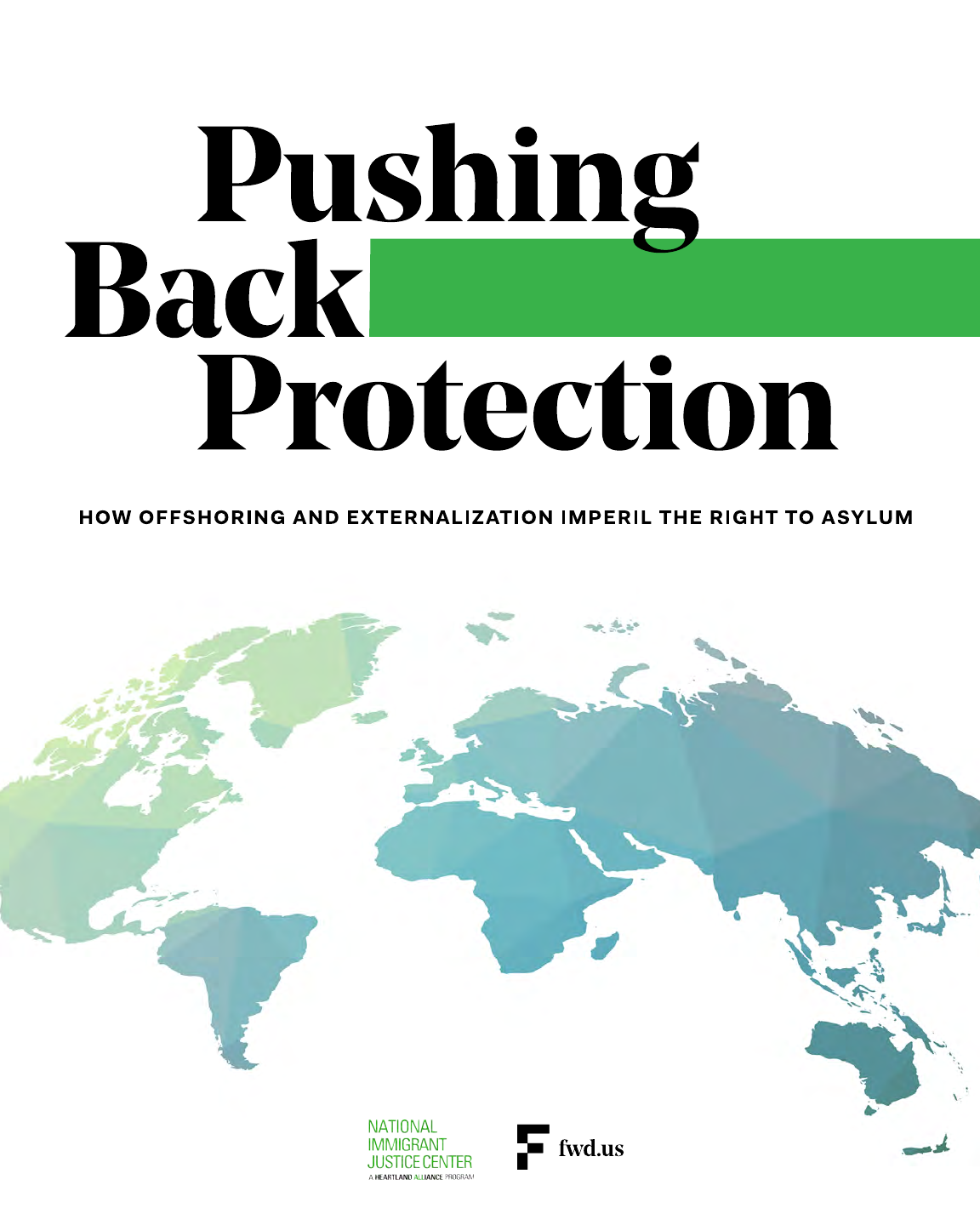

1
Pushing Back Protection: How Offshoring and Externalization Imperil the Right to Asylum
Table of Contents
Acknowledgments ...................................................................................................................................................... 2
Abbreviations & Terminology ..................................................................................................................................... 3
Introduction ................................................................................................................................................................. 7
1. Legal Vehicles For Externalization Regimes Under International Law ............................................. 9
1.1. International Refugee Regime: The Principle of Non-Refoulement ................................................................ 10
1.2. Externalization Regimes: Safe Third Country Practices .................................................................................. 11
1.3. Externalization Regimes: Outsourcing Enforcement Operations ................................................................... 14
2. The European Union And Its Member States’ Eorts to Prevent
Asylum Seekers From Reaching Their Borders ................................................................................. 17
2.1. Failure to Uphold Rights of Asylum Seekers Enshrined in EU Law ................................................................. 18
2.2. Refoulement at Sea: The EU and Italy’s Reliance on Libya to Prevent Asylum Seekers Arriving in Europe .......20
2.3. EU-Turkey Statement: Banishing Asylum Seekers to Turkey and Trapping Them on Greek Islands ........... 24
2.4. U.K. and France Border Enforcement: Raids, Surveillance, and More Deaths at Sea .................................. 27
2.5. Looking Forward: Europe’s Continued Focus on Externalization And Returns ............................................. 29
3. The Pacic Solution: Australia’s Insular Approach to Asylum Seekers ............................................ 31
3.1. Australian Push-Backs and Territorial Excision ................................................................................................ 32
3.2. From Former Colonies to Asylum Jails .............................................................................................................. 33
3.3. Impact on Asylum Seekers .................................................................................................................................. 35
4. Laying The Foundation Of U.S. Oshoring: From Angel Island to Guantánamo Bay ....................... 38
4.1. The Incipient Stage of U.S. Oshoring: Public Health as
Racial Exclusion From Angel Island to the U.S.-Mexico Border ...................................................................... 38
4.2. Guantánamo Bay: From a Naval Station to a Detention Center for Asylum Seekers ....................................40
5. Moving The Border South: The United States’ Oshoring of
Asylum Processing And Immigration Enforcement to Mexico and Central America ...................... 44
5.1. Metering And Migrant Protection Protocols: Stranding Asylum Seekers in Dangerous Border Territories ........46
5.2. Asylum Cooperative Agreements: Deporting Asylum Seekers to Unsafe Third Countries .......................... 48
5.3. Title 42 Expulsions: A Recycled Pretext for Refoulement Under the Guise of Public Health ....................... 52
6. Closing Recommendations: Learning The Lessons of Failed, Deadly,
and Costly Oshoring and Externalization Practices Across the World .......................................... 54
Endnotes ...................................................................................................................................................................... 58

2
Pushing Back Protection: How Offshoring and Externalization Imperil the Right to Asylum
Acknowledgments
This report was co-authored by the National Immigrant Justice Center (NIJC) and FWD.us.
Research for this report included a series of discussions with and/or review by regional and international
experts on asylum, refugee, and human rights policy. Expert reviews do not constitute endorsements.
We would like to thank these individuals for their time, expertise, and service to people forced to ee for
their lives around the globe. The policies and practices discussed in this report reect our research up
through July 2021.
AUTHORS
Azadeh Erfani and
Maria Garcia
COAUTHOR
Rubi Flores
CONTRIBUTORS
Marta Ascherio
Nik Evasco
Alec Kraus
Maria Rossi
REVIEWERS
Heidi Altman
Tara Tidwell Cullen
Kate Hansen
Mary Meg McCarthy
Drew Toal
EXPERT PANEL
Maddy Allen, Former Co-Head of Programmes, Choose Love
Alice Farmer, Legal Ocer, UNHCR
Bill Frelick, Director of Refugee and Migrant Rights Division,
Human Rights Watch
Andrew Geddes, Professor of Migration Studies and Director of the
Migration Policy Centre
Daniel Ghezelbash, Associate Professor, Macquarie Law School; Special
Counsel, National Justice Project; Author of ‘Refuge Lost’
Matty Gladstone, Co-Head of Programmes, Choose Love
Guerline Jozef, Executive Director and Co-Founder of the Haitian Bridge Alliance
Josephine Liebl, Head of International Advocacy at European Council on
Refugees and Exiles (ECRE)
Marie Naas, Head of Advocacy Germany and EU, Sea-Watch
CREATIVE AND DESIGN
Chell Zeng, Matt Lochman, and Teal Media

3
Pushing Back Protection: How Offshoring and Externalization Imperil the Right to Asylum
Abbreviations & Terminology
Abbreviations
ACA Asylum Cooperative Agreement
APD Asylum Procedures Directive
CDC The United States Centers for Disease Control and Prevention
CEAS Common European Asylum System
DHS Department of Homeland Security
DOJ Department of Justice
ECRE European Council on Refugees and Exiles
EU European Union
IOM International Organization for Migration
LCG Libyan Coast Guard
LGBTQ+ Lesbian, Gay, Bisexual, Transgender, Queer, and other non-normative gender or sexual identities
MPP Migration Protection Protocols, also known as “Remain-in-Mexico” program
MOU Memorandum of Understanding
NGO Non-Governmental Organization
OHCHR Oce of the United Nations High Commissioner for Human Rights
PFS Programa Frontera Sur
SAR Search and Rescue
STCA Safe Third Country Agreement
TPS Temporary Protected Status
U.K. United Kingdom
UNHCR United Nations High Commissioner for Refugees
U.S. United States

4
Pushing Back Protection: How Offshoring and Externalization Imperil the Right to Asylum
Terminology
1967 Protocol: The Protocol Relating to the Status of Refugees is the most recent United Nations
treaty on refugees. Entered into force in 1967, this treaty sought to eliminate the two limitations
placed on the 1951 Convention Relating to the Status of Refugees (discussed further below): the
temporal restriction on events happening before 1951 and the geographic limitation of events
happening in Europe. Removing those limitations expanded asylum obligations worldwide for any
country that acceded to or ratied the 1967 Protocol. The United States, Australia, and all European
Union Member States, as well as the United Kingdom, have acceded to or ratied the 1967 Protocol.
Auent nations/countries: Given the geographic scope of this report—covering asylum policies
led by the U.S., European Member States, and Australia—many common terms such as Western or
Northern nations fall short. Instead, we refer to these nations and collectives under the umbrella term of
auent nations, a short form to denote their shared status as developed, wealthy, and former colonial
powers exerting wide inuence on the rights and movement of migrants and asylum seekers. This term
does not impute wealth onto the communities or inhabitants of these nations; rather, it is a reference to
the historical, geopolitical, and economic power these nations hold at the international level.
Asylum Seeker: A person who is not yet legally recognized as a refugee, yet has ed their country of
origin (or country of habitual residence) in search of protection from serious human rights violations
and persecution.
Border Externalization: The enactment of domestic policies and bilateral/multilateral agreements
that successfully enlist other countries, usually countries in the periphery of the State in question, in
processing asylum seekers and enhancing their border controls with the ultimate goal of preventing
asylum seekers from reaching the State enacting the putative externalization policies. This practice is
discussed in further detail in Chapter 1.
Carrier Sanctions: Through signicant nancial penalties, carrier sanctions and accompanying
legislation incentivize carriers such as airlines to prohibit individuals without required travel
documents from traveling to a destination country. This practice is widely used by the auent
nations discussed in this report. For further details, see Chapter 1.
Detention: The practice of jailing or conning migrants or asylum seekers. This connement can
occur in a jail-like setting or in any location where migrants or asylum seekers’ freedom of movement
is restrained.
EU Member States: The 27 nations in the European continent that have agreed to share their
sovereignty on certain aspects of government policy with the collective bloc through the institutions of
the European Union. Since 2020, the United Kingdom is no longer an EU Member State, which allows it
to set its own migration policy and restricts the free movement of people from the EU to the U.K.

5
Pushing Back Protection: How Offshoring and Externalization Imperil the Right to Asylum
Expulsion, Deportation, Removal, or Return: These dierent terms refer to the involuntary
transfer of migrants or asylum seekers from a receiving nation’s borders to another nation—
oentimes to a neighboring country or to the country of origin of the migrant or asylum seeker.
Externalization: The practice of shiing asylum processing or border control to another nation or
territory. This practice is discussed in great detail in Chapter 1.
Extraterritorial Processing: A specic form of externalization policy which enlists a neighboring
country or territory to detain or process asylum seekers. This practice usually leads to prolonged
detention of asylum seekers and inadequate housing and living conditions.
First country of asylum: This concept aims to prevent asylum seekers who already received
adequate refugee protections in one country from applying for asylum in another country. Nations
with the rst country of asylum written into their laws bar asylum seekers from qualifying for asylum
if they already obtained it elsewhere. As explained in Chapter 1, this concept has been distorted and
expanded to also bar asylum seekers who have not received protection in a country of transit from
applying for asylum.
Jus cogens: Latin for “compelling law.” A special principle of international law where a specic
norm, or State practice, is universally adopted and no State is exempt in its enforcement—regardless
of whether that state acceded to or ratied the applicable international treaty.
Migrant: A person living outside of their country of origin due to any variety of reasons, including
asylum seekers and persons who do not t the legal denition of refugee but are unable to return to
their country of origin.
Non-refoulement: French for “non-return.” A principle of international refugee law that prohibits
any form of return (“refouler”) of refugees or asylum seekers to any country where their lives or
freedom are endangered, and where they may face persecution or torture. This term is dened in
more detail in Chapter 1.
Northern Triangle: Geographic term commonly used in the U.S. to refer to the Central American
nations of Guatemala, Honduras, and El Salvador.
Oshoring: The practice whereby countries of destination for asylum seekers transfer them to other
nations or territories, which in turn detain those individuals and/or process their claims—as well
as eectuate removals or deportations. This transfer regime eectively outsources the country of
destination’s obligations under international law and seeks to deter future asylum seekers.
Push-backs: The practice of forcing asylum seekers back to the country they just le, either at sea
through maritime interceptions or by land across the country’s border.

6
Pushing Back Protection: How Offshoring and Externalization Imperil the Right to Asylum
Reception: The initial housing and living arrangements set up for asylum seekers when arriving to
the country where they apply for asylum.
Refugee: An individual entitled to protection from persecution under international law prior to their
entry in their country of destination. Unlike asylum seekers, refugees are processed outside the
countries where they ultimately resettle. In turn, nations that resettle refugees exercise control over
which refugees they select, the number of refugees they admit, and the manner and timing of their
entry.
Refugee Convention: The Convention Relating to the Status of Refugees, a United Nations
multilateral treaty signed in 1951 at Geneva, which sought to dene who qualies as a refugee
and the rights and protections States must oer them. This treaty was a response to the lack of
protections oered by the international community to Jewish refugees eeing the Holocaust
during World War II. Though it only applied to persons eeing Europe who were aected by events
taking place before 1951, the Refugee Convention provided the foundational framework of asylum
protection operative in the 1967 Protocol and to-date, including the principle of non-refoulement.
Refugee Transfer: The practice of transporting asylum seekers to third countries as delineated
by bilateral/multilateral agreements, with the presumed intention of ensuring the asylum seeker in
question can seek protection in the recipient country, though these safeguards in practice oen do
not exist. This practice is discussed further in Chapter 1.
Safe third country concept: Part of safe country practices today, a concept that allows the transfer
of asylum seekers from one State to another on the condition that the receiving State is safe and can
aord them adequate protections commensurate with international standards. Recently, the concept
has been used, controversially, to allow transfers of asylum seekers back to countries through which
they transited en route to auent nations. This practice is discussed further in Chapter 1.
Title 42: A short term referencing 42 U.S.C. § 265 of the Public Health Service Act of 1944, which
was intended to provide U.S. health authorities with the ability to quarantine individuals entering the
country. As of March 2020, the CDC used Title 42 to restrict migration at the U.S. border under the
guise of preventing the spread of the COVID-19 pandemic. This novel use of Title 42 has ushered in
nearly one million summary expulsions. This practice is discussed further in Chapter 5.
Tracking/Smuggling: The unlawful trade or commerce of transporting adults or children from
one country to another. Transported asylum seekers oen fall prey to serious dangers, as they
attempt to avoid closed or militarized migration routes. As discussed in this report, many oshoring
or externalization practices are implemented under the guise of curbing tracking; however, those
practices oen accentuate the dangers faced by migrants and asylum seekers and embolden
tracking networks.
Vacatur: Latin for “it is vacated.” It is a court decision where a previous ruling or a current law is
nullied or invalidated.

Pushing Back Protection: How Offshoring and Externalization Imperil the Right to Asylum
7
In the past few decades, affluent countries have ramped up efforts to halt migrants from
reaching their shores, even when fleeing life-threatening harm.
European Union Member
States, Australia, and the United States are increasingly adopting policies that push asylum seekers
from non-white majority nations away from their borders in order to deny them their lawful right to
seek asylum. This places the responsibility of asylum processing and the granting of protections on
other nations through practices oen referred to as oshoring or externalization.
The 1951 Convention relating to the Status of Refugees (“Refugee Convention”)
1
and the 1967
Optional Protocol relating to the Status of Refugees (“1967 Protocol”)
2
dened individuals’ right
to seek refuge. One of the core principles of these international instruments and the subsequent
Convention Against Torture is that of non-refoulement. Non-refoulement prohibits the return of
asylum seekers to territories where their lives are at risk. Throughout the world, nations are required
not to violate non-refoulement, a principle born out of the atrocities that resulted from denying safe
haven to World War II refugees, including Jewish refugees eeing the Holocaust, and forcing them
to return to territories where they faced almost certain genocide. Many prominent nations codied
this principle in their own domestic laws, in honor of the moral and legal imperative to protect the
right to asylum. However, recent decades have seen an uptick in policies and practices that seek
to circumvent non-refoulement, ooading obligations onto less prosperous nations and sealing
auent nations’ borders from asylum seekers.
This report provides an overview of the legal vehicles that result in such ooading (Chapter 1),
and then explores their harmful real-world consequences in three regional case studies. From the
establishment of immigration enforcement proxy forces and o-site detention centers to the careful
brokering of bilateral and multilateral agreements, the European Union and its Member States
(Chapter 2), Australia (Chapter 3), and the United States (Chapters 4-5) have carefully craed
policies designed to evade international obligations and oversight. While pushing processing and
enforcement onto other nations, these auent nations have underinvested in their own domestic
asylum systems, closed o their borders to asylum seekers, and poured millions of dollars into other
countries’ enforcement and migrant detention systems. In some instances, litigators have succeeded
Introduction
Recent decades have seen an uptick in policies and practices that seek to circumvent
non-refoulement, offloading obligations onto less prosperous nations and sealing
affluent nations’ borders from asylum seekers.

Pushing Back Protection: How Offshoring and Externalization Imperil the Right to Asylum
8
in holding states accountable for push-backs orchestrated outside their territory,
including in international waters. Unfortunately, rather than ending these
practices, auent nations have sought to work around legal ndings, forging
new ways to externalize and oshore, regardless of the human consequences.
Auent countries have worked to make conditions so abhorrent as to deter
asylum seekers from reaching their territory; those who do are either detained
or repudiated to another state, far away. As a result, asylum seekers are
subjected to punitive policies that leave them stranded, isolated, and vulnerable
to violence, including rape, torture, and death. Despite the continued cycle of
cruelty inicted on these individuals, deterrence policies have not worked. A
17-year-old Algerian asylum seeker, sleeping under a bridge in the northern
French border town of Calais, spoke to the ineectiveness of this approach, as
well as its cruelty: “Their strategy is to weaken us. But if everything was ne in
our countries, we wouldn’t have le. We don’t have the choice.”
3
“Their strategy
is to weaken us.
But if everything
was fine in our
countries, we
wouldn’t have
left. We don’t
have the choice.”
—17-year-old
Algerian asylum
seeker sleeping
under a bridge in
Calais, France.
4
Externalizing and oshoring practices would not exist but for a systematic
failure to learn the damage they have caused across the world. These policies’
history of failure is symptomatic of a broken outlook on asylum rights—one that
smears asylum seekers as “trackers,” “queue-jumpers,” or “criminals.” And
yet, oshoring policies embolden the very tracking networks policymakers
claim they seek to dismantle. Politicians talk about the need for asylum seekers
to “come the right way,” ascribing fault to asylum seekers for seeking protection
at what they label inconvenient times or places. Meanwhile, these powerful
nations attack and obstruct existing migration pathways, while falsely painting
asylum seekers as national security and public health risks. As long as auent
nations approach migration and protection from a deterrence perspective,
the rights of vulnerable people will suer and eorts to create humane and
eective asylum processing systems will stumble.
The cycle of brokered deals to oshore asylum seekers and externalize border
enforcement must end, in favor of a new era where auent nations champion
rather than erode the principle of non-refoulement. As a primary architect
of oshoring and externalizing borders, we call on the U.S. to assert
leadership in charting a new course. Our closing recommendations
in Chapter 6 provide seven key principles to dismantle these harmful
practices once and for all. Tragically, although the Biden administration has
reversed some of the harsh Trump-era deterrent policies, the United States
continues to expel asylum seekers or otherwise prevent them from reaching its
borders. New agreements with Mexico and Central America alarmingly echo
oshoring and externalization tactics deployed by prior administrations.
5
The
United States can and must come into compliance with its obligations of non-
refoulement, at its borders and beyond.

Pushing Back Protection: How Offshoring and Externalization Imperil the Right to Asylum
9
The codification of asylum protections in domestic and international law is a relatively
recent development.
Though eeing from persecution is not new, modern nation states historically
adopted blanket policies that ignored the specic vulnerability of forced migration. This late
reckoning had tragic consequences. During World War II, tens of thousands of Jewish children,
adults, and families eeing the Holocaust were turned away by the U.S., ostensibly because they
were viewed as a threat.
6
This response resulted in a death sentence for many of these individuals.
By the second half of the 20th century, consensus arose in the international community that turning
back asylum seekers only compounded the atrocities which they ed.
7
As a result, international
refugee law was established with the adoption of a series of treaties and regional legal agreements
that standardized who qualied as a refugee, and which codied their rights and benets.
In recent decades, however, many countries have sought to seal their borders to asylum seekers and
systematize push-backs to third countries. These actions represent a concerted eort by prominent
auent nations to externalize their border enforcement and asylum obligations to neighboring
countries, so as to physically prevent people from reaching their territories and apply for asylum.
Concurrently, these nations have begun dismantling their own domestic processes to receive and
process asylum seekers.
Typical vehicles for systematized push-backs include refugee-transfer and border-externalization
agreements. With transfer agreements, nations seek to displace responsibility for asylum processing
onto neighboring countries. Despite substantial cash infusions and inated promises from the
transferring nation, conditions in the transferee nation usually fall far short of the safety and
protections required for third-country transfers under international law. With border externalization,
these auent nations try to stop asylum seekers before they reach their borders by brokering
deals with neighboring countries and private companies to act as proxy border agents. From a
legal standpoint, these policies are legally dubious at best, and blatant violations of international
law at worst. From a humanitarian standpoint, these costly agreements and policies have caused
unimaginable human suering and loss.
CHAPTER 1
Legal Vehicles for Externalization
Regimes Under International Law
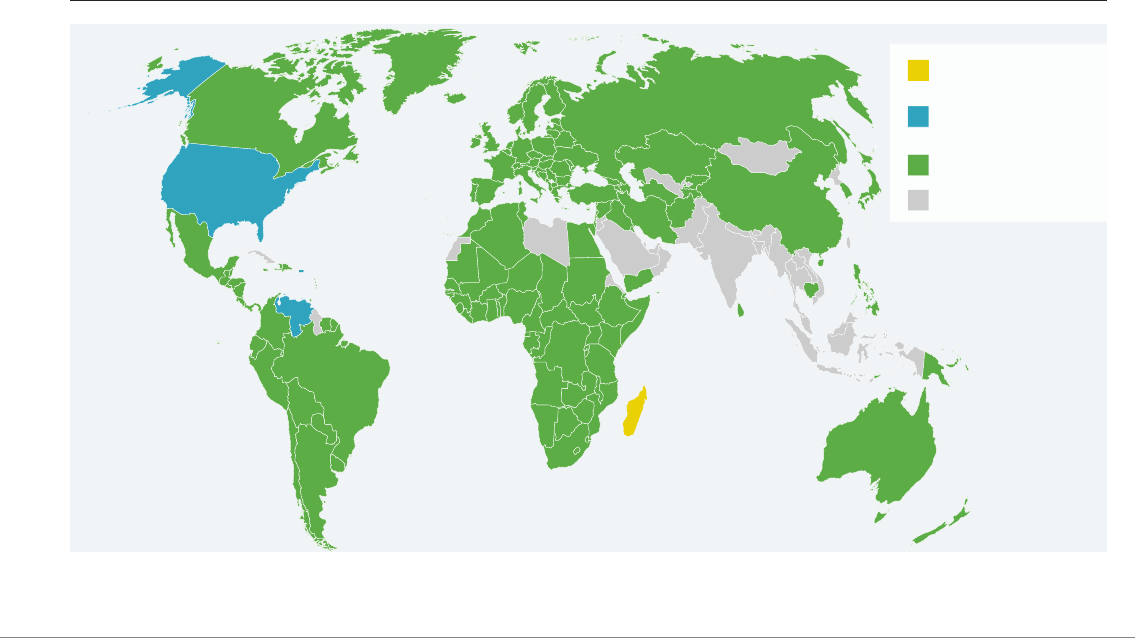
Pushing Back Protection: How Offshoring and Externalization Imperil the Right to Asylum
10
1.1. International Refugee Regime:
the Principle of Non-Refoulement
Protections for asylum seekers are enshrined through various international and regional agreements
and treaties. Article 14(1) of the 1948 Universal Declaration of Human Rights provides that “everyone
has the right to seek and to enjoy in other countries asylum from persecution.”
8
Other regional
agreements and human rights conventions also arm the right for persons to seek refuge by
addressing rights such as life, freedom from torture, liberty, security, and freedom of movement.
9
The two most foundational international instruments that spell out a protection framework for asylum
seekers are the Refugee Convention
10
and the 1967 Protocol which removed geographical and
temporal restrictions on protection included in the original Convention.
11
States which ratify these
treaties must provide certain protections and rights to individuals determined to t the denition
of a refugee. Among these rights are the right to family life, equal justice, freedom of movement
(including freedom to leave their country of nationality and freedom of movement within a host
country), and, most importantly, the right of non-refoulement.
12
The principle of non-refoulement
prohibits States from returning (“refouler”) an asylum seeker “in any manner whatsoever,” including
“deportation, expulsion, extradition, informal transfer or ‘renditions,’ and non-admission at the
border,” “to the frontiers of territories where his [or her] life or freedom would be threatened on
account of his [or her] race, religion, nationality, membership of a particular social group or political
opinion.”
13
Importantly, nations do not only violate non-refoulement by pushing asylum
seekers back to their country of persecution; refoulement is also operative with expulsions
or deportations to third countries where asylum seekers’ lives or freedom is endangered.
Parties to the Refugee Convention, the 1967 Protocol and non-members.
Image Credit: UNHCR https://www.unhcr.org/protect/PROTECTION/3b73b0d63.pdf
Parties to both
Parties to only the
1967 Protocol
Parties to only the 1951
Refugee Convention
Non-members

Pushing Back Protection: How Offshoring and Externalization Imperil the Right to Asylum
11
By design, the principle of non-refoulement acts as a rewall to shield asylum seekers from harmful
roll-backs of protection at the domestic or regional level. Some prominent legal scholars in fact
claim that the principle of non-refoulement is a suciently established norm as to be considered
peremptory or jus cogens, that is, a norm that is universally accepted in the international community
and whose enforcement is mandatory. As such, any multilateral, bilateral, or domestic policy that
violates a jus cogens norm is subject to vacatur in both domestic and international courts.
14
If non-
refoulement of asylum seekers is considered jus cogens, states do not have the discretion to apply
the principle in a selective manner. UNHCR states that non-refoulement is “progressively acquiring
the character of a peremptory rule of international law”
15
and “is not subject to derogation.”
16
Nevertheless, auent nations have attempted to evade scrutiny through legally dubious agreements
that transfer asylum seekers to other countries.
1.2. Externalization Regimes: Safe Third Country Practices
Under international law, there is no requirement for asylum seekers to seek protection in the rst
country they encounter. However, in recent decades, some nations have campaigned to retroactively
impose this requirement through domestic law and regional agreements. While there are 148 nations
party to either or both the Refugee Convention and the 1967 Protocol,
17
it has become increasingly
commonplace for countries to adopt more restrictive migration regimes, including programs meant
to prevent asylum seekers from reaching their borders. One set of common restrictive practices
includes programs aimed at returning or transferring asylum seekers to third countries through
bilateral agreements, commonly referred to as Safe Third Country Agreements (STCAs). Initially, such
laws and agreements were touted as ways to promote sharing the responsibility for processing and
granting asylum. However, they are far more regularly used with the intent to deter migration from
particular parts of the world and to ooad asylum processing.
Crucially, there is no settled consensus on the legality of such agreements under international
law.
18
The origins of safe third country practices arguably began with the 1989 Conclusion by the
UNHCR Executive Committee,
19
which sought to prevent the irregular migration of individuals who
had already received refugee protections but wanted to receive protections elsewhere.
20
The 1989
Conclusion delineated what is known today as the “rst country of asylum” principle, which was
meant to apply only to individuals who had already received asylum protections and never to people
who merely transited through another State en route to their nal destination. In fact, an earlier UNHCR
Executive Conclusion from 1979 clearly articulated that asylum could not be denied “solely on the
ground that it could be sought from another State.”
21
While the 1989 Conclusion was quite narrow, some States broadened its scope when entering
into STCAs.
22
With the “safe third country” principle, States argued that they could transfer asylum
seekers to another country which could have aorded them similar protections, including to countries
of transit or to countries with which a transfer arrangement was struck. They rst came into use under
national laws and bilateral and multilateral refugee agreements. The Illegal Immigration Reform
and Immigrant Responsibility Act of 1996 (IIRAIRA), for example, amended U.S. asylum law to add

Pushing Back Protection: How Offshoring and Externalization Imperil the Right to Asylum
12
safe third country agreements,
23
though until 2019 there was only one such bilateral agreement,
with Canada,
24
which has since been subject to litigation. The Trump administration stretched this
concept further, brokering agreements with Central American countries to transfer asylum seekers
apprehended at its borders. In Europe, the Asylum Procedures Directive and the EU’s Dublin
Regulation purported to formalize safe third country concepts within the EU and beyond.
25
States that deployed such transfer agreements claimed that the legal authority for such actions rests
on the assumption that individuals had already received refugee protections or could have sought
them in another country.
26
Yet, the legal concepts of “safe third country” or even “rst country of
asylum” are nowhere to be found in the actual text of the Refugee Convention or the 1967 Protocol.
27
Some nations have exploited this vacuum to create a parallel externalization regime.
Another legal justication for transfer agreements arose from a faulty interpretation of the Refugee
Convention itself. Restrictionist policymakers have wrongly utilized Article 31(1) of the Refugee
Convention to justify refugee-transfer agreements by focusing on two words: “coming directly.”
28
The article reads: “The Contracting States shall not impose penalties, on account of their illegal
entry or presence, on refugees who, coming directly from a territory where their life or freedom
was threatened in the sense of article 1, enter or are present in their territory without authorization,
provided they present themselves without delay to the authorities and show good cause for their
illegal entry or presence.” In other words, Article 31 calls upon states not to impose harsh conditions
like detention or criminal prosecution for the mere act of seeking refuge; it does not narrow the
eligibility criteria for prospective asylum seekers on the basis of their travel route. Nonetheless,
policymakers transplanted these two words to another context: the eligibility criteria for asylum
protections, requiring asylum seekers to apply for refugee status in the rst country that could have
oered them refugee protections aer eeing persecution.
29
This interpretation would insulate many
auent countries from receiving asylum seekers from non-neighboring countries, repeating the
inhumane World War II policies of returning boats full of refugees to harm.
The UNHCR has proposed guardrails to prevent States from implementing agreements using
safe third country principles that limit protections for asylum seekers.
30
The 2002 UNHCR Lisbon
Expert Roundtable specied that there is no mandate under international law for refugees “to seek
international protection at the rst eective opportunity.”
31
Still, they conceded that refugees did not
“have an unfettered right to choose the country” of asylum, and sought to establish conditions that
must be met in order to ensure the best interest of refugees through guidance notes and conclusions
documents from their Executive Committee. UNHCR also produced guidelines encouraging transferring
States to ensure the transferee country be party to the Refugee Convention and 1967 Protocol
The legal concepts of “safe third country” or even “first country of asylum” are nowhere
to be found in the actual text of the Refugee Convention or the 1967 Protocol. Some
nations have exploited this vacuum to create a parallel externalization regime.
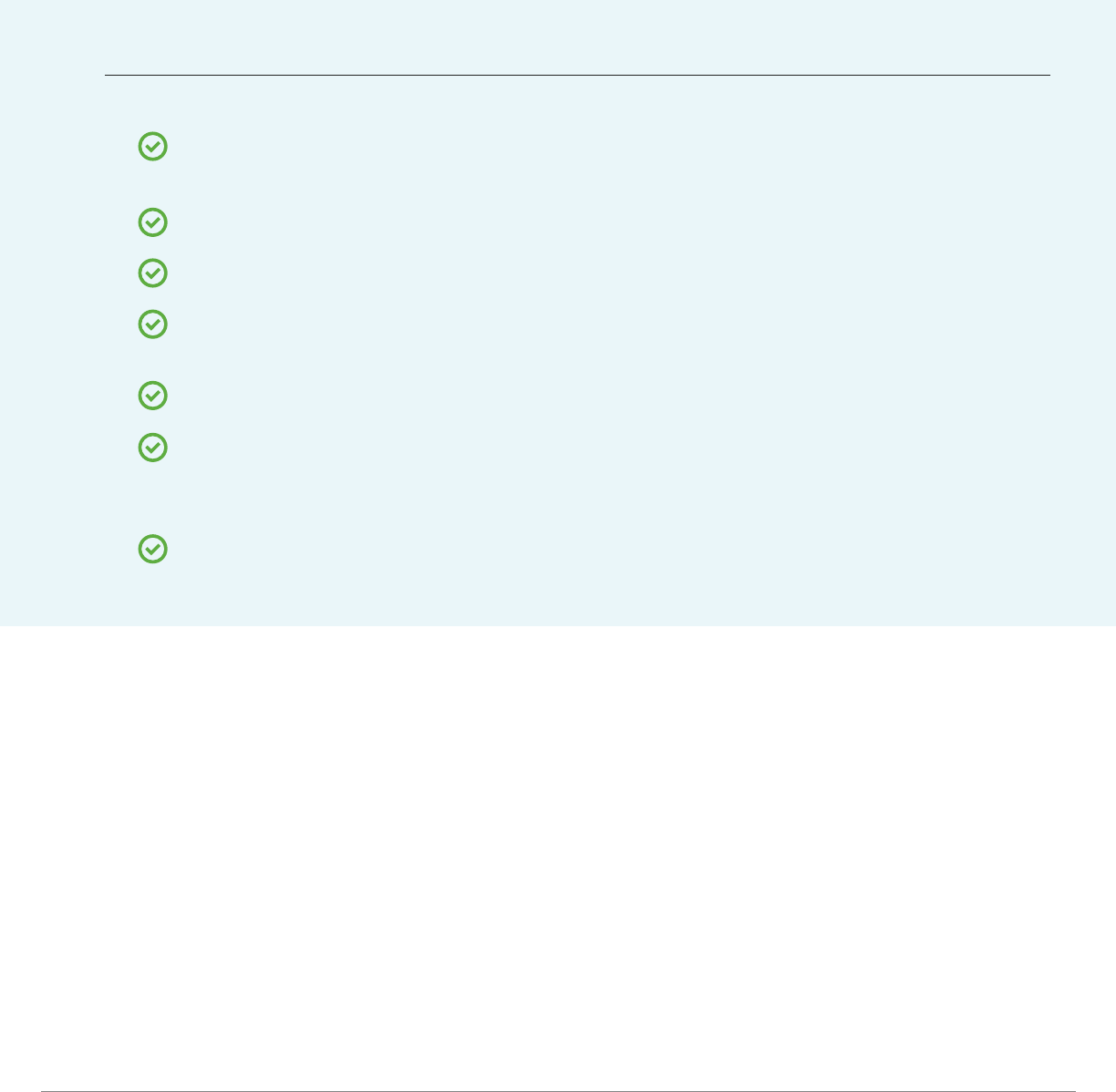
Pushing Back Protection: How Offshoring and Externalization Imperil the Right to Asylum
13
(or adhere to commensurate protections); that States codify such agreements under legally-
binding treaties able to be enforced and reviewed under legal scrutiny; and, that States maintain
responsibility for the rights of refugees even aer being transferred (at minimum the obligation of
non-refoulement of the refugee in question).
32
In addition, the UNHCR instructs States to provide
guarantees to each asylum seeker that would be resettled, including those outlined below.
33
UNHCR Guidelines and Legal Considerations for the Transfer of Asylum Seekers to Safe Third Countries:
34
Individually assessed, including a continuous review, as to the
appropriateness of a transfer
35
Permitted entry into the receiving State
Protection against refoulement
A fair and ecient asylum process in the receiving country that adheres to
international standards
Allowed to remain in the receiving State during the time of adjudication
Living conditions and treatment in line with international standards, including
adequate reception conditions, access to health, education, basic services,
self-reliance and employment, as well as protection from arbitrary detention
If protection need is established, provided with asylum status or long-term,
lawful status in line with the Refugee Convention
As the next Chapters demonstrate, few if any agreements discussed in this report implement
these threshold requirements and guidelines. What’s worse, these agreements allow some
policymakers to misrepresent asylum seekers as opportunists, and fault transit countries for
not restricting their travels.

Pushing Back Protection: How Offshoring and Externalization Imperil the Right to Asylum
14
1.3. Externalization Regimes: Outsourcing
Enforcement Operations
Another tactic frequently used alongside externalization is that of preventing asylum seekers from
ever reaching an auent nation’s borders. This tactic plays out in two ways. First, some auent
nations task countries of transit with halting, detaining, or pushing back asylum seekers before
they reach their destination. Second, some nations enlist private companies to perform the duties
of border agents, imposing sanctions on corporations that allow the entry of asylum seekers
without visas. This, in turn, incentivizes companies to incorporate migration control into their daily
operations. This public and private outsourcing ultimately shis auent nations’ borders far from
their physical territory, and forces asylum seekers to turn in desperation to more dangerous transit
routes.
Outsourcing policies have been implemented throughout Europe and North America.
Intergovernmental agreements aimed at propping up the border controls of countries of transit were
established in recent years between Spain and Morocco and Italy and Libya.
36
These agreements,
however, plainly enlist transit countries as border guards in exchange for money. The primary intent
of these agreements is the deterrence of asylum seekers, and routine human rights violations are
their inevitable byproduct.
In 2012, Italy’s practice of intercepting migrants rescued at sea was brought to the European Court
of Human Rights, resulting in a landmark decision halting the practice and deeming it illegal.
37
In Hirsi Jamaa and Others v. Italy, the Court considered the legality of the Italian Coast Guard’s
2009 actions in intercepting more than 200 individuals who had departed Libya, and transferring
them to Italian military vessels that returned them to Tripoli.
38
These individuals were unable to
identify themselves and formally ask for protection. The Court held that Italy had failed to protect
the migrants’ rights and freedoms under the European Convention on Human Rights by putting
the plaintis at risk of abuse in Libya and of being returned to Somalia or Eritrea where they had
originally ed.
39
The court found that even though the event took place outside of Italy’s territory,
Italy had exercised control over these asylum seekers who were “under the continuous and exclusive
de jure and de facto control of the Italian authorities,” and therefore were under Italian jurisdiction.
40
Consequently, the state was obligated to secure their rights and freedom pursuant to Article 1
Section 1 of the European Convention on Human Rights.
The Hirsi Jamaa decision represents a rare glimmer of accountability for non-refoulement violations
under European law. Unfortunately, Italy circumvented the decision by striking a deal with Libya
through a Memorandum of Understanding wherein Italy provides support to Libyan maritime
ocials to intercept and return asylum seekers to detention facilities in the country.
41
In essence, the
Italian government sought to establish a proxy force in Libya that could physically carry out the same
operations, while skirting legal scrutiny.

Pushing Back Protection: How Offshoring and Externalization Imperil the Right to Asylum
15
Across the Atlantic in 2014, the United States also sought foreign assistance to substantially reduce
the number of individuals arriving at its borders in response to the rise of asylum seekers eeing
widespread violence in Central America.
42
The U.S. sought to increase Mexico’s enforcement
capabilities at the border and its interior.
43
Once again, the inherent goal of U.S. policy was to
decrease the number of asylum seekers who would be able to reach the border in the rst place.
Since the 1960s, Mexico had been the country of origin for most migrants reaching the U.S., yet
it became a country of transit around 2013 when more than a quarter of a million non-Mexican
asylum seekers were apprehended at the U.S.-Mexico border.
44
As a result, the Mexican government
implemented a plan to strengthen its border-enforcement capabilities through the Programa
Frontera Sur (PFS). While this was not the rst such program, the PFS program specically sought
to curb migration at Mexico’s southern border at the behest of the U.S., and with direct monetary
assistance.
45
U.S. funding came primarily from the Merida Initiative, a program that started in
2008 with the aim of curbing organized crime in the region. Quietly conating migration control
and crime prevention, the U.S. transferred $200 million of the Merida Initiative funds toward the
PFS.
46
Consequently, there has been a dramatic increase in the militarization of Mexico’s southern
border and creation of “control belts” of interior enforcement that target common routes for asylum
seekers, such as the freight trains known as “la bestia.” These mechanisms only led migrants to nd
more dangerous routes north without any signicant impact on the trade of illicit goods, one of the
program’s original aims.
47
Mexico’s National
Guard at a
checkpoint in
Tapachula in
southern Mexico,
June 2019.
Image licensed via Reuters Pictures

Pushing Back Protection: How Offshoring and Externalization Imperil the Right to Asylum
16
In addition to outsourcing enforcement mechanisms to perimeter and southern governments,
auent nations have enlisted private corporations to prevent asylum seekers from reaching their
territories at the point of embarkation. Legislation turning private carrier companies, such as airlines
and other vessels, into de facto immigration enforcement agents
48
was widely adopted in the second
half of the twentieth century. Under carrier sanction legislation in countries in Europe, Australia,
and the United States,
49
private carriers are incentivized to block asylum seekers from boarding
vessels such as planes through signicant nancial penalties. Penalties include bearing the cost
of deporting individuals, covering related expenses including accommodation or detention, and
additional nes.
50
As a result, private carrier companies bar asylum seekers, who frequently lack
required travel documents, from safely reaching their country of destination and seeking refuge. This
privatization of migration control yields another benet for states eager to circumvent the principle of
non-refoulement; because carriers are private companies and non-state actors, it is dicult to prove
that their actions fall under the jurisdiction of the state, even if they are acting on behalf of said state.
Carrier sanctions drive asylum seekers into the hands of the very tracking networks these policies
are purported to stop. In many cases, asylum seekers cannot obtain the state-issued documentation
required by the private carrier, particularly when the state is the persecuting actor from which they
are eeing. For example, a Black asylum seeker from Mauritania—the country with the highest rate
of slavery in the world—may not be able to provide a passport or obtain a visa to present to an airline
due to the fact that Black Mauritanians are not recognized
51
as citizens by their government. In this
example, carrier sanction legislation would push Black asylum seekers from Mauritania back to their
persecutors and leave them particularly vulnerable to smuggling networks.
Oen masquerading as human rights protections, externalization regimes permit auent
nations to circumvent the core principle of non-refoulement. As Chapters 2-5 show,
European Union Member States, Australia, and the United States have created such
regimes, which violate their domestic and international obligations toward asylum seekers.

Pushing Back Protection: How Offshoring and Externalization Imperil the Right to Asylum
17
CHAPTER 2
The European Union and its
Member States’ Efforts to
Prevent Asylum Seekers from
Reaching their Borders
“Before the departure, some of the migrants told me that they had dreams.
They were simple dreams. They just wanted to have a normal life. But instead
of being able to pursue their dreams in their own country, they had to choose
the path of exile. For them, it was the only solution. [...] When a European is the
victim of a tragedy, the whole world mobilizes, but when hundreds of Africans
drown, nobody seems concerned. Is humanity’s conscience dead?”
— Asylum seeker from Sudan who survived a shipwreck in the Mediterranean on April 22, 2021.
52
After colonizing most of Africa, the Middle East, and Asia, and leaving many countries in
crisis, European Union Member States often work diligently to prevent migrants from
reaching their shores.
53
Europe’s policies have had ripple eects, displacing countless people and
driving them from their homes in search of protection. In 2015, more than one million people seeking
refuge arrived in Europe,
54
forcing the EU to confront its broken migration and asylum system.
55
In Jean Raspail’s racist dystopian 1973 novel, “The Camp of the Saints,” Raspail depicts the arrival
of Black and Brown refugees in France as an apocalyptic invasion of the Western world. Although
far-right gures in Europe and the U.S. have previously used the book as a propaganda tool, it was
catapulted to the world stage in 2015 by anti-immigrant and white nationalist gures such as Steve
Bannon and France’s Marine Le Pen. Le Pen used the depictions in Raspail’s work to conjure up
anti-immigrant racial animus toward asylum seekers arriving in Europe, warning of a “real migratory
submersion.”
56
Although the National Rally leader would later lose the French Presidential race to
Emmanuel Macron,
57
other campaign outcomes across Europe culminated in the United Kingdom

Pushing Back Protection: How Offshoring and Externalization Imperil the Right to Asylum
18
leaving
58
the EU, Hungary’s far-right Prime Minister Viktor Orban winning his third term in oce,
59
and the rise of far-right parties all over Europe.
60
The rise of far-right, nationalist, and anti-immigration parties in Europe as center-right parties nd
themselves in disarray has been disastrous.
61
Even though public attitudes toward immigration in
many European countries did not worsen during this time, mainstream political parties capitulated
to the demands of the far-right and frequently adopted their anti-migration policy proposals.
62
The
EU and its Member States increasingly focused on migration prevention and externalization, despite
vowing to implement non-refoulement policies throughout the bloc.
In recent years, Europe strove to close every route to its territory. Encouraged by EU Member
States,
63
Western Balkans countries began to restrict travel through their borders in 2016, shutting
out asylum seekers attempting to travel on land to interior countries in northern Europe.
64
This
pushed many asylum seekers into more dangerous routes on land along the Western Balkans route,
or by sea through the Mediterranean and Aegean seas. As discussed below, European nations
then moved to block these routes altogether: EU Member States reached a deal with Turkey to
deport “irregular” migrants to the neighboring nation, while Italy enlisted Libya to push back asylum
seekers arriving via the Mediterranean. But these externalization and outsourcing practices were not
exclusive to Europe’s eastern and southern entry points, as illustrated by the brutal demolition of a
refugee camp in northern France in 2016.
2.1. Failure to Uphold Rights of Asylum Seekers
Enshrined in EU Law
EU law incorporated the Refugee Convention’s core principle of non-refoulement in the European
Convention on Human Rights
65
via the EU Charter of Fundamental Rights.
66
However, the EU has
increasingly permitted Member States to impose limitations on the principle through externalization
regimes—both within EU territory and beyond. These measures have put the rights of asylum
seekers at risk and drawn scrutiny in courts.
In 1999, EU Member States agreed to streamline the processing of asylum claims by building
a Common European Asylum System (CEAS) based on the Refugee Convention and the 1967
Protocol.
67
Though Member States retain discretion as to implementing asylum policies,
the CEAS
framework provides a minimum standard of treatment for asylum seekers including their registration,
reception (where they are initially housed), and the processing of their applications.
68
Directives
and regulations addressing minimum standards for asylum seekers, including their treatment, and
the sharing of nancial and processing responsibility were subsequently adopted by the EU. These
include the 2003 Dublin Regulation and the 2005 Asylum Procedures Directive (APD) as well as their
subsequent amendments.
69
These policies have provided the framework for some European Union
Member States to further insulate themselves from perimeter countries and the African, Asian, and
Middle Eastern asylum seekers arriving at their borders.

Pushing Back Protection: How Offshoring and Externalization Imperil the Right to Asylum
19
In theory, the APD and the Dublin Regulation were designed to share asylum processing responsibility
among EU Member States. In practice, however, these procedures codied safe third country concepts
within the EU, placing the collective burden on external border countries to process arriving asylum
seekers and provide asylum. While the APD provides certain due process guarantees, including the
right to a lawyer and an appellate process,
70
it also allows Member States to apply “safe third country”
concepts in processing of asylum claims, provided protections are in accordance with Refugee
Convention standards.
71
The Dublin Regulation also relies on these concepts when determining which
European Union country is responsible for processing an asylum claim. An increase in the numbers of
arriving asylum seekers in 2014 and 2015 exposed basic vulnerabilities in this refugee-transfer model,
including disputes among Member States regarding sharing asylum processing responsibility, overly
lengthy procedures, and poor reception conditions for vulnerable people.
The Dublin Regulation requires one fair examination of an asylum application within the European
Union, operating on the assumption that asylum practices in each country adhere to the same
common standards.
72
Under the agreement, certain criteria are applied in the examination process
of an asylum claim in order to determine if an asylum seeker will remain in the EU country they are
currently in, or if a Member State is to initiate a “transfer” request of that asylum seeker to another
Member State. Family reunication is supposed to be the rst criterion for determining which EU
country is responsible for processing an asylum claim,
73
but many Member States do not follow this
standard and, instead, Dublin “transfers” are usually initiated when secondary movement is detected
or where an individual is found to have traveled through another country before reaching the country
where they are requesting asylum.
74
In practice, the Dublin Regulation exposes asylum seekers to human rights abuses, including
indenite detention, family separation, and delays in access to protection.
75
The regulation forces
already vulnerable people to wait for long periods of time in limbo without substantive appeals
processes while EU Member States determine and agree on responsibility.
There are a number of reasons why asylum seekers oen attempt to travel from European external
border states such as Greece and Italy to interior countries like Germany, France, and the United
Kingdom: in order to reunify with family members, or to have access to the labor market, housing,
legal aid, and other direct services. Further, because external border countries within Europe
are oen the rst countries through which asylum seekers transit, they may be responsible for
processing and providing protection to more individuals than other destination Member States.
76
As
a result, asylum seekers may attempt to bypass these countries in order to avoid prolonged detention
and ensure that they have access to fair asylum proceedings.
This imbalance was only exacerbated
with the increase in migration in 2014 and 2015, as this broken system for processing asylum
seekers fell apart and harsh deterrent policies were expanded upon.
In practice, the Dublin Regulation exposes asylum seekers to human rights abuses,
including indefinite detention, family separation, and delays in access to protection.
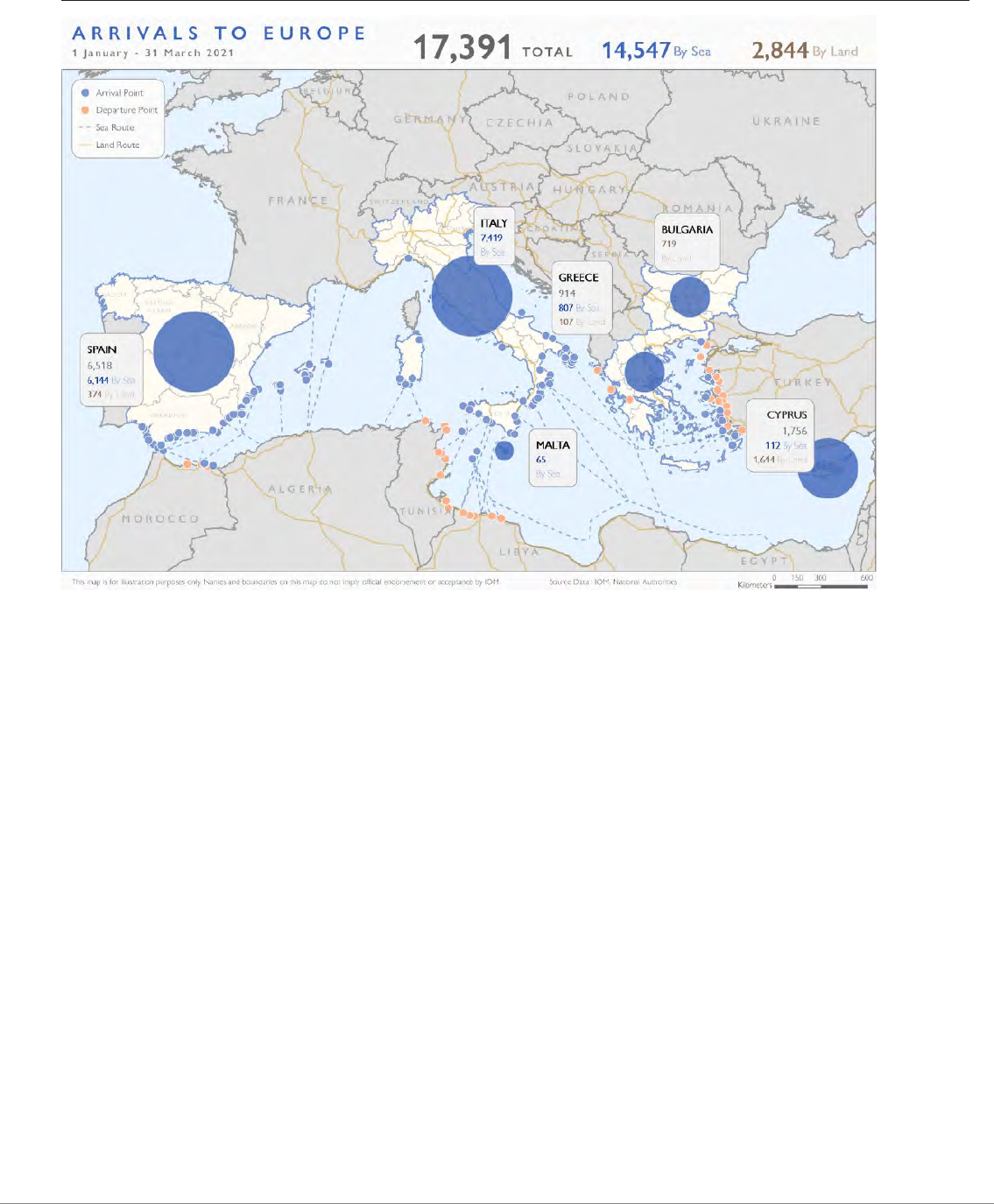
Pushing Back Protection: How Offshoring and Externalization Imperil the Right to Asylum
20
2.2. Refoulement at Sea: The EU and Italy’s Reliance on
Libya to Prevent Asylum Seekers Arriving In Europe
For many asylum seekers, simply arriving in Europe and requesting asylum is becoming increasingly
impossible, particularly for those who are pulled or pushed back to harm in the Mediterranean. Due
to its location, Italy frequently becomes the default European gateway for asylum seekers from Sub-
Saharan African countries, who arrive by sea on dangerous and overloaded boats. Rather than rise to
the humanitarian challenge, Italy and the EU have accelerated their eorts to halt arrivals and push
asylum seekers away from Italian ports.
77
Aer the European Court of Human Rights’ Hirsi Jamaa
and Others v. Italy decision created a legal barrier which prevented Italy from pushing back asylum
seekers physically, Italy enlisted Libya to act as a border enforcement proxy. Under a Memorandum
of Understanding rst signed in 2017,
78
Italy and the EU have provided training, equipment,
and additional support including a total of more than 500 million Euros to Libya, with the goal of
preventing migration to the shores of Europe.
79
Most notably, Italy and the EU’s eorts have gone
toward the recruitment, training, and nancing of the Libyan Coast Guard (LCG). The building up of
the LCG, which in some instances involved recruiting coast guard ocials from smuggling networks,
has resulted in human rights violations and deaths at sea, revealing just how far EU Member States
will go to prevent migration from the continent of Africa to Europe.
80
External border states within the EU who are recipients of the largest share of arrivals
Image Credit: IOM’s DTM Europe, Europe — Mixed Migration Flows to Europe, Quarterly Overview (January – March 2021)

Pushing Back Protection: How Offshoring and Externalization Imperil the Right to Asylum
21
40,000 people
including children
pulled back to
Libya in the first
three years of its
agreement with
Italy.
81
In the rst three years of the agreement, at least 40,000 people, including
children, were intercepted at sea and pulled back to Libya, where they faced
indenite detention and human rights abuses, including torture and slavery.
82
The same year the MOU was reached, CNN published a report exposing the
auctioning of migrants in Libya into enslavement.
83
Nevertheless, Italy renewed
its Memorandum of Understanding on Migration with Libya in 2020,
84
without
any amendments.
85
Historically, the European Union and Italy’s use of Libya as a proxy border
control agency predates this formal agreement. Libya is a primary transit
country for asylum seekers from the continent of Africa.
86
Asylum seekers
frequently ee war, conscription, and violent conict, including state
sanctioned violence and slavery, layered upon economic destitution. In
the aermath of colonialism and the carving up of the continent of Africa,
Europe—and Italy in particular enlisted Libya to prevent asylum seekers from
arriving at their shores.
87
In 2008, Italy reached a deal with Colonel Muammar
al-Gadda pursuant to which Italy paid Libya $5 billion over the course of 20
years in recognition of damage done to Libya by Italy during the colonial era.
88
In exchange, Libya would work to stop as many asylum seekers as possible
from arriving in Italy. The agreement broke down with the Libyan dictator’s fall
from power and subsequent death, but not before he demonstrated the racist
ideological underpinning of these mechanisms on the world stage.
89
Standing
next to Italian Prime Minister Silvio Berlusconi in Rome in 2010, Gada warned
that “Europe runs the risk of turning black from illegal immigration… It could
turn into Africa.”
90
The International Organization for Migration (IOM) has described the
Mediterranean Sea as “by far the world’s deadliest border.”
91
Even if individuals
have been able to withstand grueling overland journeys, including facing
violence such as kidnapping, they are then packed onto rubber dinghies or
shabby wooden boats without life vests and sent out to sea. Since 2014, at
least 22,000 people have perished in the Mediterranean and the Atlantic en
route to Europe.
92
In 2020 alone, more than 2,200 lives were lost at sea,
93
including over 1,400 deaths in the Mediterranean.
94
These preventable
tragedies have not slowed down, and as of June 2021, human rights observers
have recorded 677 deaths of asylum seekers traveling from Libya to Europe.
95
In many instances, these deaths are the result of the EU and its Member States’
generalized failure to agree on who has responsibility to rescue people in
danger at sea. Instead of working to save lives, the EU and its Member States
have halted government run search and rescue operations and interfered with
and criminalized SAR NGOs.
96
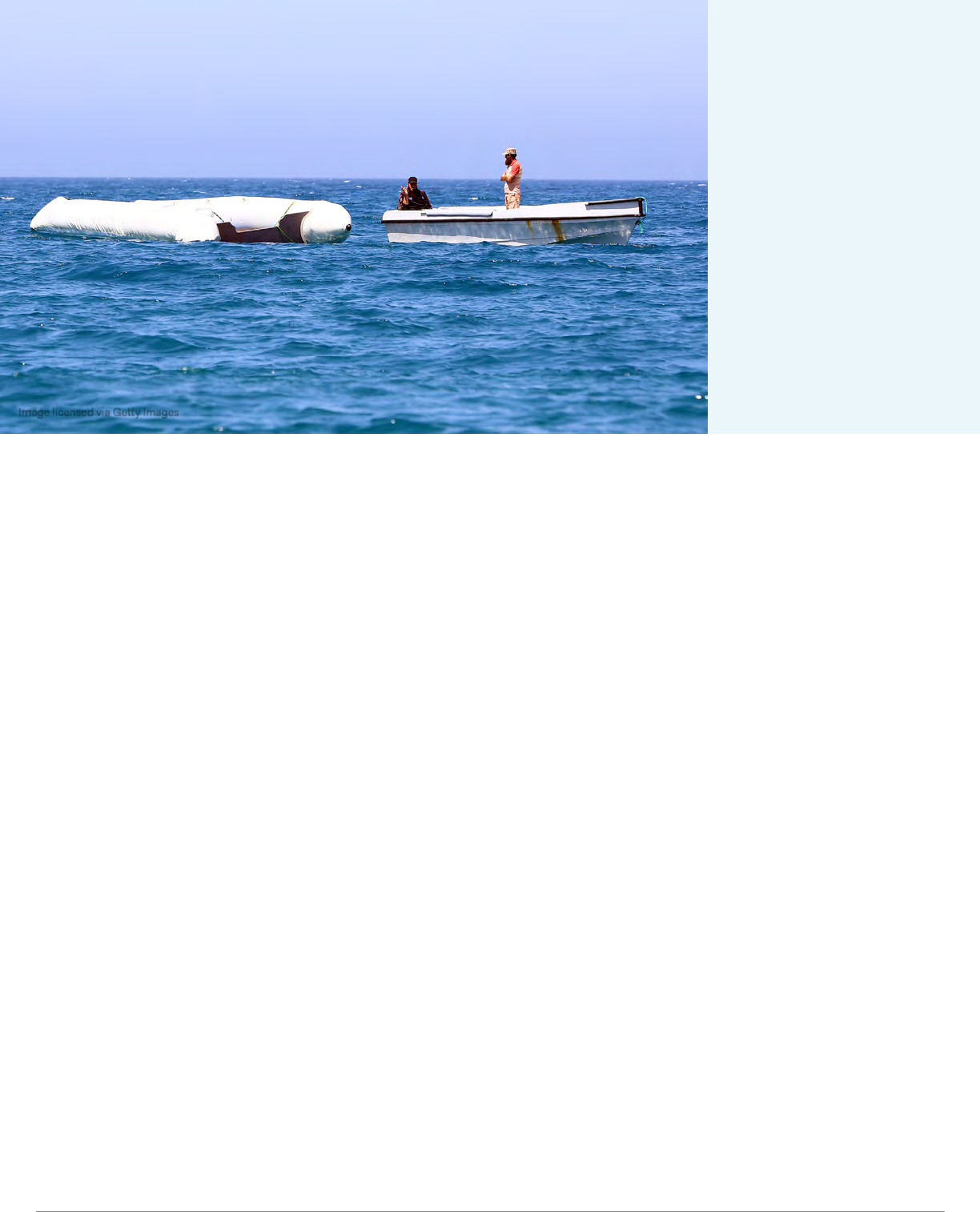
Pushing Back Protection: How Offshoring and Externalization Imperil the Right to Asylum
22
Libyan Coast
Guard ocials
drag a deated
rubber boat which
had carried some
of the 150 asylum
seekers whose
lives were lost in
a shipwreck in the
Mediterranean on
July 25, 2019.
Image licensed via Getty Images
In May 2021, the Oce of the United Nations High Commissioner for Human Rights (OHCHR)
released a report on the state of search and rescue operations in the Mediterranean Sea. The
report, titled “Lethal Disregard,”
97
condemns the failure of EU Member States to assist distressed
migrants at sea, as well as push-backs, the LCG’s “pattern of reckless and violent behavior,” and the
criminalization of SAR NGOs. As of December 2020, the OHCHR found that only 2 of the 15 SAR
assets which normally save lives in the central Mediterranean were performing rescue operations,
while the others were “either impounded or otherwise being prevented from undertaking their
activities.”
98
In addition to halting EU SAR operations and interfering with the work of NGOs, Italy and
the EU conspired with the Libyan Coast Guard, enlisting them to intercept asylum seekers at sea and
return them to Libya.
Under the United Nations Convention on the Law of the Sea, EU and Italian authorities are obligated
to alert whichever ship is in the best location to rescue a distressed vessel at sea.
99
In recent years,
however, Italian authorities and the EU’s border agency, Frontex, have given preference to the LCG
over non-governmental organizations to prevent disembarkation of asylum seekers in Europe.
100
Leaked transcripts detailing communications between Libyan and Italian Coast Guard ocials
revealed that Italian authorities were aware of Libya being “either unwilling or incapable of looking
aer migrant boats at sea.”
101
In one instance, a LCG ocial told his Italian counterpart who
had phoned to report 10 distressed dinghies that it was a holiday and “perhaps we can be there
tomorrow.” In March 2017, Italian ocials responded to calls for help from hundreds of distressed
asylum seekers at sea by reaching out to the LCG, who in turn failed to act. According to evidence
obtained by The Guardian, the Italian Coast Guard would subsequently lose contact with the
distressed dinghies, resulting in at least 146 deaths.
102

Pushing Back Protection: How Offshoring and Externalization Imperil the Right to Asylum
23
Italy’s and the EU’s externalization policies with Libya compound layers of
human suering for asylum seekers who are intercepted by the LCG and
returned to detention centers in the country. Conditions in Libyan detention
centers are abhorrent, and the country, engulfed in a civil war, is not party to
the 1951 Convention and has no asylum law.
103
Furthermore, Libya criminalizes
irregular entry, stay, and exit, and individuals intercepted at sea or apprehended
in the interior or at the borders of Libya are criminalized and detained.
104
Because of Libya’s failed judicial system, asylum seekers are detained
indenitely without being charged or convicted. Twenty percent of detained
asylum seekers in Libya are children, some of whom have been separated from
their families or are unaccompanied.
105
Detained asylum seekers including
children, are subjected to beatings, torture, forced labor, and sexual violence.
106
International human rights organizations have condemned the cooperation
of the Italian government and the European Union with Libyan authorities,
and have called for an end to the MOU and the release and evacuation of all
asylum seekers detained in Libya.
107
In a report submitted to the UN Security
Council on September 3, 2020, UN Chief Antonio Guterres urged the closure of
immigration detention centers in Libya due to their “horrendous conditions.”
108
“Detained migrants
and refugees in
Libya, both women
and girls as well
as men and boys,
remain at high risk
of sexual and gender-
based violence,
including rape,
which is used as a
form of torture, with
some cases resulting
in death.”
— Situation of migrants
and refugees in Libya,
United Nations Security
Council Report of the
Secretary-General
109
The inhumane externalization policies of the European Union and Italy have
increased pressure on asylum seekers to explore more dangerous migration
routes including the Atlantic route to the Canary Islands in Spain.
110
According
to the IOM, one-third of migrant deaths at sea in 2020 were along the Atlantic
route.
111
Loss of life in the Atlantic has persisted, with at least 126 deaths from
January to April of 2021.
112
Like Italy and Greece, Spain is an external border
state and a recipient of a larger number of arrivals. In 2020, more than 20,000
people mostly from the continent of Africa reached the Canary Islands aer
surviving dangerous journeys at sea, while at least 849 people died trying.
113
This is more than four times the amount of deaths in 2019.
The Spanish government has struggled to process these vulnerable people,
many of whom it has restricted in hotels and kept on the islands.
114
At the end
of 2020, when more than 8,000 people had been accommodated in hotels,
the government asked for resettlement support from the European Union.
115
Spain’s Migration Secretary Hana Jalloul called on other EU Member States
to share the responsibility of processing asylum seekers, stating: “We are the
southern border of Europe, not of Spain.”

Pushing Back Protection: How Offshoring and Externalization Imperil the Right to Asylum
24
In December 2020, the European Union announced 43.2 million euros in aid for Spain to, according
to the EU, go toward providing temporary shelter and additional assistance for migrants on the
Canary Islands.
116
Although many women and minors have reportedly been transferred to mainland
facilities or put into the care of Spanish government ocials,
117
thousands of men are being held
on the islands in unsanitary conditions with poor access to food, medical treatment and legal
services, where they fear they are at risk of deportation.
118
A 2020 Spanish Ombudsman report
decried conditions for asylum seekers on the Canary Islands and called for an end of the practice of
trapping of people on islands: “coastal areas in southern Europe cannot be turned into places where
rights such as freedom of movement are denied, on the grounds of migration control and to avoid
a so-called pull eect.”
119
In addition to the devastating human consequences of Spain’s migration
policies, trapping asylum seekers on islands in degrading conditions has not deterred new arrivals.
120
2.3. EU-Turkey Statement: Banishing Asylum Seekers
to Turkey and Trapping them on Greek Islands
In March 2016, European Union Members States and the Turkish government reached an agreement
to deport asylum seekers arriving on Greek islands “irregularly” to Turkey.
121
According to the
European Commission, the EU-Turkey Statement “sought to put an end to irregular migration from
Turkey to the EU, improve living conditions for Syrian refugees in Turkey and open up organised,
safe and legal channels to Europe for them.”
122
The agreement postures as a hybrid between a safe
third country agreement and border externalization and is predicated upon the false premise that
Turkey is a safe country for asylum seekers.
123
Intentionally called a “statement” rather than a bilateral
agreement, the EU-Turkey agreement also skirts judicial oversight because it implicates EU Member
States, rather than the EU.
124
Under the Statement, in exchange for accelerated talks on accession to the EU, visa liberalization,
and 6 billion Euros in refugee aid for Turkey,
125
Greece may deport asylum seekers to Turkey who
are deemed inadmissible for transiting through the country en route to Europe. Additionally, the
Statement provides that for every Syrian refugee deported to Turkey, one may be resettled in Europe.
This outsourcing practice was suspended in early 2020 due to the coronavirus pandemic and a
breakdown of relations between Turkey and Greece.
126
As the UNHCR has pointed out, the Statement relies on Article 33 in the Asylum Procedures
Directive (APD) to deport individuals who traveled through both a rst country of asylum and/or a
safe third country.
127
Rooting the legality of deportations to Turkey in the APD is dubious, particularly
because the Statement is not in compliance with Article 38 of the APD, which states that nations can
only be considered safe third countries when they are compliant with certain measures, including the
obligation to process and provide refugee protections in accordance with the Refugee Convention.
128
Although Turkey (which hosts the most refugees and asylum seekers worldwide
129
) is party to
the Refugee Convention and the 1967 Protocol, the country maintains the instrument’s original
geographical limitations and therefore does not provide non-European individuals with all rights
aorded by the Convention.
130
In Turkey, asylum seekers from non-European countries are granted

Pushing Back Protection: How Offshoring and Externalization Imperil the Right to Asylum
25
limited relief, must secure their own housing, and their access to the labor market
and education is restricted.
131
Further, they are subjected to deportation at any
time because Turkey’s protection regime for Syrians and other non-Europeans
is non-binding.
132
Overall, asylum seekers in Turkey experience high rates of
homelessness
133
and are frequently forced to work in the underground economy,
134
conditions which worsened during the COVID-19 pandemic. Further, because
the resettlement scheme in the EU-Turkey Statement applies to Syrians only,
it reinforces disparities in Europe’s protection regime among nationalities,
135
including those from Afghanistan, Iran, Iraq, and Sudan.
136
Turkey thus fails to meet
the threshold requirements for safe third country processing.
With the EU-Turkey Statement, European Union Member States employed Greek
islands to hold asylum seekers it intends to remove to Turkey o of the mainland.
This approach is designed to make it as dicult as possible for people to gain
protection in Europe, and as easy as possible for them to be returned to Turkey. As a
peripheral member state, Greece has therefore been tasked with guarding Europe’s
borders, and since the EU-Turkey Statement went into eect, it has eectively
served as a mass detention center for the EU. The Statement has trapped asylum
seekers in camps on the Greek islands with mandatory detention,
137
fast-track
asylum procedures,
138
due process deciencies, and a disregard for family
reunication.
139
“I thank Greece
for being our
European ασπίδα
[English: shield]
in these times.”
— European
Commission President
Ursula von der Leyen,
March 3, 2020
140
According to the UNHCR, as of September 2020 more than 21,000 people resided
in overcrowded camps on the Greek Aegean islands.
141
That month, the Greek
Moria refugee camp on Lesbos island caught re and was destroyed. At the time of
the re, the camp (built to house 3,000 people) had a population of 13,000.
142
The
Moria camp had been plagued by unsanitary and unsafe conditions. Its destruction
displaced thousands of asylum seekers, with many forced into even worse
conditions.
143
A temporary shelter erected on Lesbos to house more than 7,000
asylum seekers displaced by the Moria re has been described as susceptible to
strong winds and ooding, with poor sanitation and lack of power and adequate
protection for residents. Additionally, the Greek government conrmed in January
2021 that the camp (built on a repurposed ring range) has dangerous levels of
lead in the soil, endangering both asylum seekers and aid workers.
144
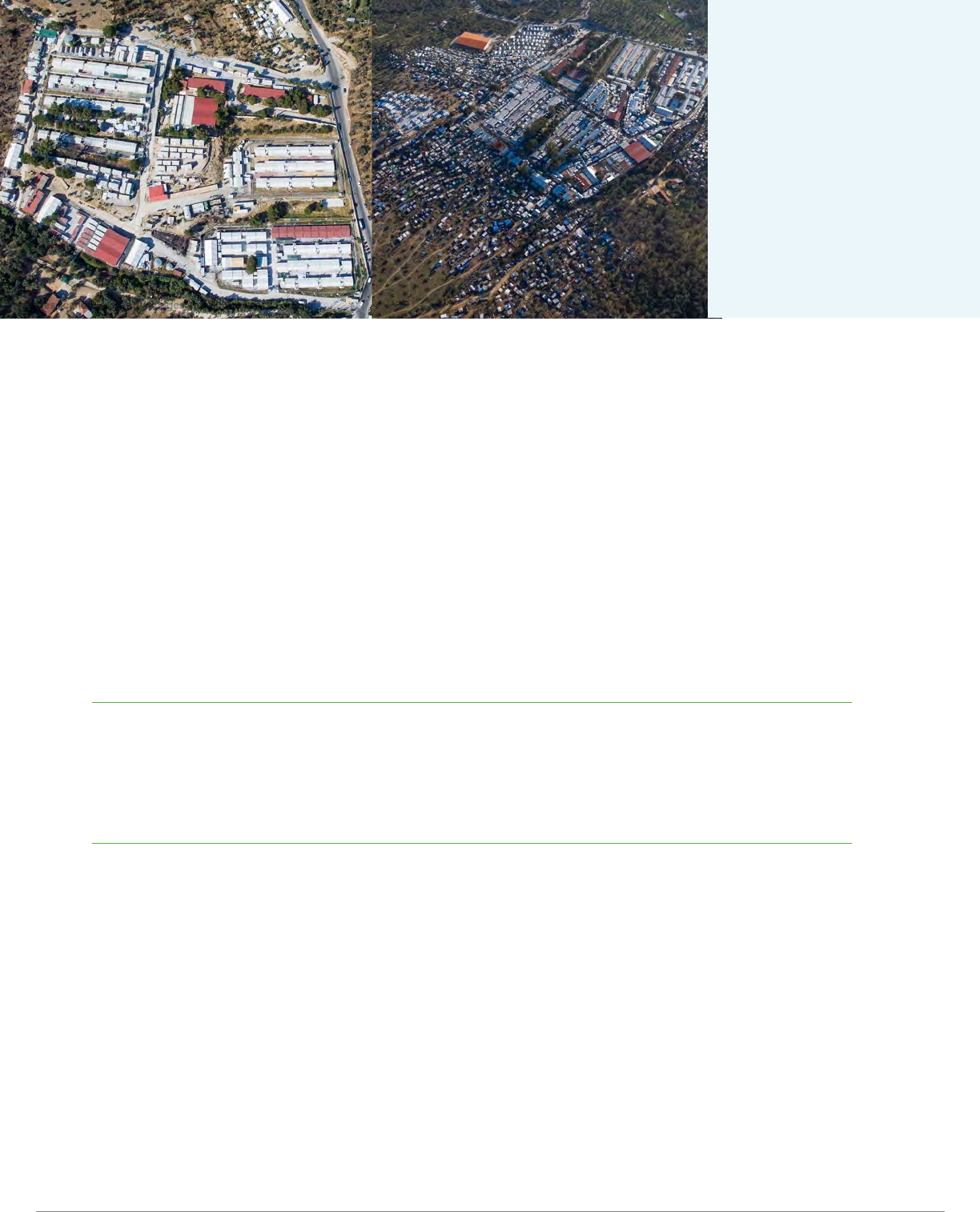
Pushing Back Protection: How Offshoring and Externalization Imperil the Right to Asylum
26
In addition to trapping people in unsafe conditions o of mainland Greece, Greek authorities have
engaged in systematic illegal push-backs at sea. In 2020, 9,741 asylum seekers, including children,
were involved in push-back incidents.
145
The Greek government also began to criminalize asylum
seekers, for example, in late 2020 Greek authorities charged an Afghani father with endangerment
because his 6-year-old son died at sea en route from Turkey.
146
With the goal of minimizing migration
to Europe, the EU and its Member States, including Greece, have subjected asylum seekers to a
system of punishment for daring to protect themselves and their families. Whether it be push-backs
at sea, oshore detention, or deporting people to Turkey where they are not provided full refugee
rights and are at risk of refoulement, the EU-Turkey Statement demonstrates the deadly human
suering caused by externalization regimes.
Photos taken of
Moria Refugee
camp in July 2017
and January 2020.
Images licensed via Getty Images and Shutterstock Editorial
Whether it be push-backs at sea, offshore detention, or deporting people to
Turkey where they are not provided full refugee rights and are at risk of refoulement,
the EU-Turkey Statement demonstrates the deadly human suffering caused by
externalization regimes.
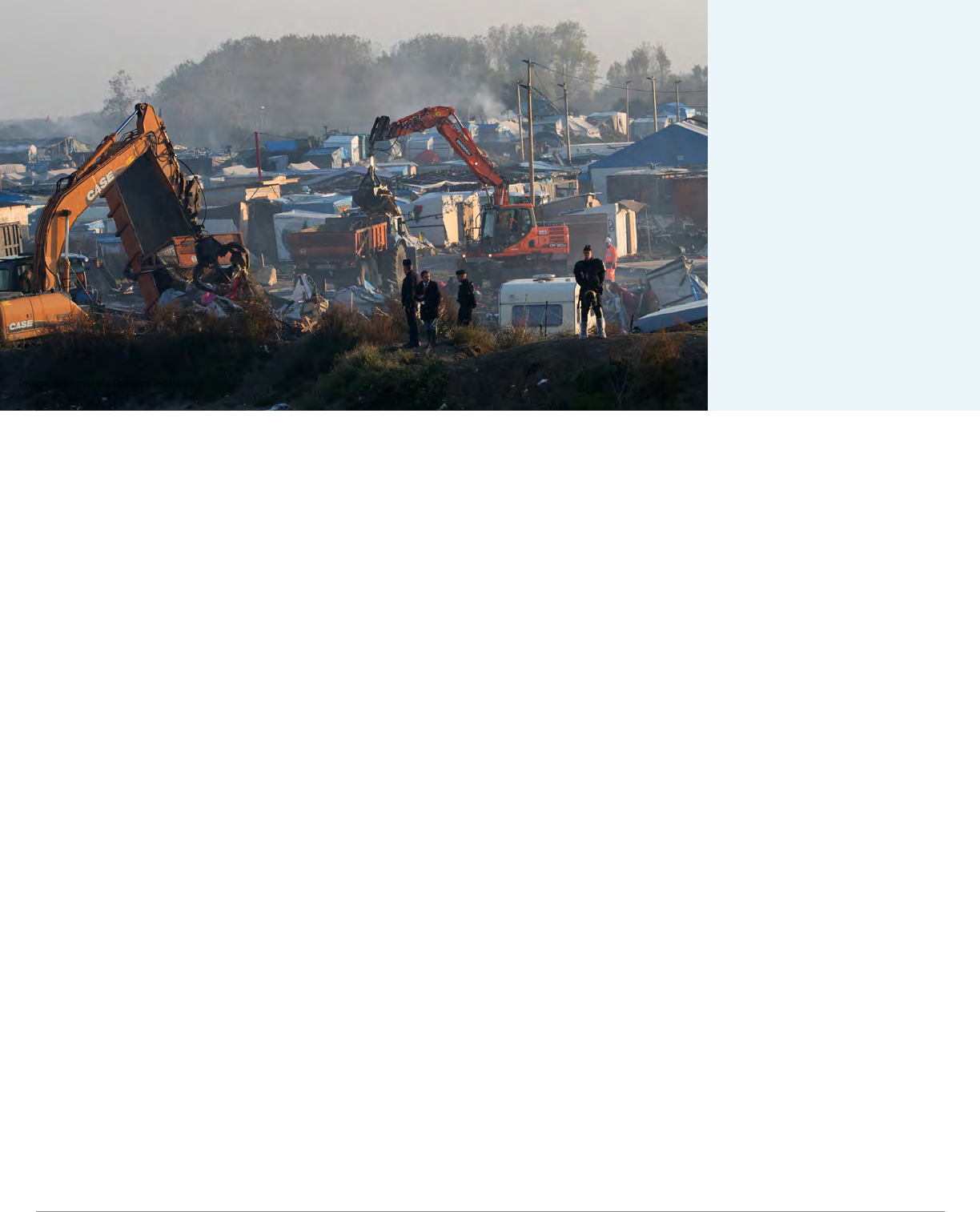
Pushing Back Protection: How Offshoring and Externalization Imperil the Right to Asylum
27
Demolition of the
Jungle refugee
camp in Calais,
France.
Image licensed via Reuters Pictures
2.4. U.K. and France Border Enforcement:
Raids, Surveillance and More Deaths at Sea
In addition to the European Union’s disturbing push-backs and other externalization policies, the
continent also has yet to provide safe conditions for asylum seekers internally—and this failure is
oen intentional. Member States participate in a variety of programs and policies designed to make
conditions so dicult as to incentivize “self-deportations.”
The northern French city of Calais has for years been an embarkation point for asylum seekers trying
to reach the U.K. In 2016, the French government sent bulldozers to demolish the ‘Jungle,’ a refugee
camp located in Calais, evicting thousands.
147
Conjuring images of colonial violence, France wielded
its police and military might intentionally to deter other would-be asylum seekers and “secure” its
border with the U.K. The demolition of this refugee camp was followed by a crackdown on informal
refugee camps and settlements, as well as on the ability of charitable organizations to provide food
and housing, particularly in northern France.
There are approximately 2,000 vulnerable people, including hundreds of unaccompanied children,
living on the streets in the French border towns of Calais and Dunkirk.
148
Inhumane living conditions,
lack of reception space, barriers to work authorization, hostility toward asylum seekers, and
challenges surrounding family reunication, drive asylum seekers to attempt to reach the U.K.
from France.
149
Police raids and the constant displacement and brutalization of asylum seekers
living in informal settlements have made surviving already unsafe and unsanitary conditions even
more dicult. In 2020, the non-prot Human Rights Observers found that nearly 1,000 police
evictions took place at refugee camps.
150
A eld director at the organization described the French
government’s strategy as being designed to wear down and tire asylum seekers, and to “take away
their hope. It’s like torture.”
151
An asylum seeker from Chad who escaped Libya and survived a
perilous journey at sea thought his life might get better when he reached Europe. Instead, his misery

Pushing Back Protection: How Offshoring and Externalization Imperil the Right to Asylum
28
persisted. He recalled: “I feel like my mind is slipping. I can’t remember the last
time I’ve slept… I ask the police for help, but they just beat us and take us to jail.”
Another asylum seeker from Nigeria said of the raids, “You think they are coming
for war.”
152
“They come
at 5am, circle
around your tent
and cut it with
knives... It has
happened to me
so many times.
They treat us
like animals, not
humans.”
— Abdul, a 20-year-
old from Sudan on
the French police
evictions.
153
France is not alone in this repressive conduct. For years, the U.K. has pumped
hundreds of millions of pounds into French border enforcement in order to
prevent asylum seekers and migrants from arriving on Britain’s shores.
154
Following the Brexit transition, the British government is reportedly planning to
“radically beef-up the hostile environment” approach for immigrants and asylum
seekers .
155
Because the U.K.’s Brexit deal with the EU did not contain provisions
similar to the Dublin regulation, the U.K. cannot make requests to “transfer”
individuals to an EU state that asylum seekers may have traveled through before
arriving in Britain.
156
This has driven the British government to explore new
methods for reducing the processing of asylum seekers on its territory.
Although the United Kingdom’s Home Oce previously distanced itself from
reports in September 2020 that it was exploring oshoring asylum processing to
Moldova, Morocco and Papua New Guinea,
157
the government agency proposed
new legislation in July 2021 to establish an oshoring system.
158
On July 6, 2021,
Home Oce Secretary Priti Patel introduced The Nationality and Borders Bill
to permit the processing of asylum seekers outside of the U.K., and make it a
“criminal oence to knowingly arrive in the U.K. without permission.” If enacted
the new legislation would limit the types of protection and benets available to
asylum seekers who arrive between ports of entry and who may have traveled
through a third country en route to the U.K.
Due to increased police presence in Northern France, it is all but impossible
for asylum seekers to arrive in the U.K. by the Channel Tunnel, the railway
tunnel connecting the two countries.
159
Instead, asylum seekers are driven to
pay exorbitant fees to smugglers who put them in boats and dinghies and into
the world’s busiest shipping lane - the English Channel.
In 2020, at least 8,000
asylum seekers crossed the Channel, though many more perished at sea.
160
In October 2020, a boat with asylum seekers sank, killing two children ages
5 and 8 and leaving a baby missing.
161
Just over a month later, the U.K. and
France reached an agreement doubling police presence along the French coast
and increasing surveillance measures.
162
The agreement failed to contain safe
and legal procedures for individuals to arrive in the U.K. and apply for asylum,
ensuring that crossings and deaths at sea will likely continue.
163
Further, the
continued militarization of northern France has only emboldened and enriched
trackers there, who have found new more dangerous routes and charged
asylum seekers more to journey along them.
164

Pushing Back Protection: How Offshoring and Externalization Imperil the Right to Asylum
29
2.5. Looking Forward: Europe’s Continued
Focus on Externalization and Returns
EU Member States have intensied their already harsh deterrent practices
under the guise of responding to the COVID-19 pandemic. Unable to halt the
departures of asylum seekers through other measures, EU Member States
pushed back at least 40,000 vulnerable people during the pandemic.
165
This
resulted in an estimated 2,000
166
deaths on land and at sea, and demonstrated
the willingness of EU Member States to violate the non-refoulement principle in
order to prevent asylum seekers from entering their territories.
In September 2020, the European Commission unveiled a new proposed Pact
on Migration and Asylum,
167
representing a capitulation to anti-immigrant heads
of state in Hungary and Poland. The pact contains some positive measures
for asylum seekers, including an expanded denition of family for reunication
purposes, but overall, fails to ground the new policy in humanitarian principles,
and diminishes existing EU protections for vulnerable people. The proposal
would replace the Dublin regulation with a new system for determining state
responsibility, though eectively the rst countries in which asylum seekers arrive
will bear most obligations. The pact solidies Europe’s practice of establishing
inter-country deals to halt migration, and expands detention and deportation
measures.
168
Under this pact, the practice of incentivizing third countries to
accept deportations and readmissions through visas and development assistance
continues.
169
The new proposal would also allow countries to opt out of relocating
asylum seekers processed by the European-wide system, and instead show
“solidarity” with peripheral countries by taking charge of deportations.
This proposal will continue to drive asylum seekers to take even more dangerous
routes in search of safety, with long-term deleterious eects on refugees’
health.
170
Humanitarian organizations led by the European Council on Refugees
and Exiles (ECRE) have noted two awed presumptions on which the new
pact is based: rst, “that the majority of people arriving in Europe do not have
protection needs;” and second, “that assessing asylum claims can be done easily
and quickly.”
171
As ECRE observes, both are unfounded. The majority of people
claiming asylum in Europe over the past three years, have, in fact, received a
form of protection.
Europe’s eorts to externalize asylum processing and border
enforcement are depriving vulnerable people of their right to protection, and
unnecessarily subjecting them to human rights abuses and death.
“...we want to
share with you
what we have, we
hope to live in
dignity. But this
dream comes at
a high cost for all
the migrants who
drown.”
— Asylum seeker from
Sudan who survived
a shipwreck in the
Mediterranean on April
22, 2021.
172

Pushing Back Protection: How Offshoring and Externalization Imperil the Right to Asylum
30
On April 22, 2021, at least 130 asylum seekers from African countries died in a shipwreck in the
Mediterranean o the coast of Libya.
173
As Marie Naas, Head of Advocacy in Germany and the
EU at the SAR NGO Sea-Watch points out, “Imagine a boat in distress with 90 people on board,
15 children, 3 pregnant women, all European or U.S. passport holders. Can you imagine what an
impressive otilla would search day and night for the boat in distress, supported by military and
helicopters and live tickers of all big news agencies? This reality is the greatest demasking of the
so-called European values.” Were Europe to live up to its self-described human rights ideals, it
would have to reckon with its treatment of asylum seekers and migrants on land and at sea, at
its borders and beyond, and end its punishment and banishment of human beings eeing war,
persecution, and other dangers.
As Marie Naas, Head of Advocacy in Germany and the EU at the SAR NGO Sea-Watch
points out, “Imagine a boat in distress with 90 people on board, 15 children, 3 pregnant
women, all European or U.S. passport holders. Can you imagine what an impressive
flotilla would search day and night for the boat in distress, supported by military
and helicopters and live tickers of all big news agencies? This reality is the greatest
demasking of the so-called European values.”

Pushing Back Protection: How Offshoring and Externalization Imperil the Right to Asylum
31
CHAPTER 3
The Pacific Solution:
Australia’s Insular
Approach to Asylum Seekers
“The White Australia policy, which officially ended in 1973, continued under
another guise. The colonial habit continues in Australia, with the government
using Nauru and Papua New Guinea for exiling undesirable people.”
— Behrooz Boochani, a Kurdish-Iranian asylee and award-winning journalist previously detained on Manus Island.
174
During much of the 20th century, the White Australia Policy primarily narrowed
migration to individuals of European descent, deliberately curbing the entry of Asian and
Muslim migrants.
175
This migratory policy even extended to Australian citizens of non-European
heritage, who were subjected to forms of immigration restrictions that their white peers did not
endure.
176
Though Australia’s refugee policy was not racially restrictive on its face, the government’s
favoring of resettled refugees over arriving asylum seekers became a new iteration of its historical
control of migration. Unlike asylum seekers whose arrival is not controlled by their country of refuge,
refugees are carefully selected, their arrivals planned, and their numbers capped by the receiving
nation.
177
Similar to the United States’ presumptive detention policy that began around this time,
178
Australia adopted a formal mandatory detention policy in 1992 that applied to everyone who enters
Australia without authorization, including asylum seekers. This policy was later aimed at deterring
so-called “illegal maritime arrivals”—disproportionately punishing those who faced the most perilous
journey to reach Australia’s shores.
179
Australia’s oshoring policy stands out for its cruelty, which has resulted from its active campaign
of vilifying mostly Asian, African, Middle Eastern and Muslim asylum seekers as a threat to its
borders and national identity. From forcible turnbacks to the suspension of its own laws, Australia
has conducted a two-decade project of stranding tens of thousands of asylum seekers in abhorrent
oshore conditions. Its conversion of two former colonies—Nauru and an island in Papua New
Guinea named Manus—into proxy detention centers has proven not only costly, but lethal. To date,
asylum seekers remain stranded on these islands without recourse.

Pushing Back Protection: How Offshoring and Externalization Imperil the Right to Asylum
32
3.1. Australian Push-Backs and
Territorial Excision
For decades, Christmas Island—a territory between Australia’s mainland
and Indonesia, which Australia annexed in the 19th century—acted as the
Australian border for arriving asylum seekers. Christmas Island became the
center of a controversy that launched Australian oshoring when, in August
2001, a Norwegian container ship called the MV Tampa rescued 433 Muslim
asylum seekers eeing Afghanistan.
180
The asylum seekers’ small boat, the KM
Palapa, had been stranded in international waters on its way from Indonesia;
the Norwegian ship pressured the Australian authorities to permit these
asylum seekers, many of whom faced dire medical emergencies, onshore.
Despite their likely eligibility for asylum in Australia, a stando ensued as
then Prime Minister John Howard refused to allow the asylum seekers onto
land. The following week, Howard stated in an interview, “I believe that it
is in Australia’s national interest that we draw a line on what is increasingly
becoming an uncontrollable number of illegal arrivals in this country.”
181
Howard oversaw the passage of the 2001 Border Protection Bill, which
authorized Australian authorities to board vessels, remove people, and make
arrests. The bill retroactively justied
182
actions taken during the MV Tampa
incident, and created legal pathways to halt future boat arrivals, an issue which
had not up to that point been a priority for the Australian public.
183
These
swi changes to asylum processing became law as a chorus of Australian
leaders began describing asylum seekers arriving by boat as “queue jumpers,”
“criminals,” or “terrorists.”
184
The Howard administration’s hostile response to asylum seekers arriving
at sea escalated from here. A cascade of policies were deployed to halt
the arrival of new asylum seekers by boat. First, the Australian government
elected to suspend asylum protections on Christmas Island (even though it
is part of Australia) so as to permit turn-backs of boats and asylum seekers.
This excision eectively converted parts of Australian territory into oshore
processing locations, where domestic and international obligations not to turn
back asylum seekers no longer applied.
185
Additionally, Australian authorities
launched “Operation Relex,” wherein its naval forces turned back boats of
asylum seekers in contravention of the Refugee Convention.
186
Alarmingly,
the Australian government oen conducted these push-backs in international
waters. A similar policy introduced in 2013, “Operation Sovereign Borders,”
further codied the policy of push-backs as Australia’s maritime response to
all migrants, including asylum seekers.
187
How the U.S. and
Australia Traded
Offshoring Tactics
Australia did not build its
maritime interdiction policy in
former colonies in a vacuum.
Though unique in its insular
geography, Australia tested
and explored the limits of these
interdiction policies in bilateral
and multilateral forums, where
Australian authorities shared
and received information with
their U.S. counterparts about
the architecture of oshoring
and push-back policies they
used in the Carribean—further
discussed in Chapter 4.
188
As
one former Australian ocial
described it, those forums
provided an opportunity for
Australian policymakers to
discuss the “margins” of the
Refugee Convention.
189
This information-sharing and
communication on interception
tactics were well underway by
the time the MV Tampa was
on every headline. As they
troubleshooted their response,
Australian ocials were in
daily contact with a senior U.S.
policymaker, who consulted with
them about the U.S. response
to Haitian asylum seekers
intercepted at sea in the 1980s
and 1990s.
190
For more on these
policies, see Chapter 5.
Australian authorities also spent tens of millions of dollars on a campaign to
deter asylum seekers from reaching its shores.
191
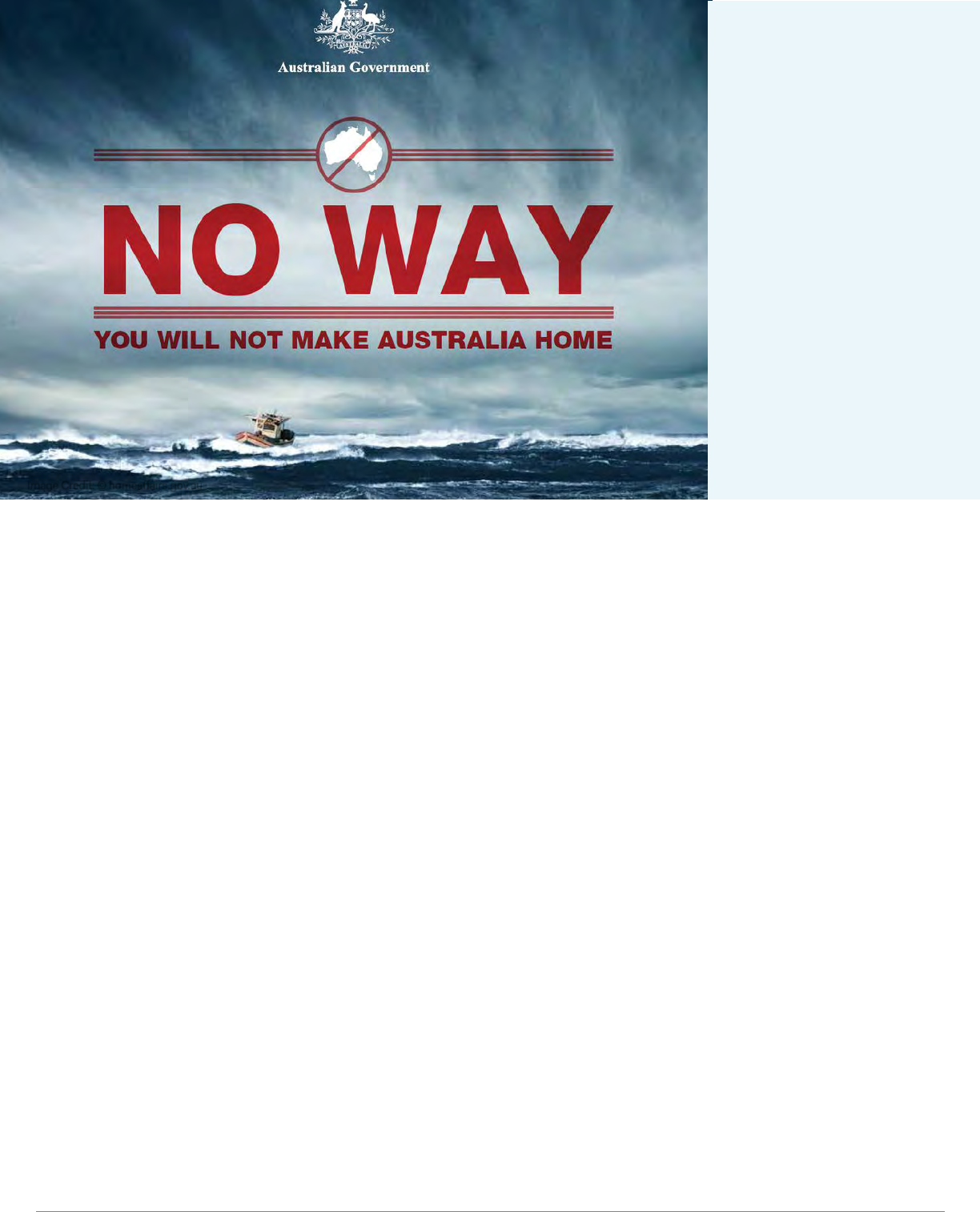
Pushing Back Protection: How Offshoring and Externalization Imperil the Right to Asylum
33
3.2. From Former Colonies to Asylum Jails
Neither its deterrence campaign against asylum seekers and migrants, nor the legal excision
of its own territory, nor boat push-backs represented Australia’s most extreme response to
those seeking refuge. Australia’s ultimate oshoring vehicle, dubbed the “Pacic Solution,” was
to strong-arm two Pacic islands to jail asylum seekers indenitely. Nauru and Manus, which
Australia previously controlled as protectorates
192
or colonies,
193
became jails where asylum
seekers intercepted at sea were detained indenitely—approximately from 2001 to 2008, and
then again from 2012 to the present day
Nauru is a small island with a population of about 10,000. Australia took control of Naura in 1914
during the First World War, and maintained control until Nauruans claimed their independence
in 1968. During this time, Australia oversaw the mining of phosphate, a valuable commodity and
important fertilizer to catalyze Australia’s agriculture industry.
194
Following its independence,
Nauru briey became one of the wealthiest nations in the world per capita upon taking control
of its own natural resources.
195
However, by the 1990s, the phosphates deposits were nearly
exhausted and Nauru found itself with mismanaged investments, an environmental disaster, and
an economic crisis.
196
Papua New Guinea was also held under Australian control from the First World War until 1975.
One of its small islands, Manus, has approximately 60,000 inhabitants, most of whom relied on
subsistence farming and shing.
197
Papua New Guinea has its own tumultuous past, including
the nine-year Bougainville civil war,
198
during which Bougainville island inhabitants started
rebelling against the exploitation of the land by mining companies. Over 20,000 people died
during this conict,
199
and it was only in 2001 that a peace agreement was reached in which a
A poster displayed
during Australia’s
media campaign
to deter migrants
and asylum
seekers, which
cost Australian
taxpayers AUD$
22.5 million in
2013–2014.
Image Credit: © homeaairs.gov.au
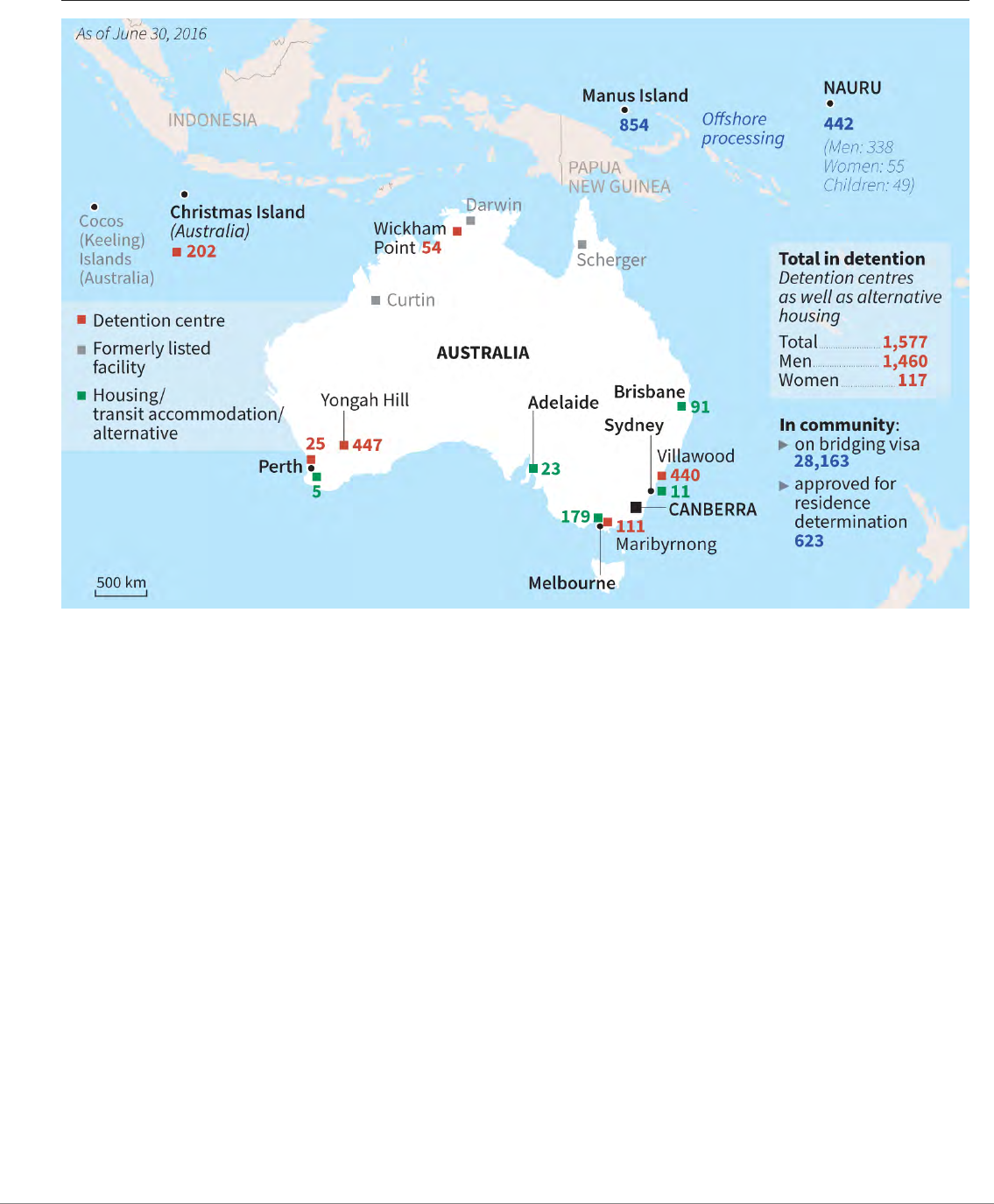
Pushing Back Protection: How Offshoring and Externalization Imperil the Right to Asylum
34
ceasere would be overseen by neighboring countries. Further, Manus Island faces extreme risk
from climate change, and is highly vulnerable to rising water levels that have repeatedly ooded
homes, destroyed animal habitats, and forced people to relocate.
200
Both Nauru and Manus Islands were highly vulnerable as a result of economic, environmental, and
political exploitation and they were not in a position to refuse an oer for development aid tethered
to Australia’s demand that they jail asylum seekers.
201
In return, Australia poured tens of millions
of dollars into Nauru’s economy and funded major upgrades of Manus’ infrastructure, and fast-
tracked Australian aid.
202
Despite formal memoranda of understanding,
203
the rushed character of
these agreements was hard to miss. Nauru did not even join the Refugee Convention and the 1967
Protocol until 2011, while Papua New Guinea failed to provide any denition of asylum processing or
incorporate the Convention and 1967 Protocol into its domestic law decades aer ratication.
204
During a brief change of leadership, the islands ceased to receive new asylum seekers from 2008 to
2012. However, calls in Australia for a return to oshore processing increased with a number of boat
arrivals of asylum seekers labeled “illegal maritime arrivals.”
205
In response, then-candidate for prime
minister Kevin Rudd ran on a campaign of stopping the boats on security grounds, citing 9/11.
206
Map depicting immigration detention facilities in and outside of Australia as of 2016
Image Credit: © AFP

Pushing Back Protection: How Offshoring and Externalization Imperil the Right to Asylum
35
When he won, Rudd made the historical announcement that none of the asylum seekers intercepted
at sea, and placed on the islands by Australian authorities, would be settled in Australia.
207
This policy
specically targets asylum seekers arriving by boat; as the Australian Department of Home Aairs
bluntly notes, “No one who attempts illegal maritime travel to Australia will be settled here.”
208
Rudd
formalized an arrangement with Nauru and Manus, committing the small islands to “enhance[e]”
their capacity as processing centers to receive asylum seekers transferred from Australian
authorities, while arranging for the asylum seekers’ resettlement outside of Australia.
209
Fueling this
policy was a rhetorical focus on tracking prevention,
210
deterrence, and mitigating Australians’
distress at watching the deaths of boat travelers.
Australia’s preoccupation with curbing asylum seekers arriving by boat has
proved costly. Australia has spent $7.6 billion for the transfer of 3,127 asylum
seekers to Nauru or Manus since 2013.
211
This staggering gure does not include cash poured into resettlement deals with other countries or
contractors retained to stretch the island’s modest infrastructure systems into full asylum processing
centers.
212
In practice, Australia’s money did little to improve the lthy and devastating
213
conditions
to which these asylum seekers were subjected. Additionally, Australia ignored alternative, and more
cost-eective, ways to process and protect asylum seekers onshore.
214
Due to Australia’s own manufactured crisis, 30,000 asylum seekers were le in legal limbo in Australia,
with only the prospect of receiving temporary protection visas following Rudd’s 2013 announcement.
215
3. 3. Impact on Asylum Seekers
It is hard to understate the devastating, deadly impact on the mental and physical health of asylum
seekers stranded in legal limbo in Australia’s oshore processing. Physically, these oshore
detention centers are dirty, under-resourced, rife with cockroaches and rats,
216
and are ill-prepared
to provide sucient medical care. Individuals on oshore processing islands report harrowing
journeys that include child births in detention, indenite jailing, suicides, and deaths.
217
Longer term,
this indenite detention, with no trial date and no end in sight, causes both physical and emotional
damage on adults and children,
218
which has led to extensive self-harm and suicide
219
on both islands.
Despite numerous deaths due to inadequate medical care, Australia refused to transfer oshored
asylum seekers to its hospitals until 2019. Even then, it rst restricted the transfer of ailing asylum
seekers to Christmas Island;
220
while Australia recognized a duty of care to asylum seekers oshore,
urgent transfers require litigation before asylum seekers can access the medical treatment they need
on the mainland.
221
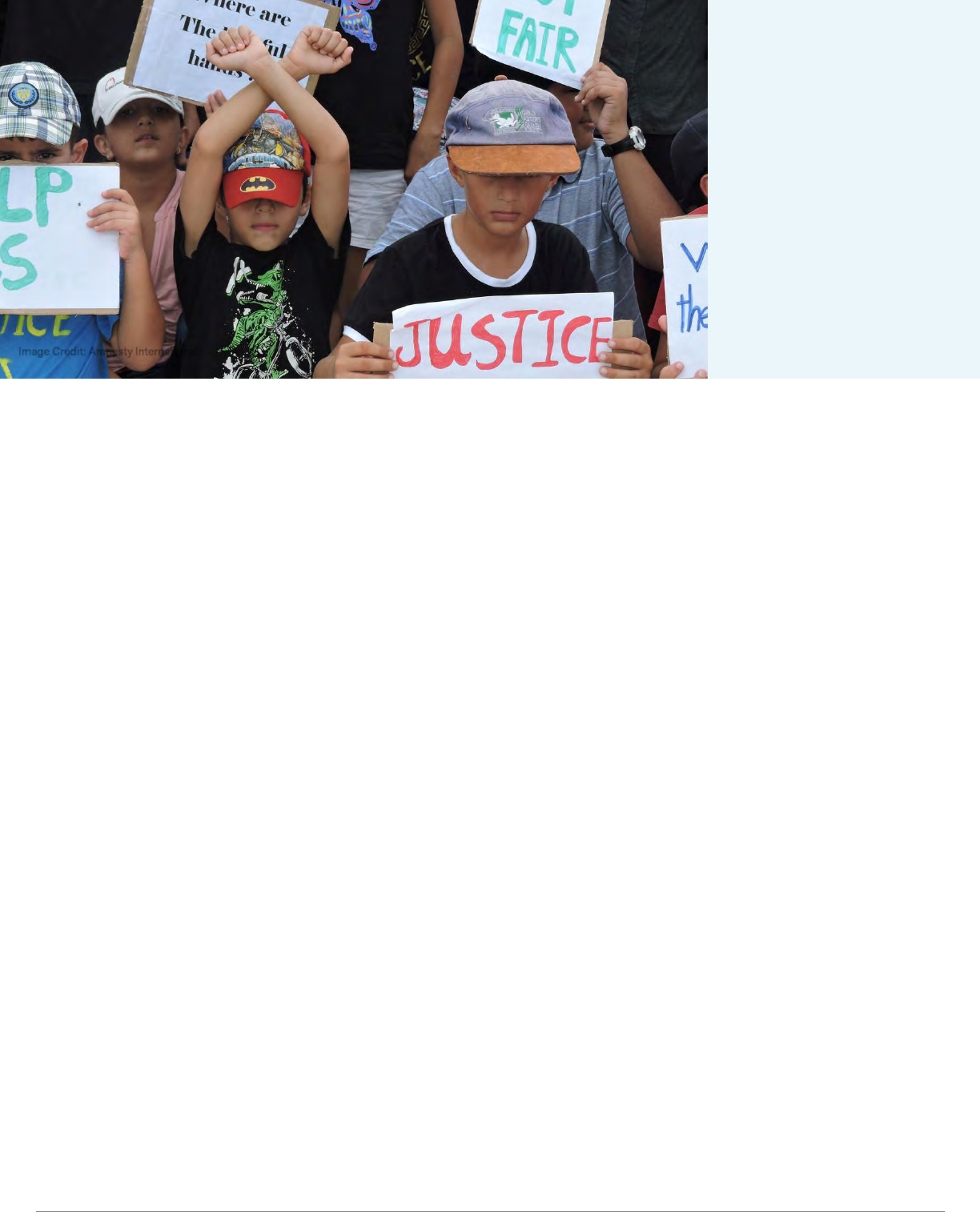
Pushing Back Protection: How Offshoring and Externalization Imperil the Right to Asylum
36
Children
detained
in Nauru
protest their
connement in
March 2015.
Image Credit: Amnesty International
The Refugee Council of Australia calls the conditions on Nauru a “man-made crisis.”
222
In 2013,
they reported that “children as young as 7 and 12 are experiencing repeated incidents of suicide
attempts, dousing themselves in petrol, and becoming catatonic. At least two people have killed
themselves, and three others have died. Many more are trying to kill or harm themselves. People
are losing their hope and their lives on this island. This is Australia’s man-made refugee crisis in the
country it still treats as a colony, Nauru.”
223
In Manus, asylum seekers staged a protest when their detention center nally closed. Rather than
facilitating their transfer to Australia, the Papua New Guinean authorities expected them to transfer
to Nauru’s camp or integrate with the general population in the archipelago. Hundreds of people
refused to leave the center, citing fear of what might happen to them in the local community, given
that relationships between locals and the asylum seekers could be tense and violent at times.
224
The
asylum seekers were le with no food, water, or electricity, with authorities raiding and destroying
their belongings and shelters, until their forcible transfer to new facilities on the island.
225
Years of
legal limbo, indenite jailing, and hopelessness continued, causing some observers to compare
these practices to those used on detained asylum seekers held at Guantánamo Bay.
226
An overwhelming number of asylum seekers subjected to oshore processing were Middle Eastern,
Asian, or African.
227
Today, amidst the COVID-19 pandemic, the Australian Home Aairs Department
estimates that about 239 asylum seekers still remain in Nauru and Manus, while hundreds were
transferred onshore to receive medical treatment.
228
Despite the relatively small number le on
the islands, Australia expects to spend approximately $3.4 million per asylum seeker in 2021-
2022.
229
Unfortunately, those high costs have not resulted in improved conditions, as the abuse and
mistreatment of asylum seekers continues.
230
Meanwhile, Australia continues to push back incoming
asylum seekers intercepted in Australian and international waters.
231

Pushing Back Protection: How Offshoring and Externalization Imperil the Right to Asylum
37
Additionally, Christmas Island continues to
act as a large domestic onshore site, as well.
The Australian government built a sprawling
prison for asylum seekers on the island to the
tune of $185 million.
232
This site rst opened
in 2018 and at least one asylum seeker has
died there. Though it closed briey in 2019, the
prison recently reopened in 2020 at the cost of
an additional $26 million, only to house a Sri
Lankan couple and their two small children.
233
The skyrocketing costs of these oshore sites,
whether on Australia’s Christmas Island or in
the Pacic, have done little to dissuade Australia
from its punitive and carceral approach to asylum
seekers arriving by sea.
Behrouz Boochani, a Kurdish-Iranian asylee and
award-winning journalist previously detained
on Manus Island, underscored the irony of
Australia—a former penal colony for white
Europeans—subjecting primarily Muslim, Asian,
Middle Eastern, and Africans to the same fate.
“Sometimes I feel that Manus and Nauru are like
a mirror,” Boochani said. “Australia sees its real
face on that mirror, and they hate it. Because we
are boat people. They call us boat people. But
you are boat people, too.”
234
Pitting Refugees Against
Asylum Seekers
Unlike the United States and the European Union,
Australia’s geographic isolation in the Pacic Ocean
naturally limits migration. While Australia resettles a
great number of refugees,
235
it has taken a particularly
harsh stance against asylum seekers reaching its shores.
Australia has created a hierarchy between refugees and
asylum seekers, favoring refugees because of Australia’s
ability to control their numbers and arrival versus asylum
seekers, whose arrival is driven by the urgency of their
sudden ight.
236
An important element of Australia’s
refugee program is that it “allows Australia to choose
who it will accept,” and it “favors young, healthy and
skilled applicants,” resulting in few admissions from
refugee camps in Africa and the Middle East
237
and
an overwhelming preference for Christian refugees.
238
In addition, Australia uses its refugee resettlement
numbers as political capital to try to rebut reasonable
critiques of its asylum policies.
Australia and the United States have also used refugee
resettlement as a bargaining chip to send more than
one thousand Nauru and Manus refugees to the U.S.,
while Australia accepted Central American refugees.
239
The deal exemplies the two nations’ attempt to control
migration and deter future asylum seekers’ aspirations to
seek protection in their country of destination.

Pushing Back Protection: How Offshoring and Externalization Imperil the Right to Asylum
38
CHAPTER 4
Laying the Foundation Of
U.S. Offshoring: From Angel
Island to Guantánamo Bay
“This court cannot close its eyes, however, to a possible underlying reason why
these plaintiffs have been subjected to intentional ‘national origin’ discrimination.
The plaintiffs are part of the first substantial flight of black refugees from a
repressive regime to this country. All of the plaintiffs are black.”
— Senior U.S. Federal District Judge James Lawrence King
240
Though the U.S.’s offshoring policy did not begin until later in the twentieth century, the
policy to push migrants to the periphery of U.S. land is not new.
Hyper-focused on deterring
non-European migration and for a period of time migration from southern and eastern Europe,
241
the United States has long concentrated on pushing maritime arrivals away from its mainland. This
goal drove policymakers to expand upon U.S. island quarantine stations at the turn of the century,
eventually evolving into militarization of the U.S.-Mexico border, as well as the conversion of leased
Cuban land into an indenite oshore jail for Haitians.
4.1. The Incipient Stage Of U.S. Offshoring: Public
Health as Racial Exclusion From Angel Island to the
U.S.-Mexico Border
Ellis and Angel Islands became the site of a new experiment in the late 19th century as millions
of people migrated from Europe and Asia to the U.S. Part of U.S. territory facing the Atlantic and
Pacic oceans,
242
the islands morphed into quarantine detention centers where the U.S. piloted its
rst oshoring: keeping migrants away from the domestic mainland while they were subjected to
intrusive medical screenings.
243
These medical screenings, though ostensibly promoting public
health, were in reality tactics of racial exclusion which aimed to ban migrants who were carrying
“loathsome and contagious disease” and to rid the U.S. of other “undesirable” populations.
244
The percentage of Europeans excluded from the U.S. was much lower than non-Europeans.
245
In
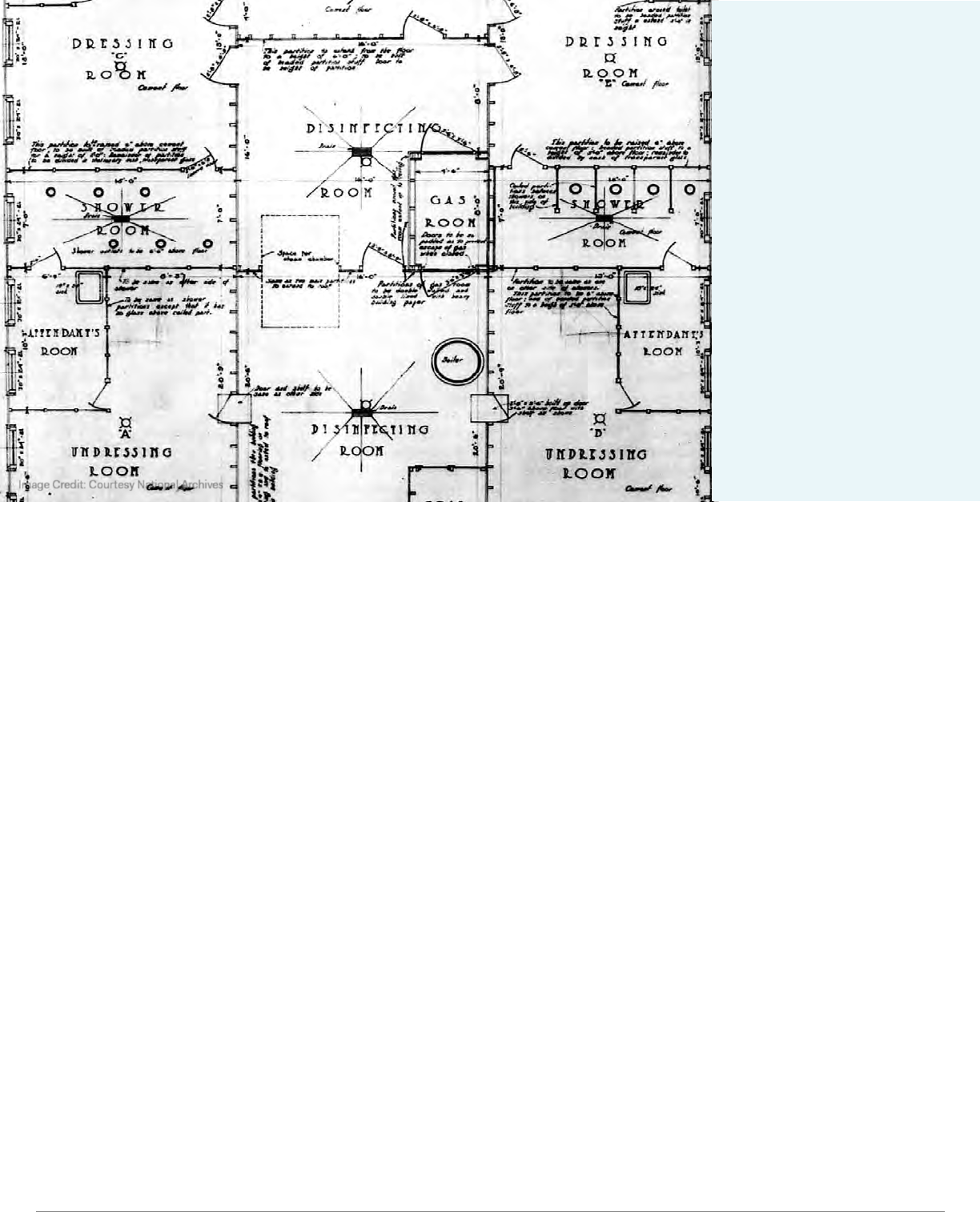
Pushing Back Protection: How Offshoring and Externalization Imperil the Right to Asylum
39
contrast to Ellis Island, Angel Island, which is located in the San Francisco Bay, served as the primary
arrival point or ocial gateway for Chinese and other Asian immigrants.
246
In fact, the construction
for an immigration facility on the West Coast was the direct consequence of two pieces of legislation
designed to block or limit Chinese migrants from coming to the U.S. mainland: the Page Act of 1875,
and the Chinese Exclusion Act of 1882.
247
This experiment ushered in a lasting shi at another periphery for the rst half of the 20th century,
the U.S.-Mexico border, where Mexican laborers were also subjected to humiliating health
screenings and “cleansing” procedures that included being forced to strip, as well the use of gas
chambers to fumigate their clothes.
248
Combined with a new law that created criminal penalties for
border crossings (a law used widely to this day and originally championed by a U.S. Senator who
proudly defended lynching, segregation, and nativist policies against Mexican laborers),
249
the U.S.
government laid the groundwork for massive push-backs at the southern border. This marked a shi
from comparatively uid movement across the U.S.-Mexico border, emanating from the relatively
recent U.S. annexation of large portions of Mexican land. While erecting a new infrastructure of
border control, state police and vigilantes terrorized Mexicans they encountered. Lynchings of
Mexican migrants from the late 19th century until the rst half of the 20th century range between
hundreds and several thousands.
250
The southern border remains a deadly place for migrants to this day.
251
But the southern border did
not become the primary springboard for push-backs and oshoring until the 2000s. Until then, the
U.S. returned to the insular laboratory; Angel Island, it turns out, was the prologue for Guantánamo
Bay, a near colonial territory of the United States in Cuba.
El Paso
“disinfection”
plant blueprints
from 1916.
Image Credit: Courtesy National Archives

Pushing Back Protection: How Offshoring and Externalization Imperil the Right to Asylum
40
4.2. Guantánamo Bay: From a Naval Station
to a Detention Center for Asylum Seekers
History of U.S. Control
of Guantánamo Bay
Within the Broader
Context of U.S.-Cuba
Relations
A number of the “Founders”—including
George Washington, James Madison,
and Thomas Jeerson—readily
professed ambitions of expanding
the “American Empire.” Jeerson
thought Cuba “the most interesting
addition which could ever be made to
our system of States,” and told John
C. Calhoun in 1820 that the United
States “ought, at the rst possible
opportunity, to take Cuba.” John
Quincy Adams, James Monroe’s
Secretary of State and his successor
in the White House, considered the
annexation of Cuba “indispensable to
the continuance and integrity of the
Union itself.”
252
This expansionist approach brought
the U.S. Senate to advocate for the
purchase of Cuba from Spain in
the mid-1850s.
253
By the end of the
century, the Cuban government
struck a deal to lease Guantánamo
Bay to the U.S. in exchange for its
independence.
254
Fidel Castro’s
government viewed the continued
U.S. occupation of the Bay as
illegal.
255
Though the U.S. acquired
“an empire of military bases’’ across
the Caribbean and later colonized
the Philippines in the Pacic,
256
Guantánamo Bay was unique in
becoming an extension of U.S. border
processing—permitting oshore,
indenite detention and interceptions
at sea at a ‘safe’ distance from the
mainland.
Guantánamo Bay transformed into a makeshi U.S. detention center for
asylum seekers in response to a twofold situation: the exodus of tens of
thousands of Haitians eeing a brutal military dictatorship
257
and increasing
panic among policymakers over the HIV/AIDS epidemic in the U.S.—
culminating with the Centers for Disease Control and Prevention’s (CDC)
designation of Haitians as a high-risk group in 1983 and an immigration
ban on individuals living with HIV/AIDS in 1987.
258
In the early 1990s, the
U.S. began detaining Haitian asylum seekers intercepted at sea en masse
away from the U.S. mainland, even if they were not HIV-positive,
259
veering
sharply from the policy formally adopted by the U.S. in the 1950s of not
incarcerating migrants.
260
Large numbers of Haitians ed by boat to the United States in 1980—the
same year that the U.S. codied non-refoulement in its domestic asylum
code, the Refugee Act of 1980. One year later, President Ronald Reagan
struck a deal with Haiti’s government to return anyone apprehended at sea
who travelled “illegally.”
261
Though Reagan pledged not to return asylum
seekers, only 6 out of 21,000 Haitians received asylum hearings over the
course of nine years.
While Reagan paid lip-service to the principle of non-refoulement, his
successor George H.W. Bush explicitly limited its scope.
262
Beginning in
late 1991, the Bush administration re-directed boats toward Guantánamo
Bay, stating that the inux of ras would be overwhelming for the U.S.
Coast Guard.
263
By the end of the year, the U.S. Coast Guard “screened-
in” approximately 10,500 Haitians who had a credible fear of returning to
Haiti and detained them at Guantánamo Bay.
264
Then, in the spring of 1992,
President Bush issued an executive order stating that the U.S. obligation
not to refoul—i.e., not to return refugees to harm—did not apply to asylum
seekers intercepted outside of the U.S.
265
Within eighteen months, the U.S.
Coast Guard intercepted more than 34,000 asylum seekers attempting to
escape the military regime in Haiti.
266
When Bill Clinton was elected President, he originally vowed to reverse this
policy, but went on to continue intercepting asylum seekers at sea aer
relabeling it as a “humanitarian mission” to rescue them, and claiming that
a lack of space in the U.S. made oshore detention necessary.
267
In reality,
asylum seekers were trapped in a legal black hole: forcing asylum seekers
to return to Haiti would have violated domestic and international law, yet
many were barred from entering the U.S. under the 1987 prohibition on HIV-

Pushing Back Protection: How Offshoring and Externalization Imperil the Right to Asylum
41
positive foreigners from entering the country.
268
Asylum seekers languished in detention because the
U.S. continued to use public health as an immigration tool to repress Haitian asylum seekers.
This led to the mass detention of Haitian asylum seekers in shocking conditions at Guantánamo Bay.
The detention center (limited to a maximum of 12,500 persons) reached capacity numerous times
between 1991 and 1992.
269
Asylum seekers were housed in tents covered in garbage bags, which
barely protected them from the rain, and enclosed by barbed wire fencing.
270
They were forced to eat
spoiled and sometimes maggot-lled food in extreme heat.
271
Asylum seekers’ physical and mental
health declined signicantly, resulting in some suicide attempts.
272
Medical care was also inadequate, especially for the hundreds of HIV-positive refugees detained. For
the tens of thousands of refugees detained at Guantánamo Bay, there were only a handful of medical
personnel on site and a small number of hospital beds.
273
The rest of the world denounced these conditions, which the Doctors of the World called a
“disgrace.”
274
Haitians protested their detention conditions and harsh treatment by marching through
the detention camp, but were met by military police in riot gear.
275
News outlets across the globe
reported refugees protesting in a weeks-long hunger strike.
276
Following this public outcry, the number of asylum seekers detained at Guantánamo declined. In
1992, approximately 300 Haitians remained, more than 230 of whom were HIV-positive.
277
The U.S.
government determined that all 300 asylum seekers were “bona de” refugees but did not process
their asylum cases because of the 1987 HIV ban.
278
A federal court later noted that the U.S. enforced
the HIV ban against only Haitian refugees.
279
At the same time, two court battles ensured that the U.S. government could continue the practice. A
federal district court determined that asylum seekers were deprived of due process by being denied
the opportunity to speak to their own attorneys and adequate medical care.
280
The court ordered the
government to release the refugees to anywhere but Haiti, and the government ultimately transferred
many asylum seekers to the U.S.
281
The Clinton administration later settled the case, stripping the
decision of any legal precedent.
282
In Haitian Centers Council v. Sale in 1993, the U.S. Supreme Court determined that neither section
243(h) of the Immigration and Nationality Act nor Article 33 of the 1951 Refugee Convention
prohibited the U.S. from intercepting refugees beyond U.S. territory and forcing repatriation.
283
So
long as these interceptions did not occur within U.S. territory, the U.S. had carte blanche to refoul
asylum seekers.
Emboldened by their win before the Supreme Court, the U.S. government later made
clear that Sale empowers them not only to push-back at will on international waters,
but to oshore asylum seekers.
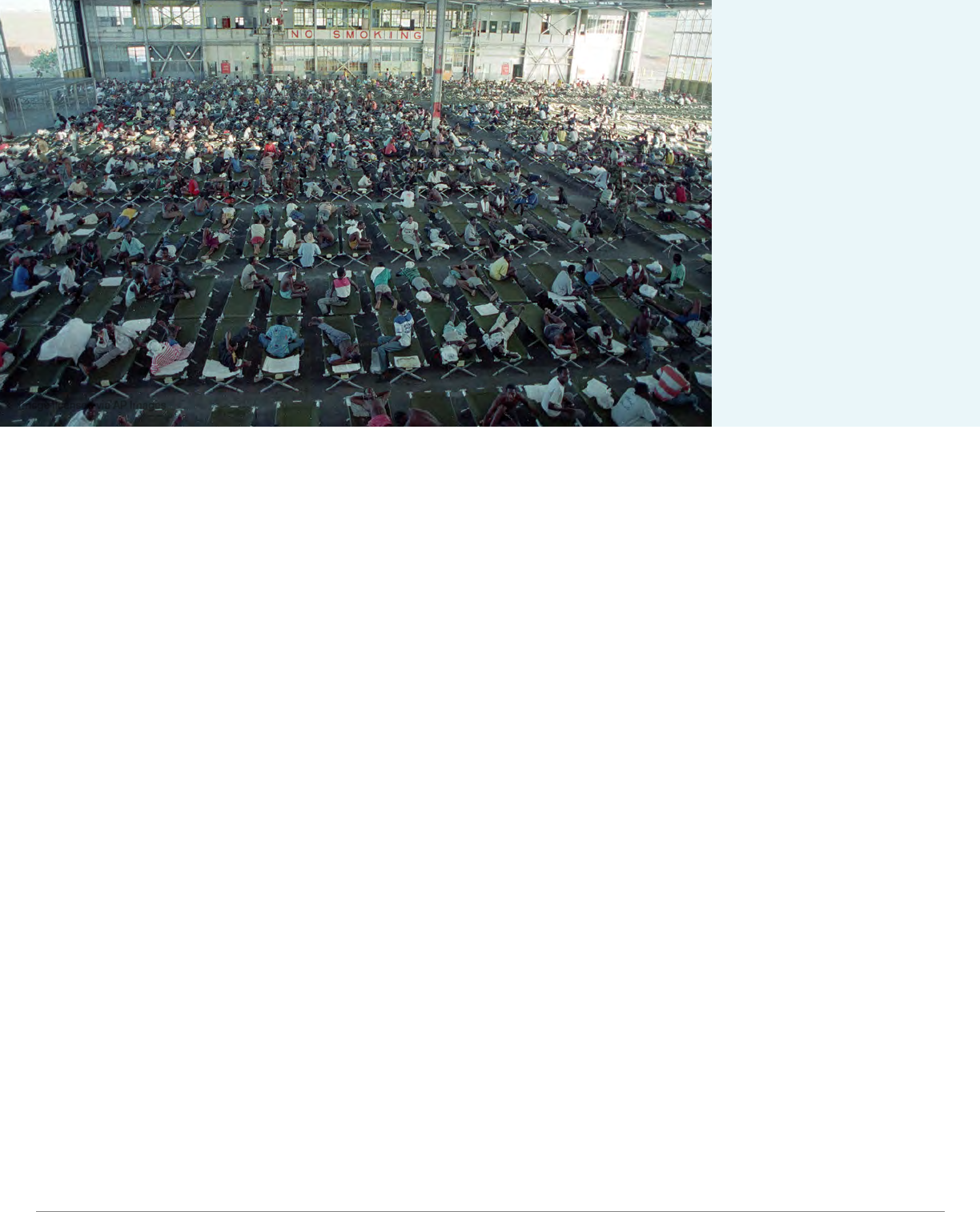
Pushing Back Protection: How Offshoring and Externalization Imperil the Right to Asylum
42
As they stated before the Inter-American Commission on Human Rights,
“[Non-refoulement]… is a limited obligation, only relevant with respect to refugees who have
reached the territory of a contracting state, and does not apply to persons interdicted on the
high seas. In addition, the obligation does not prevent a contracting state from sending a
refugee to any place other than the country of persecution.”
284
Sale helped pave the way for the government to test further the boundaries of international
obligations through various iterations of oshoring and externalization regimes.
Months aer Sale, the Clinton administration continued re-directing asylum seekers to Guantánamo
Bay aer then- President Fidel Castro lied the emigration ban and thousands of Cubans ed to the
U.S.
285
Until this point, Cuban refugees were granted asylum in the U.S., but thousands of Cuban
asylum seekers were now intercepted and detained.
286
The total detained population at Guantánamo
Bay, including Haitian and Cuban refugees, peaked in 1994, when around 12,000 Haitians with
credible fear of persecution were detained—the vast majority of whom were eventually denied asylum
in the U.S.
287
By 1994, political pressure mounted for then-President Clinton to wind-down detention at
Guantánamo Bay and compel the military regime in Haiti to stop oppressing asylum seekers.
288
Ultimately, the U.S. deported approximately 25,000 Haitians from 1991-94, subjecting them to brutal
harm and repression.
289
The exact human toll of these U.S. policies is unknown. However, the U.S. treatment of Haitians
also cemented a new era of oshoring, long aer the U.S. committed to non-refoulement under
domestic and international law. The U.S. briey reached agreements with Jamaica and the United
Kingdom in the Caribbean and the West Indies
290
to process interdicted Haitians on a boat o the
coast of Jamaica and to the Turks and Caicos Islands. Under Operation “Safe Haven,” the U.S.
Hangar where
Haitian asylum
seekers were
detained in
Guantánamo
Bay.
Image licensed via AP Images

Pushing Back Protection: How Offshoring and Externalization Imperil the Right to Asylum
43
sought agreements with Honduras, Belize, and Venezuela,
signaling a new infrastructure for oshoring asylum
seekers far from the U.S. border.
291
Though intercepted in
international waters, the U.S. Coast Guard took hundreds
of Haitians to these Central and Latin American nations,
all but dooming these asylum seekers’ chances to obtain
protection.
292
Far from the public eye and judicial scrutiny
in domestic courts, the U.S. dubbed these sites “safe
havens” to sidestep political fallout while bolstering
deterrence practices.
293
This deterrence policy was bipartisan. The Clinton
administration employed the same tactics as its
predecessors in the Bush administration while oshoring
Haitians, warning on the radio that, “Leaving by boat is not
the route to freedom.”
294
U.S. border enforcement became
much more visible, involved interconnected militarization
and policing practices in the Caribbean, discriminated
against Black migrants, and forced migrants away from
long-standing migration routes into more dangerous
routes in their attempts to avoid detention.
Although Operation Safe Haven has since wound down,
the U.S. continues to intercept Haitian refugees abroad to
be held in detention oshore—though it primarily engages
in such interceptions by proxy, externalizing its border
enforcement.
295
As of 2020, Panama detained many
transcontinental asylum seekers, including 2,000 Haitians
in its southern Darien province.
296
Panama’s migration
enforcement apparatus receives signicant support from
the U.S. Department of Homeland Security (DHS). Under
the guise of ghting crime and various forms of tracking,
DHS and Panama created a joint migration task force in
2018 to control the ow of migrants traveling from South
America to the U.S.
297
The unfettered use of push-backs in maritime
interceptions that led to Guantánamo’s rst use as a
migrant prison camp had another eect: pushing asylum
seekers to journey through South America to try and enter
the U.S. by land.
298
This, in turn, brought the focus back to
the fortication of the southern border, which became the
locus of a new era of oshoring.
Haitian Interdictions in the
21st Century
Starting in the 1980s and peaking in the early 1990s,
the U.S. Coast Guard intercepted tens of thousands of
Haitians arriving by boat. Though this practice slowed
down aer 1994, it did not end. In the past two decades,
the U.S. Coast Guard has routinely interdicted at sea
more than 1,000 Haitian migrants, and sometimes more
than 3,000 Haitian migrants, each year.
299
Between scal
years 2000 and 2004, sea interdictions rose from 1,113
to 3,229 Haitian migrants, respectively. In the next six
years, interdictions at sea remained somewhat steady
at a lower rate: the U.S. Coast Guard interdicted an
approximate average of 1,500 Haitian migrants annually
from scal years 2005 –2010.
The deadly 2010 earthquake in Haiti and continuing
political turmoil resulted in a higher rate of Haitian
migrants trying to enter the U.S. in the following
decade.
300
Although various reports estimate dierent
numbers of Haitian migrants interdicted each year,
301
data show that the U.S. Coast Guard has consistently
interdicted more than 1,000 Haitian migrants annually
in the last decade.
302
In 2013, for example, more than
2,100 Haitian migrants were interdicted at sea.
303
Between scal years 2017 and 2019, interdictions
increased from approximately 1,850 Haitian migrants
in 2017 to more than 3,400 in 2019.
304
The trend
continues today: 181 Haitian migrants have been
interdicted so far from October 2020 to February
2021.
305
Four decades later, this deterrence policy has
yet to achieve its intended goals.
Ongoing U.S. Coast Guard interceptions have not
resulted in systematic use of Guantánamo Bay’s
asylum prison, named the Migrant Operations Center.
However, the site remains open for the detention of
migrants
306
and held eight Cuban and Haitian asylum
seekers as recently as March 2016, in conditions
similar to those of their unfortunate predecessors in
the early 1990s.
307
Questions remain as to whether it
will reopen for the oshoring of asylum seekers
308
—
especially as DHS has retained private contractor MVM
to service the Migrant Operations Center.
309

Pushing Back Protection: How Offshoring and Externalization Imperil the Right to Asylum
44
CHAPTER 5
Moving the Border South:
the United States’ Offshoring
of Asylum Processing and
Immigration Enforcement to
Mexico and Central America
“It was Haitians then, but tomorrow it could be any other group.”
— Patricia Lespinasse
310
The United States’ cruel treatment of migrants and asylum seekers worsened under
the Trump administration.
In addition to seeking to end Temporary Protected Status (TPS) for
Haitians in the U.S., a temporary form of relief granted following Haiti’s 2010 earthquake, then-
President Trump conveyed his racist disdain for Black and Central American immigrants openly.
311
White House Senior Advisor Stephen Miller and other hardline political appointees recruited
government ocials from anti-immigrant organizations and relied on externalized enforcement
measures and other punitive policies to prevent asylum seekers from arriving at the United States’
borders and accessing the asylum system.
312
Those who did arrive at the United States’ borders were
criminalized and separated from their children or frequently faced expulsion under the guise of public
health.
The Trump administration attempted to keep asylum seekers from non-white majority countries
as far away from the U.S. as possible. Some of the most harmful policies the Trump administration
implemented included:
313
• A “zero-tolerance policy” that separated thousands of families, prosecuted and deported parents
for seeking asylum, and inicted potentially life-long trauma on their children;
314
• The systematic detention of asylum seekers, forcing them to remain incarcerated indenitely;
315
• The push-back of asylum seekers to Mexico through the Migrant Protection Protocols (MPP)
or “Remain-in-Mexico” program, where asylum seekers were forced to wait for years in life-
threatening conditions while their cases were adjudicated in tent courts along the border;
316

Pushing Back Protection: How Offshoring and Externalization Imperil the Right to Asylum
45
• Formal Safe Third Country Agreements brokered with El Salvador, Honduras, and Guatemala,
whose governments are alleged persecutors or complacent in the harms against many asylum
seekers arriving in the U.S.;
317
• A proposed ban to bar asylum seekers from relief on the basis of travel through a transit country,
even where they had no realistic opportunity to seek protection or rmly resettle in those
nations;
318
• The CDC’s March 2020 order during the COVID-19 pandemic appealing to Title 42 of the
U.S. Code to close the border to all, including asylum seekers, leading to nearly one million
expulsions, claiming that the processing of asylum seekers would be a danger to U.S. public
health.
319
These coercive tactics driven by the punitive playbook
320
of anti-immigrant groups founded and
funded by white nationalist and eugenics proponent John Tanton,
321
denied hundreds of thousands
of people, including children and infants, their legal right to seek asylum. Importantly, not every tool
in Trump’s anti-asylum toolkit was new. The Trump administration built on externalization policies
of prior Republican and Democratic administrations, expanding the punitive push-back regimes of
Haitian interceptions to apply to all asylum seekers, including those who traveled by land through
the southern border. These externalization practices are oen employed by policymakers in an
attempt to avert the potential political fallout of enforcement actions at the U.S. border such as “zero-
tolerance” or family separation, which sparked global outrage.
Under Trump, the U.S. government’s anti-asylum strategies fell in two general categories: a hybrid
oshoring system that pushed asylum seekers back to Mexico while they awaited their opportunity to
seek asylum in the United States, and an attempt to stage safe third country agreements with Central
American nations. Neither strategy complied with U.S. obligations under domestic and international
law; however, they signaled continued reliance on oshoring as a permanent tool to deter and push
back asylum seekers to date.
The Trump administration built on externalization policies of prior Republican
and Democratic administrations, expanding the punitive push-back regimes of
Haitian interceptions to apply to all asylum seekers, including those who traveled
by land through the southern border.

Pushing Back Protection: How Offshoring and Externalization Imperil the Right to Asylum
46
5.1. Metering and Migrant Protection
Protocols: Stranding Asylum Seekers in
Dangerous Border Territories
Aer decades of interceptions of Haitians, the U.S. government explored new avenues to push
back asylum seekers directed to its southern border. Like its Democratic predecessors, the
Obama administration viewed the increase
322
of Haitians requesting asylum at the U.S. border as a
problem to solve with increased border control. In 2016, they piloted the metering policy on Haitian
migrants along the southern border.
323
Under Trump, the metering policy expanded exponentially.
Foreshadowing the implementation of MPP, metering turns back asylum seekers at the border before
they are allowed to request asylum, placing their name on informal lists or queues and stranding
them in dangerous conditions in Mexican border towns, where they are subjected to extreme
violence. As of May 2021, there were at least 18,680 asylum seekers on metering lists waiting in
Mexican border cities.
324
This harmful policy set the stage for the Remain in Mexico program.
Importantly, the Trump administration turned to metering as a step toward its larger externalization
plan. According to a leaked DHS and Department of Justice (DOJ) memo, the Trump administration
acknowledged that it could take years to enter into a safe third country agreement with Mexico
because of its lack of capacity and ability to process asylum claims and protect human rights.
325
First
through metering and next with MPP, the Trump administration successfully pushed back tens of
thousands of asylum seekers into Mexico, as a backdoor alternative to creating a bilateral agreement.
The U.S. rst proposed the “Remain in Mexico” policy as a bilateral deal.
326
Aer some resistance,
Mexico allowed a pilot program of the policy to move ahead. The Mexican government initially tried
to push back against President Trump and his administration’s coercive tactics
327
and repeatedly
refused to enter into a bilateral safe third country agreement with the U.S.
328
Shortly thereaer, in the
face of continued public attacks, tari threats, and other economic pressure,
329
Mexican President
Andrés Manuel López Obrador returned to the militarization tactics of his predecessor. The following
month, the head of the National Institute for Migration,
330
resigned and was replaced with Mexico’s
head of its Prisoner Reentry Commission,
331
demonstrating the country’s move to expand punitive
migration policies.
In a joint declaration between the two countries on June 7, 2019,
332
Mexico agreed to expand
MPP to additional ports of entry and to deploy the National Guard throughout Mexico, including
6,000 troops to its southern border with Guatemala.
333
According to the Washington Post, Mexico
reportedly described its plan put forth to the U.S. to stave o tari threats as “the rst time in recent
history that Mexico has decided to take operational control of its southern border as a priority.”
334
Additionally, the joint declaration contained a supplementary agreement between the two countries
to begin discussions on third country processing of asylum seekers. The United States and Mexico
would “immediately begin discussions to establish denitive terms for a binding bilateral agreement
to further address burden-sharing and the assignment of responsibility for processing refugee status
claims of migrants.”
335
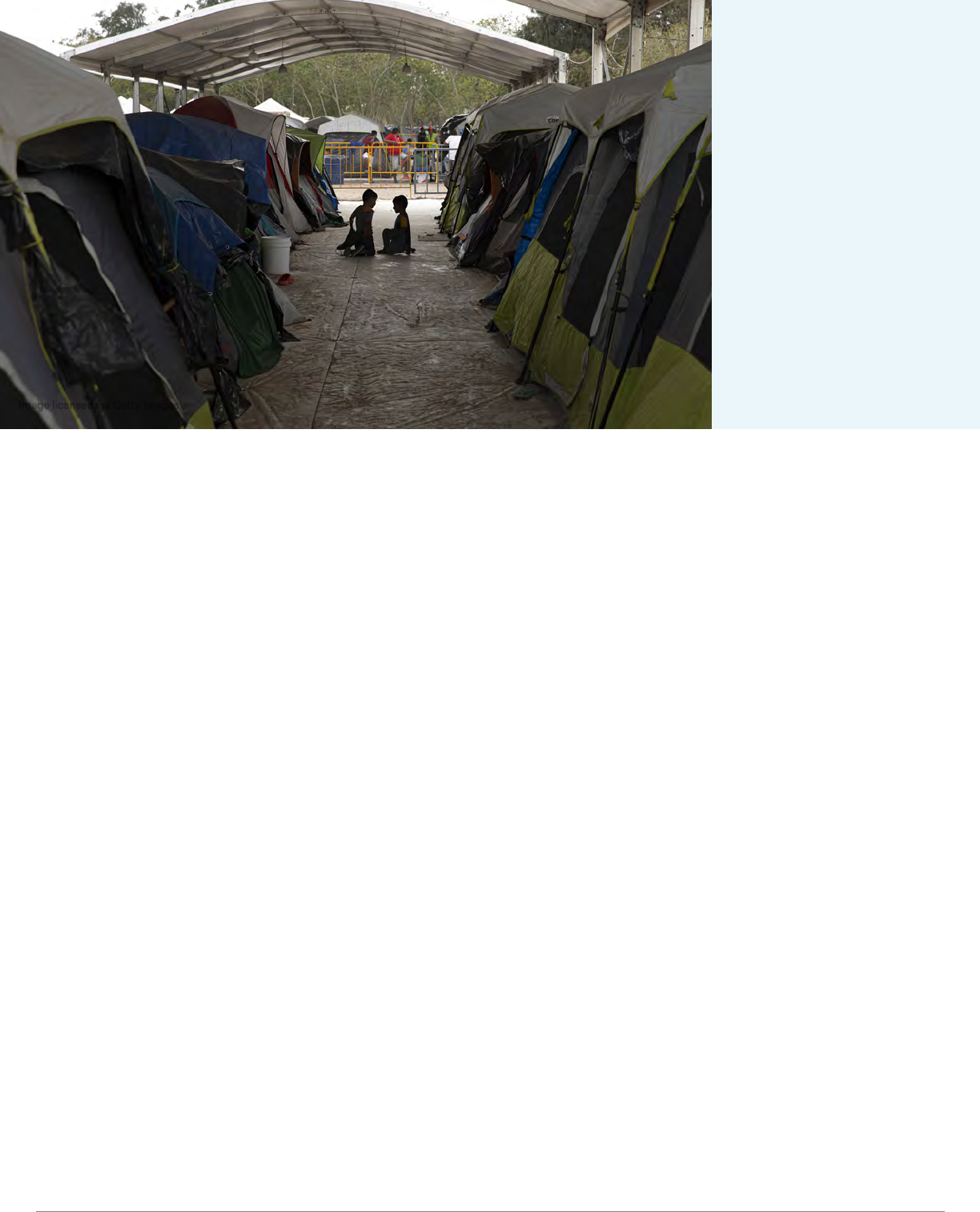
Pushing Back Protection: How Offshoring and Externalization Imperil the Right to Asylum
47
Despite this history, the Mexican government has referred to MPP as an unilateral policy by the
United States, and as the UNHCR has pointed out, MPP is not a legally binding and enforceable
bilateral agreement.
336
Further, UNHCR has concluded that the policy “is not consistent with United
States’ non-refoulement obligation.”
337
The failure of the United States to comply with its federal
laws and international obligations has put tens of thousands of asylum seekers at risk of refoulement.
MPP forced more than 71,021
338
vulnerable people, including thousands of children, to languish
in dangerous conditions in Mexican border towns for the duration of their immigration court
proceedings. There are at least 1,300 documented cases of asylum seekers in MPP subjected to
violence including kidnapping, extortion, torture, rape, and murder.
339
As a result, many children were
forced to leave their parents and travel to the border on their own as unaccompanied minors. Rather
than release these vulnerable children into the custody of family members, the Trump administration
rushed to deport them.
340
MPP amplied a larger problem endemic to U.S. border control; though many of the policies
introduced purport to curb tracking, they have enriched and expanded tracking networks
proting from the U.S.’ oshoring and border externalization measures. By refusing to process
asylum seekers at its borders and cutting nearly all other avenues for people seeking protection to
come to the United States, the U.S. actually forces vulnerable people into the hands of trackers.
According to an April 2021 VICE World News investigation, kidnapping migrants over the last ten
years generated nearly $800 million in ransom payments for tracking networks in Mexico.
341
The U.S.’ policy of pressuring Mexico and countries in Central America to prevent people from
arriving at its borders not only enriches these networks but it pushes asylum seekers to take
more dangerous routes.
Children
at a migrant
camp in
Matamoros,
Mexico.
Image licensed via Getty Images

Pushing Back Protection: How Offshoring and Externalization Imperil the Right to Asylum
48
Impact of the United
States’ Coercive Tactics
on Black Asylum Seekers
Mexican President López Obrador’s
militarization of Mexico’s borders,
particularly its southern border with
Guatemala, has been uniquely cruel
for asylum seekers who endure
transcontinental journeys en route to
the United States, especially Black
asylum seekers.
342
Many Black asylum
seekers remain stranded at Mexico’s
borders. At Mexico’s southern border in
Tapachula, Black migrants face prolonged
detention rife with violence and medical
neglect, anti-Black racism, and other
disparate treatment.
343
Further, because
of restrictive visa and entry/exit policies,
carrier sanction legislation, and increased
enforcement by Mexican authorities,
Black immigrants and asylum seekers
oen face some of the harshest oshoring
and externalization measures.
344
The
deportations of Haitians living in Mexico
increased by 2,330 percent from 2018 to
2019 as a result of the increase in harsh
enforcement measures.
345
In addition to coercing the Mexican government into deploying
their National Guard throughout the country, the U.S. moved
its enforcement even further south when it engaged in an
unauthorized enforcement action with Guatemalan border police
in January 2020.
346
DHS violated an interagency agreement
with the State Department when it secured unmarked vehicles
and drivers to carry out a joint operation in which the U.S. and
Guatemalan authorities physically moved Honduran asylum
seekers across the Guatemala-Honduras border. The U.S. Senate
Foreign Relations Committee found that DHS had lied to the
State Department about their misuse of International Narcotics
Control and Law Enforcement funding, which paid for the
enforcement action.
347
Under the interagency agreement, U.S.
personnel can provide guidance and mentorship but they cannot
carry out immigration enforcement operations. Further, DHS did
not have proper protocols to screen individuals for protection
needs or to prevent the refoulement of asylum seekers, as is
mandatory under U.S. and international law.
5.2. Asylum Cooperative
Agreements: Deporting Asylum
Seekers to Unsafe Third Countries
In another eort to dismantle the U.S. asylum system, the Trump
administration used coercive tactics to enter into third country
agreements with Northern Triangle countries.
348
In March 2019,
the State Department announced
349
that the U.S. would cut
$450 million in foreign assistance programs for El Salvador,
Honduras and Guatemala at the request of President Trump aer
he claimed that they were not doing enough to curb migration
to the U.S.
350
Only months later, in July, the United States and
Guatemala signed an Asylum Cooperative Agreement (ACA).
351
The U.S. would go on to sign similar agreements with Honduras
and El Salvador thereaer.
352
By October 2019, President Trump
announced on Twitter that the U.S. would restart targeted aid in
all three countries: “Guatemala, Honduras & El Salvador have all
signed historic Asylum Cooperation Agreements and are working
to end the scourge of human smuggling. To further accelerate
this progress, the U.S. will shortly be approving targeted
assistance in the areas of law enforcement & security.”
353
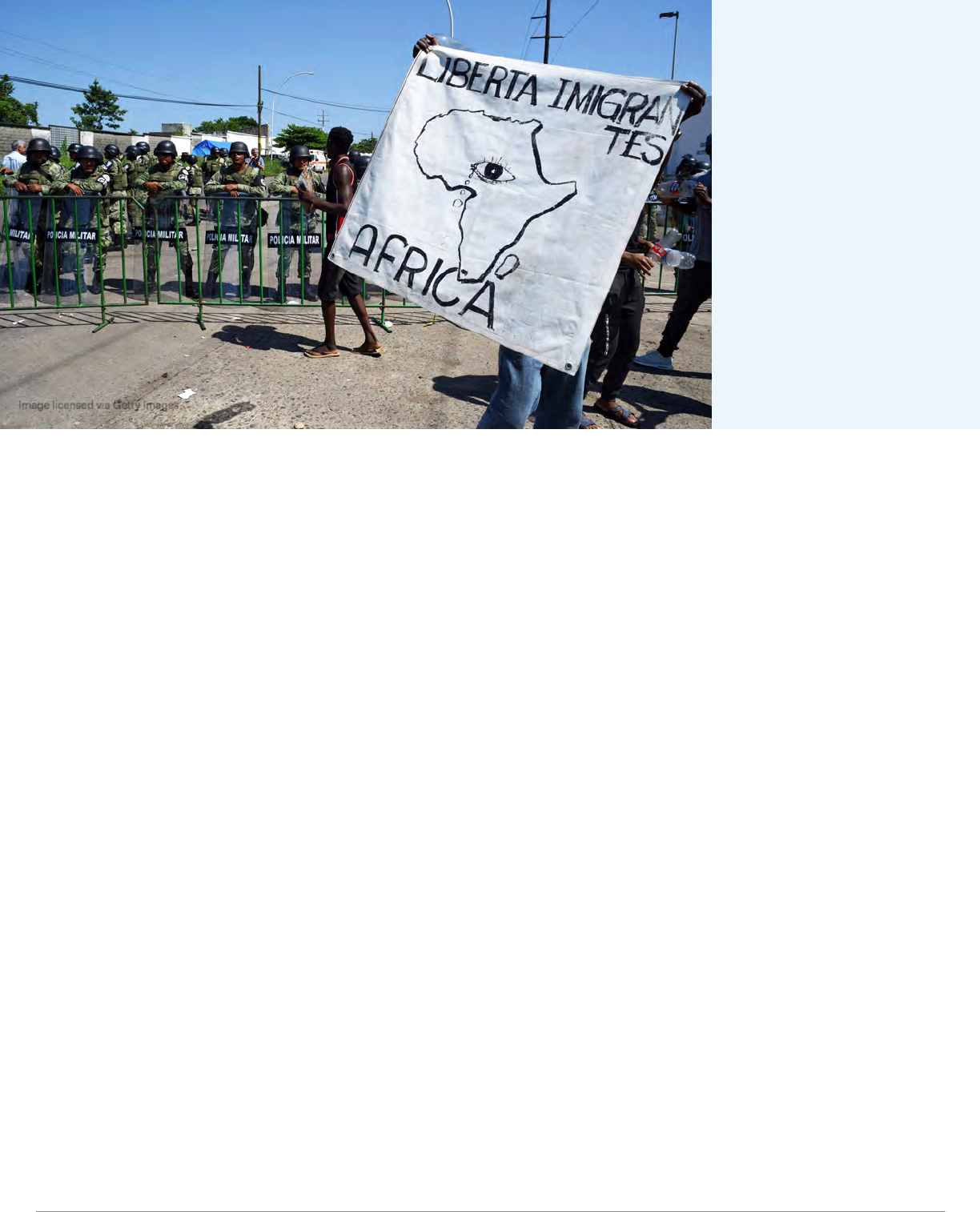
Pushing Back Protection: How Offshoring and Externalization Imperil the Right to Asylum
49
Asylum
seekers from
the continent
of Africa
protest their
entrapment
and detention
in southern
Mexico.
U.S. domestic law has specic provisions regarding safe third country agreements, which the
Trump administration openly outed. The Immigration and Nationality Act requires that in order
for the United States to enter into a compliant safe third country agreement, the Attorney General
must determine that the “life or freedom” of an individual subjected to said agreement “would not
be threatened on account of race, religion, nationality, membership in a particular social group,
or political opinion,” and where the individual, “would have access to a full and fair procedure for
determining a claim to asylum or equivalent temporary protection.”
354
In a report on the ACAs, the
Senate Foreign Relations Committee found that then-Attorney General William Barr and Acting
DHS Secretary Kevin McAleenan’s determination that Guatemala provided a full and fair asylum
procedure was “based on partial truths and [had] ignored State Department concerns.”
355
As the Senate Foreign Relations Committee noted, the U.S.’s third country agreements or ACAs with
Guatemala, El Salvador, and Honduras were reached without regard for U.S. and international law.
356
The ACAs include a formal, bilateral commitment to comply with the principle of non-refoulement “as
outlined in the 1951 Convention and the 1967 Protocol, as well as the Convention against Torture.”
357
However, not one of these Northern Triangle countries employed a full-time sta member
dedicated to asylum as of January 2021.
358
Of the 945 asylum seekers transferred to
Guatemala under the ACA, not one was granted asylum.
359
Despite prompt legal challenges,
360
U.S. transfers of asylum seekers to Guatemala resulted in “deportation[s] with a layover” for these
asylum seekers, most of whom were women and children.
361
In addition to lacking capacity to process asylum seekers, Guatemala, Honduras, and El Salvador
suer from widespread violence and human rights abuses with high murder rates, femicide, and
violence perpetuated against LGBTQ+ individuals. These conditions have caused hundreds of
thousands of asylum seekers to seek refuge in the U.S., and would make it nearly impossible for the
non-refoulement principle enshrined in U.S. and international law to be respected in the context of
third country agreements with these nations.
362
Image licensed via Getty Images

Pushing Back Protection: How Offshoring and Externalization Imperil the Right to Asylum
50
Sophia Sought
Asylum in the U.S.
From Honduras,
Only to be Sent to
Guatemala
Aer her brother was killed
by a gang that subsequently
threatened to take her life in
Honduras, Sophia traveled
more than 2,000 miles on
foot to the U.S. Instead of
oering Sophia a chance to
apply for asylum in the U.S.,
DHS transferred Sophia to
Guatemala, a country with one
of the highest murder rates in
the world: “They put me on a
plane I thought was taking me
back to Honduras, but then
we landed in Guatemala. I was
told I could seek asylum there
instead. I was completely lost.
[...] Safe in Guatemala? What’s
safe about that place? It’s the
same as Honduras. I don’t
know anyone in Guatemala. I
had to come home.”
363
Ironically, the ACAs are not the rst safe third country agreements involving
the U.S. that have been called into question in the courts. Aer years of
negotiation and with input from human rights experts, the United States
entered into a safe third country agreement with Canada in December
2002.
364
In July 2020, the agreement was found invalid by a federal judge
in Canada for violating the Canadian Charter of Rights and Freedoms, aer
asylum seekers whom Canada had returned to the United States alleged
that they were not safe there largely due to their heightened risk of detention
in alarming conditions.
365
However, in April 2021, a Canadian appeals court
sided with the Canadian government and overturned the lower court’s
ruling.
366
At the time of this writing, litigators representing the asylum
seekers were considering the possibility of appealing to the Supreme Court
of Canada.
367
Nonetheless, the United States’ apparent failure to comply
with this agreement domestically raises questions as to its ability to assist
other countries, including Mexico and nations in Central America, in the
development of their own asylum systems.
Policies such as MPP and the ACAs have set a dangerous precedent of
illegal and inhumane oshoring practices for future administrations, and
vulnerable people are still waiting for relief. In the early months of the
Biden administration, the U.S. State Department
368
and the Department of
Homeland Security
369
announced the suspension and termination of MPP,
ACAs, and a review of other harsh immigration measures. As of May 2021, the
Biden administration had admitted 10,000 asylum seekers with active MPP
cases to the United States to pursue their asylum claims, though a majority
of individuals with active cases were still waiting in Mexico.
370
The Biden
administration later expanded
371
eligibility to asylum seekers whose cases had
been closed by the Trump administration. However, asylum seekers awaiting
processing are still languishing in dangerous cities along the U.S.-Mexico
border. For 19-year-old Cuban asylum seeker Cristian San Martín Estrada,
MPP cost him his life;
372
Estrada was tragically shot dead just days before his
chance to enter the United States. Undoing the harms of MPP and the ACAs
not only requires expeditious processing, but also dismantling the lasting
eects of U.S. border externalization in Mexico and Central America.
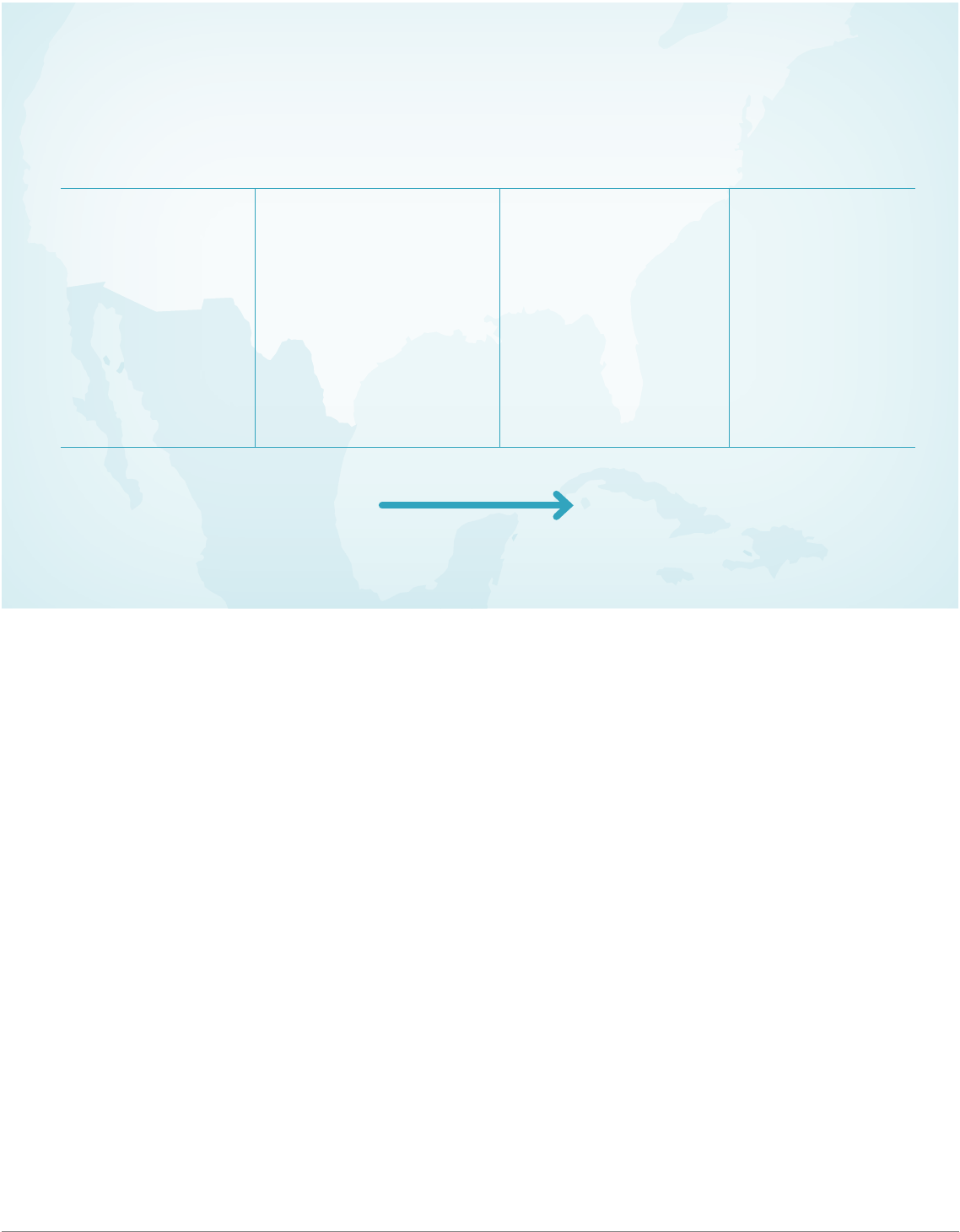
Pushing Back Protection: How Offshoring and Externalization Imperil the Right to Asylum
51
U.S Offshoring and Externalization Policies
BY THE NUMBERS (2017-2021)
expulsions of children
and adult migrants
and asylum seekers
under Title 42
373
vulnerable migrants
and asylum seekers
pushed back to
Mexico under MPP
374
documented cases
of people in MPP
subjected to violent
acts; murder,
kidnapping, torture,
rape and extortion
375
asylum seekers
on metering lists
as of May 2021
376
asylum seekers transferred to
Guatemala under the ACA
948,631 71,021 1,300 18,680
945
5.3. Title 42 Expulsions: a Recycled Pretext For
Refoulement Under the Guise of Public Health
In March 2020, the CDC issued an unprecedented order that resulted in the expulsions of asylum
seekers and children seeking protection. At the behest of then-Vice President Mike Pence and
White House Senior Advisor Stephen Miller, the CDC morphed an obscure quarantine provision
of the Public Health Service Act of 1944 under Title 42 of the U.S. code into a near impenetrable
tool to prevent migration, steamrolling the subsequent six decades of supervening domestic and
international obligations toward asylum-seeking adults and children. Emboldened by the CDC, U.S.
Customs and Border Protection proceeded to expel migrants and asylum seekers en masse.
378
The
Biden administration has since failed to end its use of this policy, and at the time of this report, Title
42 remained in eect despite the change in administration—and has continued amidst resounding
opposition from public health experts. As of July 2021, the United States carried out 948,631
expulsions of migrants and asylum seekers under Title 42. This number includes repeated attempts
of many individuals, with no other viable means to pursue asylum.
0
granted
asylum
377
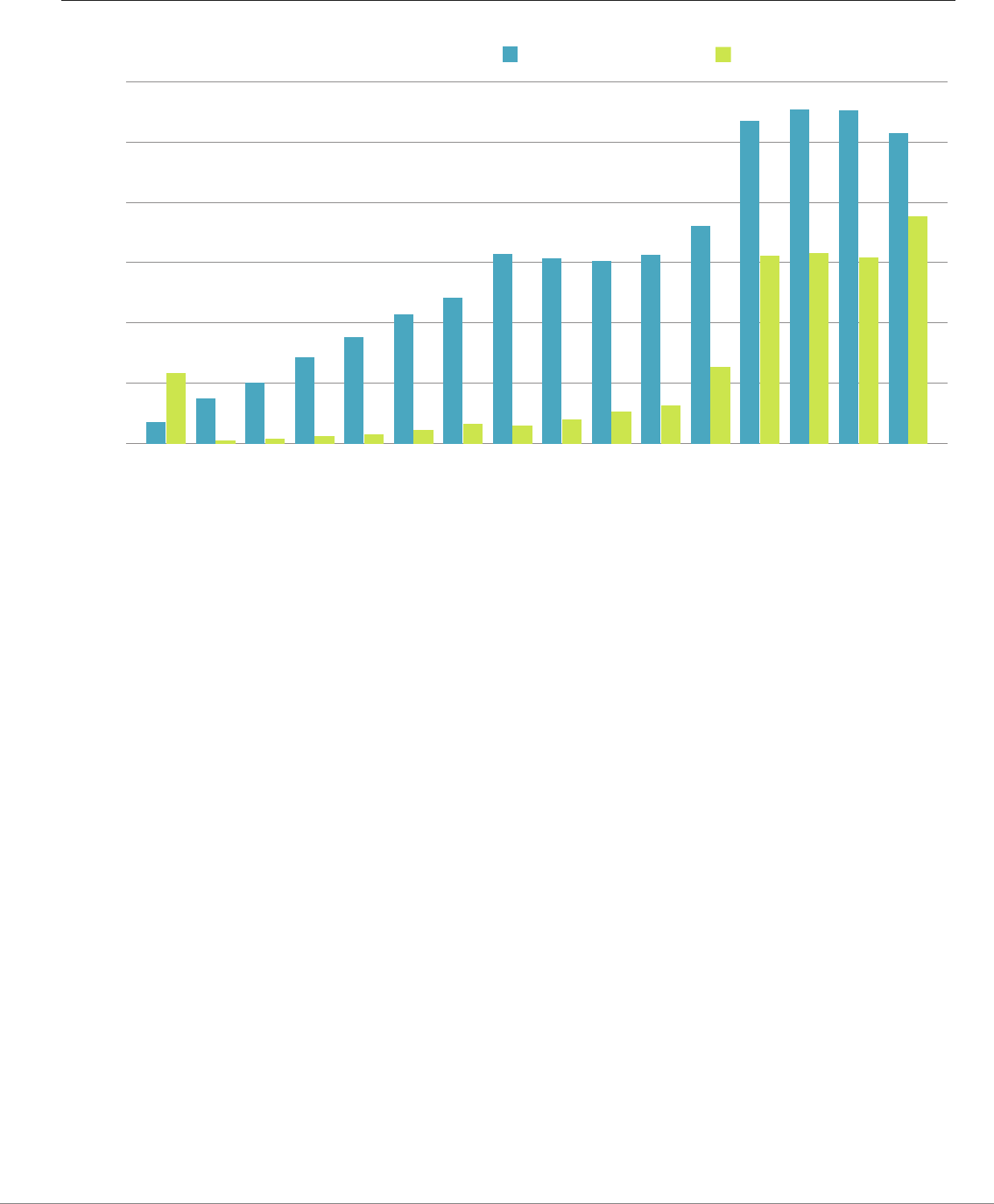
Pushing Back Protection: How Offshoring and Externalization Imperil the Right to Asylum
52
Title 42 Expulsions vs. Regular Border Processing
Source: U.S. Customs and Border Protection
President Biden’s continued use of Title 42 expulsions imperil the administration’s compliance with
the principle of non-refoulement. Under the Trump administration, Stephen Miller attacked migrants,
asylum seekers, and refugees through a storm of policy changes, including the exploitation of public
health as a pretext to prevent migration.
379
Between the CDC order and the Biden administration’s
continued expulsions, Miller’s scheme is thriving. The Biden administration has far exceeded Trump’s
monthly expulsion rate and is rapidly nearing one million expulsions to date. Tragically, this number
includes many people who have been previously expelled or turned back;
380
Title 42 not only violates
asylum seekers’ rights; it fails to meet its own goal to deter migration.
381
Expelled asylum seekers have been subjected to rape, kidnapping, and assault in Mexico;
382
LGBTQ+
and Black asylum seekers are particular targets for violence as the Biden administration pushes
them back to Mexico.
383
This policy has also been an informal vehicle for family separations, harming
children whose parents either lose hope of entering in the U.S. or suer abductions.
384
0
20000
40,000
60,000
80,000
100,000
120,000
2020 2021
Mar Apr May Jun Mar Apr May JunJul Aug Sep Oct Nov Dec Jan Feb
Title 42 Expulsions
Regular Border Processing

Pushing Back Protection: How Offshoring and Externalization Imperil the Right to Asylum
53
Meanwhile, three federal judges have determined that Title 42 does not permit the expulsion
of unaccompanied children, nor does it supersede domestic asylum law incorporating non-
refoulement.
385
UNHCR has joined the call to end this harmful policy, citing “[g]uaranteed access to
safe territory and the prohibition of pushbacks of asylum-seekers” as core principles of the Refugee
Convention.
386
A group of 170 public health experts have debunked any scientic rationale for the
policy, calling mass expulsions “xenophobia masquerading as a public health measure.”
387
While
health screenings are advised, there is no evidence that walling o asylum seekers will mitigate the
spread of infectious diseases.
388
Public health experts and epidemiologists have oered to support
the CDC in addressing public health concerns while protecting asylum seekers.
389
Yet, the Biden
administration has failed to harness this expertise to mitigate the spread of communicable diseases
without compromising asylum law.
President Biden has stated that he is working to achieve a “fair, orderly, humane” immigration
system.
390
And yet, his administration has doubled down on Title 42, which targets primarily
Black, Brown, and Indigenous asylum seekers and presents them as a threat to U.S. public health.
Expulsions have disproportionately harmed Haitians again, sending thousands of Haitian families,
including small children, back to danger.
391
During the rst ve months of Biden’s presidency, over
3,250 migrants and asylum seekers have reportedly suered kidnappings or other violence as U.S.
authorities blocked their entry or expelled them to Mexico.
392
This continued use of Title 42, with few
exceptions
393
and carve-outs,
394
is a troubling reminder of the health screenings previously used as
pretext to push back non-European migrants and Haitian asylum seekers.
395
These expulsions are not the only vehicle the Biden administration contemplates to halt the arrival
of asylum seekers. The U.S. has continued negotiations with Central American nations and Mexico
to further militarize and seal these countries’ borders.
396
On April 12, 2021, Reuters reported that
the United States had reached agreements with Mexico, Honduras, and Guatemala to “place
more troops on their borders,”
397
while plans to pave the way for new ACAs may lay dormant within
proposed partnerships with Central American nations.
398
During the first five months of Biden’s presidency, over 3,250 migrants and asylum
seekers have reportedly suffered kidnappings or other violence as U.S. authorities
blocked their entry or expelled them to Mexico. This continued use of Title 42, with few
exceptions and carve-outs, is a troubling reminder of the health screenings previously
used as pretext to push back non-European migrants and Haitian asylum seekers.

Pushing Back Protection: How Offshoring and Externalization Imperil the Right to Asylum
54
“I keep waiting, but there is no answer… The truth is I don’t feel safe here. There’s
nothing for me and my family here. But I don’t have anywhere else to go.”
— Honduran asylum seeker sent by the U.S. to Guatemala, where not a
single asylum seeker was granted protection.
399
CHAPTER 6
Closing Recommendations:
Learning the Lessons of
Failed, Deadly, and Costly
Offshoring and Externalization
Practices Across the World
The recent asylum policies of the EU, Australia, and the U.S. have one fundamental flaw:
their apparent forgetting of the moral and political failures that made the principle of
non-refoulement a vital necessity in the aftermath of the Holocaust.
Despite ratifying the
Refugee Convention and/or 1967 Protocol and incorporating their principles into domestic law,
these auent nations continue to respond with callous push-backs. In particular, oshoring and
externalization practices betray these auent nations’ desire to circumvent humanitarian obligations,
ooad their duties on less fortunate, peripheral, or remote nations, and villainize asylum seekers.
Though they are oceans away from each other, these auent nations use the same playbook.
Framing primarily Black and Brown asylum seekers as a threat, they adopt policies that make safe
routes to their nations nearly impossible to access. The few remaining routes become dangerous
bottlenecks that incentivize the exploitation of asylum seekers and generate desperation. When
this desperation comes knocking, a few hundred or thousand asylum seekers become a “crisis” for
these auent and populous nations. Governmental leaders xate on the physical border and how to
push back asylum seekers to peripheral countries, while international and domestic laws suddenly
appear malleable. Auent nations turn outward to halt migration and erect indenite oshore
facilities abroad. Meanwhile, their domestic asylum systems remain underfunded, outdated, and

Pushing Back Protection: How Offshoring and Externalization Imperil the Right to Asylum
55
ill-equipped to meet the needs of asylum seekers. Rather than funding domestic asylum processing
and complying with non-refoulement, ocials hope to deter asylum seekers through presumptive
detention onshore, or expulsions and indenite detention oshore.
The impact on asylum seekers is predictably devastating, exposing them to physical violence,
torture, tracking, mental health crises, and even death. Nevertheless, this grim record has done
little to deter auent nations from pursuing these harmful policies. Restrictionist policies remain
widespread, repeating historical patterns across the globe. It is no coincidence that the violations
of international law on one side of the globe—e.g., Haitians jailed indenitely in Guantánamo Bay—
become a blueprint
400
for similar programs on the other—e.g., Australia’s “Pacic solution,” or
oshoring aspirations in the U.K. Given their powerful status, auent nations’ anti-asylum policies
set harmful precedents that undermine protection for asylum seekers worldwide—even beyond
their active exchange of proposals and consultation on adapting externalization policies at the local
level.
401
Unsurprisingly, the U.S. has been a lead architect for oshoring practices, even guiding
Australia on maritime push-back and externalization policies.
How can we avert a new iteration of Nauru and Manus? Guantánamo and the ACAs? Or Turkey and
Libya’s agreements with Europe? If a blueprint is emerging, so are the lessons that the U.S. must
nally learn:
1. Harsh deterrence policies do not work, because asylum seekers do not leave their
homes voluntarily. These measures, which bolster oshoring and externalization, perpetuate
chaos and are shown to produce no discernable drop in migration, because asylum seekers ee
from greater harms.
402
Preventing asylum seekers from reaching the United States continues
to inform the Biden administration’s approach,
403
even while they unwind MPP and rescind the
ACAs. The continued expulsions under a specious public health rationale foreshadows further
oshoring/externalization practices, particularly as it relates to the militarization of Mexico’s
southern border. Abandoning harsh deterrence policies is key to ending oshoring and
border externalization once and for all.
The impact on asylum seekers is predictably devastating, exposing them to
physical violence, torture, trafficking, mental health crises, and even death.
Nevertheless, this grim record has done little to deter affluent nations from
pursuing these harmful policies.

Pushing Back Protection: How Offshoring and Externalization Imperil the Right to Asylum
56
2. Third country agreements with less auent nations are not the solution either. The U.S.
exerts signicant political control over its neighbors and other developing nations. Whether
coercive or seemingly voluntary, these agreements export border militarization and bargain with
the right to asylum. They also compound the harms asylum seekers suer, as seen most recently
in Turkey and Mexico. Most importantly, these agreements serve short-term political ends, not
international obligations. As UNHCR’s basic threshold of protection shows (see Chapter 1),
qualifying as a “safe” third country requires signicant measures to ensure the welfare of asylum
seekers. Rather than investing in costly externalization or oshoring agreements, the
U.S. should ensure that it does not ooad its obligations onto ill-equipped nations with
limited capacity or no capacity at all to process asylum seekers.
3. There is no “right way” to seek asylum. Auent nations xate on “lawful” ways to seek
refuge, at times pitting refugees against asylum seekers, or discriminating between asylum
seekers who arrive by sea and land from other noncitizen travelers. The mode of entry of asylum
seekers is irrelevant to the protection they seek. That is why ongoing sea interdiction, expulsions,
and unequal treatment toward individuals entering between ports of entry must end. Historically,
the xation on unauthorized migration has been selective, and deeply discriminatory. The U.S.
cannot abide by the principle of non-refoulement by ascribing fault to asylum seekers
depending on their mode of entry.
404
4. Closing legal loopholes that skirt non-refoulement obligations is key to enforcing
asylum protections. Sea interdictions, expulsions, and other forms of push-backs over the past
decades have relied on workarounds to suspend this fundamental protection owed to asylum
seekers. The principle of non-refoulement does not disappear because U.S. authorities block
asylum seekers’ arrival. Unlike Hirsi Jamaa v. Italy in the EU context, Sale v. Haitian Refugee
Centers opened the door for the U.S. Coast Guard and DHS to push back migrants outside of
U.S. territory. Restoring the broad scope of non-refoulement obligations is key to fullling
U.S. obligations under international law—as is granting asylum seekers access to
justice when the U.S. refouls them.
5. Proxy border control, where the U.S. seeks to halt the arrival of asylum seekers through
agreements with governments or with private carrier companies, breeds tracking
and deadly journeys. Like Australia and the EU, the U.S. has invested extensive resources
into externalization regimes in the public and private sector. Those agreements have proven
deadly, as other nations brutalize asylum seekers on the U.S.’ behalf.
405
Though outsourced, this
interference with asylum seekers on their journey—while they ee life-threatening harm—turns
asylum law on its head. The U.S. should end proxy migrant control regimes, such as DHS’
agreement with Panama, or the recent agreement that the U.S. brokered with Central American
nations and Mexico to “place more troops on their borders”— and expand safe pathways for
asylum seekers to come to the United States.

Pushing Back Protection: How Offshoring and Externalization Imperil the Right to Asylum
57
6. Asylum oshoring thrives on the presumption of detention; we cannot end one without
ending the other. The recent legal challenge to the U.S.-Canada safe third country agreement,
though subject to ongoing litigation, named the elephant in the room: even among auent
nations, safe third country agreements may violate asylum seekers’ rights if repressive detention
policies are commonplace. Unsurprisingly, the U.S. has built the largest detention apparatus in
the world;
406
the system, built in tandem with the brutal repression of Haitian asylum seekers,
taps into the same racism that has fueled the mass incarceration of Black and Brown people in
communities across the United States. In the 21st century, this warped logic continues to justify
anti-asylum policies, such as a deliberate misinterpretation of Title 42, which returns asylum
seekers to harm. Individuals seeking asylum in the United States should be processed in the
United States in accordance with domestic and international law. Instead of incarcerating
asylum seekers, the U.S. can unlearn its instinct to detain, and shi resources toward
community-based civil society organizations to support asylum seekers—hundreds of
which are waiting at the ready.
407
7. Managing asylum policy through a lens of political crisis management endangers
the right to asylum and the U.S. asylum system and permits government leaders to
perpetuate thinly veiled racism. Auent nations’ leaders frequently criminalize and vilify
predominantly Black, Brown, and Indigenous asylum seekers as representing an external
threat or a “foreign invasion.” The existence of people seeking asylum is not a crisis to quickly
repress, but representative of binding legal obligations. Divesting from a crisis-management
response and investing in domestic asylum processing systems will shield asylum
seekers and the United States from short-term politically motivated policies which are
dangerous and ineective.
The Biden administration has a unique opportunity to build a new humanitarian asylum system not
built upon the primacy of deterrence, enforcement, and detention—tried and failed policies that have
spelled immeasurable harm for asylum seekers. These same policies, paired with a history of white
supremacy, have also made oshoring and border externalization possible. As our report shows, U.S.
oshoring and border externalization long predates the now-rescinded ACA with Guatemala, and
has returned in many iterations since the early 20th century. No deterrence policy will end the arrival
of asylum seekers. Every dollar spent on oshoring or externalization practices is one less dollar to
build humane and ecient asylum processing domestically.
Only by investing in a robust domestic humanitarian reception system that treats asylum
seekers fairly and with dignity can we avert a return to oshoring and externalization
policies in the long term—in the U.S. and worldwide.
408

58
Pushing Back Protection: How Offshoring and Externalization Imperil the Right to Asylum
1. Convention relating to the Status of Refugees, July 28, 1951,
19 U.S.T. 6259, 189 U.N.T.S. 150, https://www.ohchr.org/en/
professionalinterest/pages/statusofrefugees.aspx.
2. Protocol relating to the Status of Refugees, October 4, 1967,
19 U.S.T. 6223, 606 U.N.T.S. 267, https://www.ohchr.org/EN/
ProfessionalInterest/Pages/ProtocolStatusOfRefugees.aspx.
3. Peter Yeung, “‘Like torture’: Calais police accused of continued
migrant rights abuses,” Guardian, January 13, 2021, https://www.
theguardian.com/global-development/2021/jan/13/like-torture-
calais-police-accused-of-continued-migrant-rights-abuses.
4. Yeung, “‘Like torture.’”
5. “Mexico doubles migrant detentions with troop surge, White House
says,” Reuters, April 12, 2021, https://www.reuters.com/article/us-
usa-immigration-troops/mexico-honduras-guatemala-to-increase-
troops-along-borders-white-house-ocial-idUSKBN2BZ1V2
(“Earlier, White House aide Tyler Moran said the Biden administration
secured agreements with Mexico, Honduras and Guatemala to
put more troops on their own borders.”); “Readout of Secretary
Mayorkas’s Trip to Guatemala,” Department of Homeland Security,
July 8, 2021, https://www.dhs.gov/news/2021/07/08/readout-
secretary-mayorkas-s-trip-guatemala (“To further enhance security
and facilitate lawful travel, U.S. Customs and Border Protection
signed a Memorandum of Understanding with the Guatemalan
Institute of Migration to implement the Automated Targeting System
— Global in Guatemala.”).
6. Sarah Stillman, “When Deportation Is A Death Sentence,”
New Yorker, January 8, 2018, https://www.newyorker.com/
magazine/2018/01/15/when-deportation-is-a-death-sentence
(President Franklin Roosevelt had warned the public that Jews
posed a national-security threat, and argued for tighter restrictions
on their numbers. “In some of the other countries that refugees out
of Germany have gone to, especially Jewish refugees, they found a
number of denitely proven spies,” he said at a press conference.);
Rafael Medo, “What FDR said about Jews in private,” LA Times,
April 7, 2013, https://www.latimes.com/opinion/la-xpm-2013-apr-
07-la-oe-medo-roosevelt-holocaust-20130407-story.html.
7. Importantly, the United States did not join the international
community in protecting refugees until 1967, when the country
ratied the 1967 Protocol relating to the Status of Refugees. It
took an additional 13 years for the United States to codify key
Protocol principles into domestic law, in the Refugee Act of 1980.
As we discuss in Chapter 4 and 5, those principles were imperiled
further in the four decades that followed with U.S. oshoring and
externalization practices.
8. United Nations, Universal Declaration of Human Rights, December
10, 1948, https://www.un.org/en/about- us/universal- declaration-of-
human-rights.
9. American Convention on Human Rights, November 22, 1969,
1144 U.N.T.S. 123, http://www.oas.org/en/iachr/mandate/Basics/
convention.asp; African (Banjul) Charter on Human and Peoples’
Rights, arts.4, 7, June 27, 1981, https://www.achpr.org/public/
Document/le/English/banjul_charter.pdf; European Convention
on Human Rights and Fundamental Freedoms, Sept. 3, 1953, 213
U.N.T.S. 222, https://www.echr.coe.int/Documents/Convention_ENG.
pdf; “Cartagena Declaration on Refugees, Colloquium on the
International Protection of Refugees in Central America, Mexico and
Panama,” Refworld, November 22, 1984, https://www.refworld.org/
docid/3ae6b36ec.html; OAU Convention Governing the Specic
Aspects of Refugee Problems in Africa, September 10, 1969, 1001
U.N.T.S. 45, https://www.unhcr.org/45dc1a682.html; Convention
against Torture and Other Cruel, Inhuman or Degrading Treatment or
Punishment, Dec. 10, 1984, 1465 U.N.T.S. 85, https://www.ohchr.org/
EN/ProfessionalInterest/Pages/CAT.aspx.
10.
Convention Relating to the Status of Refugees.
11. Protocol Relating to the Status of Refugees.
12. “Asylum and the Rights of Refugees,” International Resource Justice
Center, April 23, 2021, https://ijrcenter.org/refugee-law/#What_
Rights_Do_Refugees_Have.
13.
United Nations High Commissioner for Refugees, “Advisory Opinion
on the Extraterritorial Application of Non-Refoulement Obligations
under the 1951 Convention relating to the Status of Refugees and
its 1967 Protocol,” 2-3, January 26, 2007, https://www.unhcr.
org/4d9486929.pdf.
14.
Antônio Augusto Cançado Trindade, “Jus Cogens: The Determination
and the Gradual Expansion of its Material Content in Contemporary
International Case-Law,” https://www.oas.org/dil/esp/3%20-%20
cancado.LR.CV.3-30.pdf.
15.
Executive Committee of the High Commissioner’s Programme,
“General Conclusion on International Protection,” UNHCR, October
20, 1982, https://www.unhcr.org/en-us/excom/exconc/3ae68c434c/
general-conclusion-international-protection.html.
16.
Executive Committee of the High Commissioner’s Programme,
“General Conclusion on International Protection,” UNHCR, October
11, 1996, https://www.unhcr.org/excom/exconc/3ae68c430/general-
conclusion-international-protection.html. Although prominent legal
scholars claim the principle of non-refoulement is non-derogable (a
key factor for jus cogens determination, which bars countries from
deviating from the norm or principle in question,) others contend
that there is no clear consensus yet on the matter. Interestingly, this
ambiguity dissipates when the harm one ees rises to the level of
torture, a higher threshold than persecution; the principle of non-
refoulement is “absolute and non-derogable” for individuals who are
at risk of torture, as laid out by the UN Committee Against Torture’s
General Comment no 4.
17.
United Nations High Commissioner for Refugees (UNHCR), “States
Party to the 1951 Convention Relating to the Status of Refugees
and the 1967 Protocol,” April 2015, https://www.unhcr.org/protect/
PROTECTION/3b73b0d63.pdf.
18.
Michelle Foster, “Protection Elsewhere: The Legal Implications of
Requiring Refugees to Seek Protection in Another State,” Michigan
Journal of International Law 28, no. 2 (2007): 228, 244, 286, https://
repository.law.umich.edu/mjil/vol28/iss2/1.
19.
Executive Committee of the High Commissioner’s Programme,
“Problem of Refugees and Asylum-Seekers Who Move in an
Irregular Manner from a Country in Which They Had Already Found
Protection,” UNHCR, October 13, 1989, https://www.unhcr.org/
excom/exconc/3ae68c4380/problem-refugees-asylum-seekers-
move-irregular-manner-country-already-found.html.
Endnotes

59
Pushing Back Protection: How Offshoring and Externalization Imperil the Right to Asylum
20. Executive Committee of the United Nations High Commissioner for
Refugees, “Problem of Refugees and Asylum-Seekers Who Move
in an Irregular Manner from a Country in Which They Had Already
Found Protection No. 58 (XL),” October 13, 1989, https://www.unhcr.
org/excom/exconc/3ae68c4380/problem-refugees-asylum-seekers-
move-irregular-manner-country- already-found.html.
21.
Executive Committee of the United Nations High Commissioner
for Refugees, “Refugees Without an Asylum Country No. 15
(XXX),” October 16, 1979, https://www.unhcr.org/en-us/excom/
exconc/3ae68c960/refugees-asylum-country.html.
22.
Bill Frelick, Ian M. Kysel, and Jennifer Podkul, “The Impact of
Externalization of Migration Controls on the Rights of Asylum
Seekers and Other Migrants,” Journal on Migration and Human
Security, 4, no. 4 (2016): 195-96, https://doi.org/10.1177%
2F233150241600400402.
23.
Camilo Montoya-Galvez, “ACLU les lawsuit to halt Trump policy
of sending asylum-seekers to Guatemala,” CBS News, January 15,
2020, https://www.cbsnews.com/news/aclu-les-lawsuit-to-halt-
trump-policy-of-sending-asylum-seekers-to- guatemala/.
24.
Government of Canada, “Canada-U.S. Safe Third Country
Agreement,” July 23, 2020, https://www.canada.ca/en/ immigration-
refugees-citizenship/corporate/mandate/policies-operational-
instructions-agreements/agreements/safe-third-country-agreement.
html.
25.
European Union, “Council Directive 2005/85/EC of 1 December 2005
on minimum standards on procedures in Member States for granting
and withdrawing refugee status,” 2005 O.J. (L 326) 25-26, http://data.
europa.eu/eli/dir/2005/85/oj; European Union, “Directive 2013/32/
EU of the European Parliament and of the Council of 26 June 2013
on common procedures for granting and withdrawing international
protection,” 2013 O.J. (L 180) 79-80, http://data.europa.eu/eli/
dir/2013/32/oj. The Asylum Procedures Directive (APD) provided
the minimum procedural standards for EU states in the granting and
withdrawing of protection. In the APD, Article 27 (Article 38 in the
2013 recast Directive) allows Member States to deny protection to
asylum seekers they may have transited through a so-called safe-
third country. European Council on Refugees and Exiles & United
Nations High Commissioner for Refugees, “The Asylum Procedures
Directive,” https://www.unhcr.org/4a9d12ef9.pdf; European Union,
“Regulation (EU) No 604/2013 of the European Parliament and of the
Council of 26 June 2013 establishing the criteria and mechanisms
for determining the Member State responsible for examining an
application for international protection lodged in one of the Member
States by a third-country national or a stateless person,” 2013 O.J. (L
180), http://data.europa.eu/eli/reg/2013/604/2013-06-29.
26.
María-Teresa Gil-Bazo, “The Safe Third Country Concept in
International Agreements on Refugee Protection Assessing State
Practice,” Netherlands Quarterly of Human Rights, 33, no. 1 ( 2015):
43-44, https://doi.org/10.1177%2F016934411503300104.
27.
Foster, “Protection Elsewhere,” 226, 230.
28. Emanuela Roman, Theodore Baird, and Talia Radclie, “Analysis:
Why Turkey is Not a ‘Safe Country,’” Statewatch, (February 2016): 6,
https://www.statewatch.org/media/documents/analyses/no-283-
why-turkey-is-not-a-safe-country.pdf; Agnès Hurwitz, “Safe Third
Country Practices, Readmission, and Extraterritorial Processing,”
in The Collective Responsibility of States to Protect Refugees (New
York: Oxford University Press Inc., 2009), 46-56; Convention Relating
to the Status of Refugees, art. 31(2) of the Refugee Convention, titled
Refugees unlawfully in the country of refuge, is interpreted out of
context.
29.
Violeta Moreno-Lax, “The Legality of the ‘Safe Third Country’
Notion Contested: Insights from the Law of Treaties,” The Centre
for Studies and Research in International Law and International
Relations (2015): 665- 721, http://dx.doi.org/10.1163/1875-
8096_pplcdu_ej.9789004301238.ch20. Guy S. Goodwin-Gill and
P. Weckel, Migration and Refugee Protection in the 21st Century:
Legal Aspects, (Martinus Nijho: Centre for Studies and Research in
International Law and International Relations, 2015): 665-721. Legal
scholars insist that the provision must be interpreted in the context
in which it is written within the Refugee Convention, and they specify
that refugee protections cannot be denied based on routes of transit.
30.
Foster, “Protection Elsewhere,” 227, 236-237.
31. UN High Commissioner for Refugees, “Summary Conclusions on
the Concept of ‘Eective Protection’ in the Context of Secondary
Movements of Refugees and Asylum-Seekers (Lisbon Expert
Roundtable),” December 9-10, 2002, https://www.refworld.org/
docid/3fe9981e4.html.
32.
UN High Commissioner for Refugees, “Guidance Note on bilateral
and/or multilateral transfer arrangements of asylum-seekers,” May
2013, p. 2, https://www.refworld.org/docid/51af82794.html.
33.
UN High Commissioner for Refugees, “Legal Considerations
regarding access to protection and a connection between the
refugee and the third country in the context of return or transfer to
safe third countries,” April 2018, p. 2, https://www.refworld.org/
docid/5acb33ad4.html; Executive Committee of the United Nations
High Commissioner for Refugees, “Conclusion on International
Protection No. 85 (XLIX),” October 9, 1999, https://www.unhcr.
org/en-us/excom/exconc/3ae68c6e30/conclusion-international-
protection.html.
34.
UNHCR, “Guidance Note,” 2; UNHCR, “Legal considerations,” 2.
35. The UNHCR’s 2018 guidelines, “Legal considerations,” claried
that some transfer agreements can avoid individual assessments if
adequate protections can be obtained in the receiving State and all
other guarantees outlined are still respected. However, individual
assessments are always required for unaccompanied children and
other vulnerable groups.
36.
Luca Lixi, “Beyond Transactional Deals: Building Lasting Migration
Partnerships in the Mediterranean,” Transatlantic Council on
Migration and Migration Policy Institute Europe, November
2017, 4-6, https://www.migrationpolicy.org/sites/default/les/
publications/TCM-Partnerships-Mediterranean-FINAL.pdf; Anja
Palm, “The Italy-Libya Memorandum of Understanding: The baseline
of a policy approach aimed at closing all doors to Europe?, EU
Immigration and Asylum Law and Policy (blog), October 2017,
https://eumigrationlawblog.eu/the-italy-libya-memorandum-of-
understanding-the-baseline-of-a-policy-approach-aimed-at-closing-
all-doors-to-europe/. We discuss the Italy-Libya agreement further in
Chapter 2.
37.
Hirsi Jamaa and Others v. Italy, Application no. 27765/09, Council of
Europe: European Court of Human Rights, February 23, 2012, https://
hudoc.echr.coe.int/eng#{%22itemid%22:[%22001-109231%22]}.
38.
Seunghwan Kim, “Non-Refoulement and Extraterritorial Jurisdiction:
State Sovereignty and Migration Controls at Sea in the European
Context,” Leiden Journal of International Law, December 13,
2016, https://www.cambridge.org/core/journals/leiden-journal-
of-international-law/article/nonrefoulement-and-extraterritorial-
jurisdiction-state-sovereignty-and-migration-controls-at-sea-in-
the-european-context/DEB19084E3229F6950496F3F8044CAC6/
core-reader.

60
Pushing Back Protection: How Offshoring and Externalization Imperil the Right to Asylum
39. “Italy: ‘Historic’ European Court judgment upholds migrants’ rights,”
Amnesty International, February 23, 2012, https://www.amnesty.org/
en/latest/news/2012/02/italy-historic-european-court-judgment-
upholds-migrants-rights/.
40.
Hirsi Jamaa and Others v. Italy, para. 81.
41. “Memorandum of understanding on cooperation in the elds
of development, the ght against illegal immigration, human
tracking and fuel smuggling and on reinforcing the security of
borders between the State of Libya and the Italian Republic,” EU
Immigration and Asylum Law and Policy (blog), October 2017,
http://eumigrationlawblog.eu/wp-content/uploads/2017/10/
MEMORANDUM_translation_nalversion.doc.pdf.
42.
“Crisis 101: Central America Displacement Crisis Explained,” USA for
UNHCR, January 6, 2021, https://www.unrefugees.org/news/central-
america-displacement-crisis-explained/.
43.
Bill Frelick, “We pay Mexico to catch refugees. Kids suer,”
Human Rights Watch, April 20, 2016, https://www.hrw.org/
news/2016/04/20/we-pay-mexico-catch-refugees-kids-suer#.
44.
Victoria Rietig and Rodrigo Dominguez Villegas, “Changing
Landscape Prompts Mexico’s Emergence as a Migration Manager,”
Migration Policy Institute, December 10, 2014, https://www.
migrationpolicy.org/article/changing-landscape-prompts-mexicos-
emergence-migration-manager.
45.
Barry R. McCarey and Robert H. Scales, “Texas Border Security:
A Strategic Military Assessment,” Texas Department of Agriculture,
September 2011, 21, https://www.texasagriculture.gov/Portals/0/
DigArticle/1623/46982_Final%20Report-Texas%20Border%20
Security.pdf; Luis Alfredo Arriola Vega, “Policy Adri: Mexico’s
Southern Border Program,” Baker Institute for Public Policy of Rice
University, June 2017, 10-15, https://www.bakerinstitute.org/media/
les/les/fa7ac127/MEX-pub-FronteraSur-062317.pdf.
46.
Congressional Research Service, Mexico’s Recent Immigration
Enforcement Eorts, March 21, 2016, 1, https://www.
documentcloud.org/documents/2842650-CRS-Report-US-
Assistance-Mexico-Southern-Border.html; Congressional Research
Service, Mexico’s Immigration Control Eorts, updated May 28,
2021, 2, https://fas.org/sgp/crs/row/IF10215.pdf.
47.
Rodrigo Dominguez-Villegas, “Protection and Reintegration:
Mexico Reforms Migration Agenda in an Increasingly Complex
Era,” Migration Policy Institute, March 7, 2019, https://www.
migrationpolicy.org/article/protection-and-reintegration-mexico-
reforms-migration-agenda; Joseph Sorrentino, “How the U.S.
‘Solved’ the Central American Migrant Crisis,” In These Times, May
12, 2015, https://inthesetimes.com/article/how-the-u-s-solved-the-
central-american-migrant-crisis; Adam Isacson, Maureen Meyer,
and Gabriela Morales, “Mexico’s Other Border: Security, Migration,
and the Humanitarian Crisis at the Line with Central America,”
Washington Oce for Latin America, June 2014, https://www.wola.
org/les/mxgt/report/.
48.
Included in European Union carrier sanction legislation are
safeguards for states’ international protection obligations, so that
in theory, carrier sanctions should not interfere with the ability of
asylum seekers to gain access to the asylum procedure. In some
cases, penalties may be waived if individuals without documentation
are admitted into the destination state. This discretion has turned
airline personnel into de facto immigration ocers responsible
for screening people for protection needs. Asylum seekers are
thus at the mercy of untrained carrier personnel, incentivized to
turn them away, and are not provided access to an individualized
screening procedure. Tilman Rodenhauser, “Another Brick in the
Wall: Carrier Sanctions and the Privatization of Immigration Control,”
International Journal of Refugee Law 26, no. 2 (2014): 229, https://
doi.org/10.1093/ijrl/eeu020.
49.
“No Flights to Safety: Carrier Sanctions; Airline Employees and the
Rights of Refugees,” Amnesty International, November 1997, https://
www.amnesty.org/download/Documents/156000/act340211997en.
pdf; Asher Hirsch, “To stop boat deaths, abolish carrier sanctions
and let asylum seekers travel by plane,” December 8, 2016, https://
rightnow.org.au/opinion-3/carrier-sanctions-stop-asylum-seekers-
getting-planes/#:~:text=Today%20carrier%20sanctions%20are%20
contained,Australia%20without%20a%20valid%20visa.&text=In%20
addition%2C%20airlines%20are%20responsible,are%20refused%20
entry%20aer%20arrival.
50.
Tilman Rodenhauser, “Another Brick in the Wall: Carrier Sanctions
and the Privatization of Immigration Control,” International Journal
of Refugee Law 26, no. 2 (2014): 229, https://doi.org/10.1093/ijrl/
eeu020.
51.
Danae King, “Local Mauritanians still ghting for safety, ‘justice’,”
Columbus Dispatch, November 28, 2019, https://www.dispatch.
com/news/20191128/local-mauritanians-still-ghting-for-safety-
rsquojusticersquo.
52.
Charif Bibi, “130 migrants dead in Mediterranean: ‘All they
wanted was a normal life,’” Info Migrants, May 7, 2021, https://
www.infomigrants.net/en/post/32066/130-migrants-dead-in-
mediterranean-all-they-wanted-was-a-normal-life.
53.
Patrick Gathara, “Berlin 1884: Remembering the conference
that divided Africa,” Aljazeera, November 15, 2019, https://www.
aljazeera.com/opinions/2019/11/15/berlin-1884-remembering-the-
conference-that-divided-africa; Christopher J. Lee, Making a World
aer Empire: The Bandung Moment and Its Political Aerlives, Ohio
University Press, 2019.
54.
UN High Commissioner for Refugees and International Organization
for Migration, “A million refugees and migrants ee to Europe in
2015,” December 22, 2015, https://www.unhcr.org/en-us/news/
press/2015/12/567918556/million-refugees-migrants-ee-
europe-2015.html.
55.
European Union Member States’ inability to share responsibility for
the processing of asylum claims as well as the failure to prioritize
family reunication have for years hindered the EU’s ability to achieve
a safe, orderly and lawful asylum system that respects the non-
refoulement principle.
56.
Cécil Alduy, “What a 1973 French Novel Tells Us About Marine Le
Pen, Steve Bannon and the Rise of the Populist Right,” Politico
Magazine, April 23, 2017, https://www.politico.com/magazine/
story/2017/04/23/what-a-1973-french-novel-tells-us-about-marine-
le-pen-steve-bannon-and-the-rise-of-the-populist-right-215064.
57.
Lara Marlowe, “Macron loses EU elections to Marine Le Pen’s far
right party,” Irish Times, May 26, 2019, https://www.irishtimes.com/
news/world/europe/macron-loses-eu-elections-to-marine-le-pen-s-
far-right-party-1.3905215.
58.
Anushka Asthana, Ben Quinn, and Rowena Mason, “UK votes to leave
EU aer dramatic night divides nation,” Guardian, June 24, 2016,
https://www.theguardian.com/politics/2016/jun/24/britain-votes-
for-brexit-eu-referendum-david-cameron.

61
Pushing Back Protection: How Offshoring and Externalization Imperil the Right to Asylum
59. Krisztina Than and Gergely Szakacs, “Hungary’s strongman Viktor
Orban wins third term in power,” Reuters, April 7, 2018, https://www.
reuters.com/article/us-hungary-election/hungarys-strongman-
viktor-orban-wins-third-term-in-power-idUSKBN1HE0UC.
60.
“Europe and right-wing nationalism: A country-by-country guide,”
BBC News, November 13, 2019, https://www.bbc.com/news/world-
europe-36130006.
61.
Jan-Werner Muller, “The crisis of the centre-right could rot the
European Union from within,” Guardian, March 3, 2020, https://www.
theguardian.com/world/commentisfree/2020/mar/03/crisis-centre-
right-rot-eu-poland-hungary-uk.
62.
James Dennison and Andrew Geddes, “A Rising Tide? The Salience
of Immigration and the Rise of Anti-Immigration Political Parties in
Western Europe,” The Political Quarterly, 90, no. 1, November 27,
2018, https://doi.org/10.1111/1467-923X.12620; Anthony Heath
and Lindsay Richards, “Attitudes towards Immigration and their
Antecedents: Topline Results from Round 7 of the European Social
Survey,” European Social Survey, November 2016, https://www.
europeansocialsurvey.org/docs/ndings/ESS7_toplines_issue_7_
immigration.pdf.
63.
Council of the European Union, “Outcome of the Council Meeting,”
December 13, 2016, https://www.consilium.europa.eu/media/21524/
st15536en16.pdf.
64.
Patrick Kingsley, “Balkan countries shut borders as attention turns
to new refugee routes,” Guardian, March 9, 2016, https://www.
theguardian.com/world/2016/mar/09/balkans-refugee-route-
closed-say-european-leaders.
65.
UNHCR, “Advisory Opinion on Extraterritorial Application of Non-
Refoulement Obligations.”
66.
UNHCR, “Legal considerations.”
67. European Parliamentary Research Service (EPRS), “Dublin
Regulation on international protection applications: European
Implementation Assessment,” European Parliament, PE 642.813,
February 2020, https://www.europarl.europa.eu/RegData/etudes/
STUD/2020/642813/EPRS_STU(2020)642813_EN.pdf.
68.
European Commission, “Migration and Home Aairs: Common
European Asylum System,” https://ec.europa.eu/home-aairs/what-
we-do/policies/asylum_en.
69.
EPRS, “Dublin Regulation;” European Council on Refugees and Exiles
& United Nations High Commissioner for Refugees, “The Asylum
Procedures Directive,” https://www.unhcr.org/4a9d12ef9.pdf.
70.
European Council on Refugees and Exiles & United Nations High
Commissioner for Refugees, “The Asylum Procedures Directive,”
https://www.unhcr.org/4a9d12ef9.pdf.
71.
European Council on Refugees and Exiles, “Debunking the ‘Safe
Third Country’ Myth,” November 2017, https://www.ecre.org/wp-
content/uploads/2017/11/Policy-Note-08.pdf.
72.
European Council on Refugees and Exiles (ECRE) and United Nations
High Commissioner for Refugees (UNHCR), “The Dublin Regulation,”
https://www.unhcr.org/4a9d13d59.pdf.
73.
EPRS, “Dublin Regulation.”
74. European Council on Refugees and Exiles, “The Dublin System in
the First Half of 2019,” August 30, 2019, https://www.ecre.org/the-
dublin-system-in-the-rst-half-of-2019/.
75.
ECRE and UNHCR, “Dublin Regulation.”
76. ECRE and UNHCR, “Dublin Regulation.”
77. Those who are not pulled back to Libya are oen met with harsh push
back tactics at Italian ports. This practice was spearheaded by former
Interior Minister Matteo Salvini of the far right party, the League.
Salvini not only prevented asylum seekers from arriving at Italian
ports but worked to criminalize SAR NGOs and the results were
disastrous. “Matteo Salvini to face trial over stando with migrant
rescue ship,” Guardian, April 17, 2021, https://www.theguardian.
com/world/2021/apr/17/matteo-salvini-trial-stando-migrant-
rescue-ship.
78.
“Memorandum of understanding on cooperation,” 2017.
79. Katie Kuschminder, “Once a Destination for Migrants, Post-Gadda
Libya Has Gone from Transit Route to Containment,” Migration Policy
Institute, August 6, 2020, https://www.migrationpolicy.org/article/
once-destination-migrants-post-gadda-libya-has-gone-transit-
route-containment.
80.
Daniel Howden, Apostolis Fotiadis and Zach Campbell, “Revealed:
the great European refugee scandal,” Guardian, March 12, 2020,
https://www.theguardian.com/world/2020/mar/12/revealed-the-
great-european-refugee-scandal.
81.
“Libya: Renewal of migration deal confrims Italy’s complicity in
torture of migrants and refugees,” Amnesty International, January
30, 2020, https://www.amnesty.org/en/latest/news/2020/01/libya-
renewal-of-migration-deal-conrms-italys-complicity-in-torture-of-
migrants-and-refugees/.
82.
“Libya: Renewal,” 2020.
83. Nima Elbagir, Raja Razek, Alex Platt, and Bryony Jones, “People for
sale: Where lives are auctioned for $400,” CNN, https://www.cnn.
com/2017/11/14/africa/libya-migrant-auctions/index.html.
84.
“Libya: Renewal,” 2020.
85. Yasha Maccanico, “Analysis: Italy renews Memorandum with Libya, as
evidence of a secret Malta-Libya deal surfaces,” Statewatch, March
2020, https://www.statewatch.org/media/documents/analyses/no-
357-renewal-italy-libya-memorandum.pdf.
86.
Kuschminder, “Once a Destination for Migrants.”
87. Max Fisher, “The Dividing of a Continent: Africa’s Separatist
Problem,” Atlantic, September 10, 2012, https://www.theatlantic.
com/international/archive/2012/09/the-dividing-of-a-continent-
africas-separatist-problem/262171/.
88.
“Italy Agrees to $5 Billion in Compensation for Colonizing Libya,” DW,
https://www.dw.com/en/italy-agrees-to-5-billion-in-compensation-
for-colonizing-libya/a-3604444; Salah Sarrar, “Gadda, Berlusconi
sign accord worth billions,” Reuters, August 30, 2008, https://www.
reuters.com/article/us-libya-italy/gadda-berlusconi-sign-accord-
worth-billions-idUSLU29214620080831.
89.
Kuschminder, “Once a Destination for Migrants.”
90. “Gadda wants EU cash to stop African migrants,” BBC, August 31,
2010, https://www.bbc.com/news/world-europe- 11139345.
91.
“Mediterranean ‘world’s deadliest border’ for migrants, says UN,”
DW, https://www.dw.com/en/mediterranean-worlds-deadliest-
border-for-migrants-says-un/a-41525468.

62
Pushing Back Protection: How Offshoring and Externalization Imperil the Right to Asylum
92. Reuters Sta, “2,276 died trying to reach Europe last year but true
toll higher- U.N.,” Reuters, March 26, 2021, https://www.reuters.com/
article/europe-migrants-un/2276-died-trying-to-reach-europe-last-
year-but-true-toll-higher-u-n-idUSL8N2LO4BZ.
93.
“At least 130 migrants feared drowned in Mediterranean as
capsized boat, bodies found,” Reuters, April 23, 2021, https://www.
reuters.com/world/africa/least-130-migrants-feared-drowned-
mediterranean-capsized-boat-bodies-found-2021-04-23/.
94.
“Missing Migrants: Tracking Deaths Along Migratory Routes,”
International Organization for Migration (IOM), June 7, 2021,
https://missingmigrants.iom.int/region/mediterranean?migrant_
route%5B%5D=1376.
95.
“Missing Migrants,” 2021.
96. In October 2013, Italy responded to the drowning of more than
300 people o the coast of the Italian island of Lampedusa with
the launch of SAR operation Mare Nostrum. During its one year
of operation, Italy’s Mare Nostrum saved around 150,000 lives,
before it was replaced with a number of EU nanced operations
purporting to ght tracking networks. One such EU operation,
Sophia was launched in 2015, but aer it saved nearly 50,000
asylum seekers, due to international maritime SAR obligations, the
mission was replaced with a measure designed to limit interactions
with asylum seekers at sea. See “Operation ‘Sophia’ is Given Six
More Months Without Ships,” European Council on Refugees and
Exiles (ECRE), March 29, 2019, https://www.ecre.org/operation-
sophia-is-given-six-more-months-without-ships/; See also,
“EUNAVFOR Med: EU launches a controversial military operation
against smugglers,” ECRE, June 26, 2015, https://www.ecre.org/
eunavfor-med-eu-launches-a-controversial-military-operation-
against-smugglers/; Miriam Laux, “The evolution of the EU’s naval
operations in the Central Mediterranean: A gradual shi away from
search and rescue,” Heinrich Böll Stiung, April 16, 2021, https://
us.boell.org/en/2021/04/16/evolution-eus-naval-operations-
central-mediterranean-gradual- shi-away-search-and. See also
UN Support Missions in Libya and Oce of the High Commissioner
for Human Rights (OHCHR), “Desperate and Dangerous: Reports
on the human rights situation of migrants and refugees in Libya,”
December 20, 2018, https://www.ohchr.org/Documents/Countries/
LY/LibyaMigrationReport.pdf.
97.
Oce of the United Nations High Commissioner for Human Rights
(OHCHR), “Lethal Disregard: Search and rescue and the protection of
migrants in the central Mediterranean Sea,” May 2021, https://www.
ohchr.org/Documents/Issues/Migration/OHCHR-thematic-report-
SAR-protection-at-sea.pdf.
98.
OHCHR, “Legal Disregard,” 26.
99. United Nations Convention on the Law of the Sea, December 10,
1982, 1833 U.N.T.S. 397, https://www.un.org/depts/los/convention_
agreements/texts/unclos/unclos_e.pdf.
100.
Howden et al., “Revealed,” 2020.
101. Lorenzo Tondo, “‘It’s a day o’: wiretaps show Mediterranean
migrants were le to die,” Guardian, April 16, 2021, https://www.
theguardian.com/world/2021/apr/16/wiretaps-migrant-boats-italy-
libya-coastguard-mediterranean.
102.
Tondo, “‘It’s a day o.’”
103. UN Support Missions in Libya and OHCHR, “Desperate and
Dangerous.”
104.
UN Support Missions in Libya and OHCHR, “Desperate and
Dangerous.”
105.
“UN chief urges closure of all migrant detention centres in Libya,”
Aljazeera, September 4, 2020, https://www.aljazeera.com/
news/2020/09/04/un-chief-urges-closure-of-all-migrant-detention-
centres-in-libya/.
106.
UN Support Missions in Libya and OHCHR, “Desperate and
Dangerous.”
107.
Ylenia Gostoli, “Anti-migration deal between Italy and Libya
renewed,” Aljazeera, November 2, 2019, https://www.aljazeera.com/
news/2019/11/2/anti-migration-deal-between-italy-and-libya-
renewed.
108.
“UN chief urges closure,” 2020.
109. United Nations Security Council, “Implementation of resolution
2491,” 5, September 2, 2020, https://undocs.org/S/2020/876.
110.
Raphael Minder, “Aer Perilous Atlantic Journey, Migrants Await
Their Fate in Canary Island Hotels,” NY Times, December 5, 2020,
https://www.nytimes.com/2020/12/05/world/europe/migrants-
canary-island-hotels.html.
111.
Reuters Sta, “2,276 died trying.”
112. “Missing Migrants,” 2021.
113. Renata Brito, “Migrant arrivals in Europe decrease in 2020, but
deaths at sea remain high,” LA Times, March 26, 2021, https://
www.latimes.com/world-nation/story/2021-03-26/migrant-arrivals-
europe-lower-2020-deaths-high#:~:text=The%20central%20
Mediterranean%20north%20of,to%20the%20U.N.%20agency’s%20
report.
114.
European Council on Refugees and Exiles (ECRE), “Atlantic Route:
Distress Cases, Deaths, and Transfers to Camps,” March 26, 2021,
https://www.ecre.org/atlantic-route-distress-cases-deaths-and-
transfers-to-camps/.
115.
ECRE, “Atlantic Route: Distress.”
116. European Commission, “Migration: New EU nancial assistance to
address the situation in the Canary Islands,” December 10, 2020,
https://ec.europa.eu/commission/presscorner/detail/en/ip_20_2369.
117.
Sarah Hucal, “Echoes of Lesvos as migrants get stuck in limbo on
Canary Islands,” Politico, May 14, 2021, https://www.politico.eu/
article/lesvos-migrants-limbo-camp-canary-islands-migration-
asylum-hotspot/. In April 2021, Francisco Fernández Marugán,
the Spanish Ombudsman raised concern over the treatment of
unaccompanied minors in the Canary Islands, and noted that at least
2,000 unaccompanied children who had arrived in 2020 and 2021
were still waiting to be processed. See ECRE, “Atlantic Route: Risky
Attempts to Reach Spain Cost More Lives While Shortcomings in
the Canary Islands Surface,” April 30, 2021, https://www.ecre.org/
atlantic-route-risky-attempts-to-reach-spain-cost-more-lives-while-
shortcomings-in-the-canary-islands-surface/.
118.
Maëva Poulet, “Canary Islands migrant pressure continues, living
conditions ‘shameful,’” Observers, April 30, 2021, https://observers.
france24.com/en/europe/20210502-canary-islands-migrant-
pressure-continues-living-conditions-shameful.
119.
Defensor del Pueblo, “La migración en Canarias,” 2021, https://www.
defensordelpueblo.es/wp-content/uploads/2021/03/INFORME_
Canarias.pdf.

63
Pushing Back Protection: How Offshoring and Externalization Imperil the Right to Asylum
120. “Europe Flow Monitoring,” International Organization for Migration
(IOM), June 29, 2021, https://migration.iom.int/europe?type=arrivals.
121.
European Council, “EU-Turkey statement,” March 18, 2016, https://
www.consilium.europa.eu/en/press/press-releases/2016/03/18/eu-
turkey-statement/; European Commission, “Implementing the EU-
Turkey Statement - Questions and Answers,” June 15, 2016, https://
ec.europa.eu/commission/presscorner/detail/it/MEMO_16_1664.
122.
European Commission, “EU-Turkey Statement: Four Years on,”
March 2020, https://ec.europa.eu/home-aairs/sites/homeaairs/
les/what-we-do/policies/european-agenda-migration/20200318_
managing-migration-eu-turkey-statement-4-years-on_en.pdf.
123.
Amnesty International, “A Blueprint for Despair: Human Rights
Impact of the EU-Turkey Deal,” 2017, https://reliefweb.int/sites/
reliefweb.int/les/resources/EUR2556642017ENGLISH.PDF.
124.
General Court of the European Union, “The General Court declares
that it lacks jurisdiction to hear and determine the actions brought by
three asylum seekers against the EU-Turkey statement which seeks to
resolve the migration crisis,” February 28, 2017, https://curia.europa.
eu/jcms/upload/docs/application/pdf/2017-02/cp170019en.pdf. In
February 2017, the General Court of the European Union declared
that it lacked jurisdiction to hear a case challenging the EU-Turkey
Statement because the Statement’s authors were EU Member States
and not the EU.
125.
European Council, “EU-Turkey statement.”
126. European Council on Refugees and Exiles (ECRE), “Country Report:
Turkey,” Asylum Information Database (AIDA), 2019, https://www.
asylumineurope.org/sites/default/les/report-download/aida_
tr_2019update.pdf.
127.
UNHCR, “Legal considerations on the return of asylum-seekers and
refugees from greece to Turkey as part of the EU-Turkey Cooperation
in Tackling the Migration Crisis under the safe third country and rst
country of asylum concept,” March 23, 2016, https://www.unhcr.
org/56f3ec5a9.pdf.
128.
“Directive 2013/32/EU of the European Parliament and of the Council
on common procedures for granting and withdrawing international
protection,” Ocial Journal of the European Union, June 26, 2013,
http://data.europa.eu/eli/dir/2013/32/oj.
129.
UNHCR,“Refugees and Asylum Seekers in Turkey,” https://
www.unhcr.org/tr/en/refugees-and-asylum-seekers-in-
turkey#:~:text=Turkey%20continues%20to%20host%20the,and%20
persecution%20hit%20record%20levels.
130.
UNHCR, “The Republic of Turkey,” https://www.refworld.org/
pdd/5541e6694.pdf; Alan Makovsky, “Turkey’s Refugee
Dilemma:Tiptoeing Toward Integration,” Center for American
Progress, March 13, 2019, https://www.americanprogress.org/
issues/security/reports/2019/03/13/467183/turkeys-refugee-
dilemma/.
131.
ECRE, “Country Report: Turkey,” 20.
132. Makovsky, “Turkey’s Refugee Dilemma.”
133. ECRE, “Country Report: Turkey.”
134. Makovsky, “Turkey’s Refugee Dilemma.”
135. Human Rights Watch, “Q&A: The EU_Turkey Deal on Migration and
Refugees,” March 3, 2016, https://www.hrw.org/news/2016/03/04/
qa-eu-turkey-deal-migration-and-refugees.
136.
ECRE and AIDA, “Statistics: Greece,” November 20, 2020, https://
www.asylumineurope.org/reports/country/greece/statistics.
137.
Olivia Long, “The EU-Turkey Deal: Explained,” Choose Love, April 5,
2018, https://helprefugees.org/news/eu-turkey-deal-explained/?gcli
d=CjwKCAjwzvX7BRAeEiwAsXExo0xEDL8ZJzuwIqVnuddp9JPImmk
hYXBtyq_Lf0OVdazNgZLYDQRd3RoCekYQAvD_BwE; Human Rights
Watch, “Q&A: Why the EU-Turley Migration Deal is No Blueprint,”
November 14, 2016, https://www.hrw.org/news/2016/11/14/qa-
why-eu-turkey-migration-deal-no-blueprint.
138.
Long, “The EU-Turkey Deal.”
139. “Refugee families torn apart,” Refugee Support Aegean (RSA),
September 12, 2019, https://rsaegean.org/en/refugee-families-torn-
apart/#dublin_stories.
140.
European Commission, “Remarks by President von der Leyen at the
joining press conference with Kyriakos Mitsotakis, Prime Minister
of Greece, Andrej Plenković, Prime Minister of Croatia, President
Sassoli and President Michel,” March 3, 2020, https://ec.europa.eu/
commission/presscorner/detail/en/statement_20_380.
141.
UNHCR Regional Bureau for Europe, “Greece Update #9: Lesvos,”
November 6, 2020, https://data2.unhcr.org/en/documents/
details/82852.
142.
Rachel Donadio, “Welcome to Europe. Now Go Home,” Atlantic,
November 15, 2019, https://www.theatlantic.com/international/
archive/2019/11/greeces-moria-refugee-camp-a-european-
failure/601132/.
143.
Katy Fallon, “‘Moria 2.0’: refugees who escaped re now living
in ‘worse’ conditions,” Guardian, October 7, 2020, https://www.
theguardian.com/global-development/2020/oct/07/moria-20-
refugees-who-escaped-re-now-living-in-worse-conditions.
144.
Human Rights Watch, “Greece: Migrant Camp lead Contamination,”
January 27, 2021, https://www.hrw.org/news/2021/01/27/greece-
migrant-camp-lead-contamination.
145.
ECRE, “Greece: Deaths and Push-backs Continue, Racist
Attack on Hosting Centre for Unaccompanied Children, Camp
Conditions Deteriorating,” January 8, 2021, https://www.ecre.
org/greece-deaths-and-push-backs-continue-racist-attack-on-
hosting-centre-for-unaccompanied-children-camp-conditions-
deteriorating/#:~:text=The%20organisation%20reports%20324%20
pushback,arriving%20to%20the%20Greek%20islands.
146.
“Greek authorities arrest father of dead migrant child,” Associated
Press, November 9, 2020, https://apnews.com/article/arrests-
greece-europe-crime-540aca5a755bdc896e055eaafcfae946.
147.
Maddy Allen, “The Calais Jungle… three years on,” Choose Love,
October 24, 2019, https://helprefugees.org/news/the-calais-jungle-
three-years-on/.
148.
“The Failure of French Authorities to Respect, Protect and Guarantee
the Rights of At-Risk Unaccompanied Children (UAC),” Refugee
Rights Europe, October 2020, https://refugee-rights.eu/wp-content/
uploads/2021/05/Failure-Of-French-Authorities-To-Respect-
Protect-Guarantee-Rights-Of-At-Risk-UAC.pdf.
149.
“Country Report: France,” Asylum Information Database, March
2021, https://asylumineurope.org/wp-content/uploads/2021/03/
AIDA-FR_2020update.pdf.
150.
Yeung, “‘Like torture.’”

64
Pushing Back Protection: How Offshoring and Externalization Imperil the Right to Asylum
151. Yeung, “Like torture.”
152. Aamna Mohdin, “Calais clamps down as asylum seekers say:
‘They just beat us,’” Guardian, September 18, 2019, https://www.
theguardian.com/world/2019/sep/18/migrants-in-calais-suering-
from-random-police-raids.
153.
Yeung, “‘Like torture.’”
154. “Spending on tackling illegal immigration from France,” Migration
Watch UK, https://www.migrationwatchuk.org/brieng-paper/475/
spending-on-tackling-illeg.
155.
Paul Lewis, David Pegg, Peter Walker and Heather Stewart,
“Revealed:No 10 explores sending asylum seekers to Moldova,
Morocco and Papua New Guinea,” Guardian, September 30, 2020,
https://www.theguardian.com/uk-news/2020/sep/30/revealed-no-
10-explores-sending-asylum-seekers-to-moldova-morocco-and-
papua-new-guinea.
156.
Charlotte Oberti, “Brexit: What changes for migrants on January 1?,”
InfoMigrants, December 31, 2020, https://www.infomigrants.net/en/
post/29374/brexit-what-changes-for-migrants-on-january-1.
157.
Lewis et al., “Revealed: No 10.”
158. Megan Specia, “U.K. Proposes Moving Asylum Seekers Abroad
While Their Cases Are Decided,” NY Times, July 6, 2021, https://
www.nytimes.com/2021/07/06/world/europe/uk-migration-
priti-patel.html. “Landmark Border Bill to enter Parliament.” HM
Government, July 6, 2021, https://www.gov.uk/government/news/
landmark-borders-bill-to-enter-parliament
159.
Megan Specia, “Migrants Crossing the English Channel to the U.K.
Increased Sixfold in 2019,” NY Times, January 3, 2020 https://www.
nytimes.com/2020/01/03/world/europe/migrant-boats-uk.html.
160.
“Channel migrants: More than 8,000 people make crossing in 2020,”
BBC, December 31, 2020, https://www.bbc.com/news/uk-england-
kent-55501123.
161.
Lizzie Dearden, “English Channel: Two children among four migrants
killed aer boat sinks trying to reach UK,” Independent, October
28, 2020, https://www.independent.co.uk/news/uk/home-news/
migrant-boat-sinks-drowning-english- channel-france-uk-asylum-
rescue-b1372991.html.
162.
Sam Hancock, “Channel crossings: Britain and France reach
agreement to prevent migrants making journey,” Independent,
November 29, 2020, https://www.independent.co.uk/news/uk/home-
news/channel-crossings-britain-france-migrants- b1763336.html.
163.
Hancock, “Channel crossings.”
164. Mathilda Mallinson, “‘We thank your government for our full
pockets’ - Calais smugglers speak,” Guardian, May 10, 2021, https://
www.theguardian.com/global-development/2021/may/10/calais-
smuggler-gangs-channel-migrants-uk-security.
165.
Lorenzo Tondo, “Revealed: 2,000 refugee deaths linked to illegal EU
pushbacks,” Guardian, May 5, 2021, https://www.theguardian.com/
global-development/2021/may/05/revealed-2000-refugee-deaths-
linked-to-eu-pushbacks.
166.
Lorenzo Tondo, “Revealed: 2,000 refugee deaths linked to illegal EU
pushbacks,” Guardian, May 5, 2021, https://www.theguardian.com/
global-development/2021/may/05/revealed-2000-refugee-deaths-
linked-to-eu-pushbacks.
167.
European Commission, “Migration and Asylum Package: New Pact
on Migration and Asylum documents adopted on 23 September
2020,” September 23, 2020, https://ec.europa.eu/info/publications/
migration-and-asylum-package-new-pact- migration-and-asylum-
documents-adopted-23-september-2020_en.
168.
Kemal Kirici, M. Murat Erdoğan, and Nihal Eminoğlu, “The EU’s
‘New Pact on Migration and Asylum’ is missing a true foundation,”
Brookings, November 6, 2020, https://www.brookings.edu/blog/
order-from-chaos/2020/11/06/the-eus-new-pact-on-migration-
and-asylum-is-missing-a-true-foundation/#:~:text=The%20pact%20
allows%20members%20to,support%20to%20other%20member%2-
0states.&text=%27%20Migrants%20and%20refugees%20were%20
to,of%20Europe%20at%20all%20costs.%E2%80%9D.
169.
ECRE, “Tightening the Screw: Use of EU External Policies and
Funding for Asylum and Migration,” 2021, https://www.ecre.org/wp-
content/uploads/2021/03/Policy-Note-34.pdf.
170.
Diane Taylor, “Teenage refugee killed himself in UK aer
mental health care failings,” Guardian, April 7, 2021, https://
www.theguardian.com/society/2021/apr/07/teenage-
refugee-killed-himself-uk-mental-health-care-failings?utm_
term=Autofeed&CMP=twt_gu&utm_medium&utm_
source=Twitter#Echobox=1617817566.
171.
ECRE, “Joint Statement: The Pact on Migration and Asylum: to
provide a fresh start and avoid past mistakes, risky elements need
to be addressed and positive aspects need to be expanded,”
October 6, 2020, https://www.ecre.org/the-pact-on-migration-and-
asylum-to-provide-a-fresh-start-and-avoid-past-mistakes-risky-
elements-need-to-be-addressed-and-positive-aspects-need-to-be-
expanded/.
172.
Bibi, “130 migrants dead.”
173. “At least 130 migrants feared drowned,” 2021.
174. Behrouz Boochani, “‘White Australia’ Policy Lives On in Immigrant
Detention,” NY Times, September 20, 2020, https://www.nytimes.
com/2020/09/20/opinion/australia-white-supremacy-refugees.html.
175.
For the “White Australia Policy” see, “Dening moments: White
Australia policy 1901: White Australia policy enshrined in law,”
National Museum Australia, May 12, 2021, https://www.nma.gov.au/
dening-moments/resources/white-australia-policy; see also Paul
Power, “How one refugee signalled the end of the White Australia
policy,” Guardian, March 17, 2014, https://www.theguardian.com/
commentisfree/2014/mar/18/annie-white-australia-policy.
176.
Siobhan Heanue, “White Australia Policy: Documents reveal
personal stories of life under Immigration Restriction Act,” ABC
News, September 3, 2017, https://www.abc.net.au/news/2017-
09-04/white-australia-policy-project-transcribes-history/ 8868680
(reviewing archival records that show Australian citizens of non-
European heritage subjected to dictation tests and required to
provide proof of naturalization, reference letters, or police reports
showing good character, photographs, and handprints to return to
Australia).
177.
Harriet Spinks and Ian McCluskey, “Asylum seekers and the Refugee
Convention,” Parliament of Australia, https://www.aph.gov.au/About_
Parliament/Parliamentary_Departments/Parliamentary_Library/
pubs/BriengBook44p/AsylumSeekers.

65
Pushing Back Protection: How Offshoring and Externalization Imperil the Right to Asylum
178. Daniel Ghezelbash, Refugee Lost: Asylum Law in an Interdependent
World, (Cambridge: Cambridge University Press, 2018), 45 (key
dierence is that Australia eliminated the possibility of parole,
requiring detention until asylum seekers obtain a nal decision on
their protection claim).
179.
Parliament House, “Chapter 5 - Mandatory detention policy,”
Parliament of Australia, 2004-2007, https://www.aph.gov.au/
Parliamentary_Business/Committees/Senate/Legal_and_
Constitutional_Aairs/Completed_inquiries/2004-07/migration/
report/c05.
180.
“Dening Moments: ‘Tampa Aair’ 2001: Australian Troops take
control of Tampa carrying rescued asylum seekers.” National
Museum Australia, May 7, 2021, https://www.nma.gov.au/dening-
moments/resources/tampa-aair#:~:text=In%20 August%20
2001%20Australian%20troops,to%20bring%20them%20to%20
Australia.
181.
Parliament House, “Chapter 1 - Border Protection: A New
Regime,” Parliament of Australia, https://www.aph.gov.au/
Parliamentary_Business/Committees/Senate/Former_Committees/
maritimeincident/report/c01.
182.
Barry York, “Australia and Refugees, 19012002: An Annotated
Chronology Based on Ocial Sources,” Parliament of Australia, June
16, 2003, https://www.aph.gov.au/About_Parliament/Parliamentary_
Departments/Parliamentary_Library/ Publications_Archive/online/
Refugeess4.
183.
Paul Kelly, “The Race Issue in Australia’s 2001 Election: A Creation
of Politicians or the Press?,” 18, The Joan Shorenstein Center
on the Press, Politics and Public Policy, Spring 2002, https://
shorensteincenter.org/wp-content/uploads/2012/03/ 2002_08_kelly.
pdf.
184.
Ben Doherty, “A short history of Nauru, Australia’s dumping ground
for refugees,” Guardian, August 9, 2016, https://www.theguardian.
com/world/2016/aug/10/a-short-history-of-nauru-australias-
dumping-ground-for-refugees.
185.
Court challenges to this policy of applying the migration laws
selectively. See Savitri Taylor, “Where do the Rudd reforms leave us?,”
La Trobe University, July 22, 2013, https://www.latrobe.edu.au/news/
articles/2013/opinion/where-do-the-rudd- reforms-leave-us.
186.
“Australia’s asylum policies,” Refugee Council of Australia, March 1,
2021, https://www.refugeecouncil.org.au/asylum -policies/4/.
187.
Janet Phillips, “Boat ‘turnbacks’ in Australia: a quick guide to the
statistics since 2001,” Parliament of Australia, June 22, 2017, https://
reliefweb.int/sites/reliefweb.int/les/resources/5351070.pdf.
188.
Ghezelbash, Refugee Lost, 83.
189.
Ghezelbash, 47.
190. Ghezelbash, 83.
191. Sarah Whyte and Immigration, “It costs $20 million to say: ‘Don’t
call Australia home,’” Sydney Morning Herald, May 1, 2014, https://
www.smh.com.au/politics/federal/it-costs-20-million-to-say-dont-
call-australia-home-20140502-zr2ii.html (no way you will make an
Australia home photo/campaign).
192.
Doherty, “A short history of Nauru.”
193. “Dening Moments: Papua New Guinea 1906: Australia takes control
of Papua as an ‘external territory,” National Museum Australia, May 4,
2021, https://www.nma.gov.au/dening-moments/resources/papua-
new-guinea.
194.
“Nauru: Australian colonial control never really ended,” Solidarity,
February 19, 2014, https://www.solidarity.net.au/refugees/nauru-
australian-colonial-control-never-really-ended/.
195.
Robert Trumbull, “World’s Richest Little Isle,” NY Times Magazine,
March 7, 1982, https://www.nytimes.com/1982/03/07/magazine/
world-s-richest-little-isle.html.
196.
Anne Davies and Ben Doherty, “Corruption, incompetence and a
musical: Nauru’s cursed history,” Guardian, September 3, 2018,
https://www.theguardian.com/world/2018/sep/04/corruption-
incompetence-and-a-musical-naurus-riches-to-rags-tale; Jack Hitt,
“The Billion-Dollar Shack,” NY Times Magazine, December 10, 2000,
https://www.nytimes.com/2000/12/10/magazine/the-billion-dollar-
shack.html.
197.
“Papua New Guinea Celebrates Independence,” NY Times,
September 16, 1975, https://www.nytimes.com/1975/09/16/
archives/papua-new-guinea-celebrates-independence-papua-new-
guinea-is.html.
198.
Andie Noonan, “Timeline of key events: Papua New Guinea’s road
to independence,” ABC, February 22, 2018, https://www.abc.net.
au/news/2015-09-16/timeline-of-papua-new-guinea-road-to-
independence/6748374?nw=0.
199.
Keri Phillips, “Bougainville at a crossroads: independence and the
mine,” ABC, June 3, 2015, https://www.abc.net.au/radionational/
programs/rearvision/bougainville-at-a-crossroads/6514544.
200.
Gleb Raygorodetsky, “Faces of Climate Change,” Alternatives
Journal, March 5, 2013, https://www.alternativesjournal.ca/people-
and-proles/faces-climate-change.
201.
Jo Chandler, “Welcome to Manus, the island that has been changed
forever by Australian asylum-seeker policy,” Guardian, December 15,
2014, https://www.theguardian.com/australia-news/2014/dec/16/-
sp-welcome-to-manus-island-changed- forever-australian-asylum-
seeker-policy; “Nauru: Australian,” 2014.
202.
Parliament House, “Chapter 10 - Pacic Solution: Negotiations and
Agreements,” Parliament of Australia, https://www.aph.gov.au/
Parliamentary_Business/Committees/Senate/Former_Committees/
maritimeincident/report/c10 (10.24-61 discussing bilateral
agreements with Nauru and Papua New Guinea).
203.
“Nauru: Memorandum of Understanding between the Republic of
Nauru and the Commonwealth of Australia, relating to the transfer to
and assessment of persons in Nauru, and related issues,” Australian
Government, August 3, 2013, https://www.dfat.gov.au/geo/nauru/
Pages/memorandum-of-understanding-between-the-republic-of-
nauru-and-the-commonwealth-of-australia-relating-to-the-transfer-
to-and; “Papua New Guinea: Memorandum of Understanding
between the Government of the Independent State of Papua New
Guinea and the Government of Australia, relating to the transfer to,
and assessment and settlement in, Papua New Guinea of certain
persons, and related issues,” Australian Government, August
2013, https://www.dfat.gov.au/geo/papua-new-guinea/Pages/
memorandum-of-understanding-between-the-government-of-the-
independent-state-of-papua-new-guinea-and-the-government-of-
austr.

66
Pushing Back Protection: How Offshoring and Externalization Imperil the Right to Asylum
204. UNHCR, “Papua New Guinea,” November 2010, https://lib.
ohchr.org/HRBodies/UPR/Documents/Session11/PG/ UNHCR_
UNHighCommissionerforRefugees-eng.pdf (“International
obligations must be incorporated into national laws in order to
be fully eective. At this stage, The Migration Act 1978 (the
Migration Act) and its 1989 amendments authorize the Minister
of Foreign Aairs “to determine a non-citizen to be a refugee”
under section 15A. The current legislation does not provide any
further details as to how this determination is to be made, nor
does it outline the rights and obligations of asylum-seekers or
refugees in PNG once they are recognized as refugees (e.g. type
of documentation to be provided to them, residency status,
and access to labour market). In particular, it does not provide a
regularization clause for those who illegally arrived in the country.
Currently, national legislation does not provide an adequate
framework to deal with asylum-seekers and refugees in PNG.”)
205.
Spinks et al., “Asylum seekers” (In 2012, 17,202 asylum seekers
arrived in Australia by boat. While this number is low compared
to many other countries, it is a signicant increase from the 2,726
arrivals in 2009 and the 161 arrivals in 2008.)
206.
Alex Reilly, “Australian politics explainer: the MV Tampa and the
transformation of asylum-seeker policy,” Conversation, April 26,
2017, https://theconversation.com/australian-politics-explainer-the-
mv-tampa-and-the-transformation-of-asylum- seeker-policy-74078.
207.
Kevin Rudd, “Kevin Rudd’s statement on sending all boat asylum
seekers to PNG - full text,” Guardian, July 19, 2013, https://www.
theguardian.com/world/2013/jul/19/kevin-rudd-statement-asylum-
seekers.
208.
Hannah Ryan, “Australia’s ‘bizarre and cruel’ refugee deterrence
policy is keeping 1,500 people in limbo,” Taipei Times,
December 13, 2020, https://taipeitimes.com/News/editorials/
archives/2020/12/13/2003748615.
209.
UNHCR, “The Republic of Nauru,” March 2015, https://www.
refworld.org/pdd/563860c54.pdf; “Nauru: Memorandum of
Understanding,” 2013; “Australia, PNG sign memorandum on
Manus detention,” news, https://www.news.com.au/world/
australia-png-sign-memorandum-on-manus-detention/news-story/
6b786abea3589b04037742b17bcaa3.
210.
To ward o critiques that it was not restrictive enough, Australia
ostensibly arrested asylum seekers arriving by boat on charges of
human smuggling. Michael Koziol and James Massola, “Manus
refugees given ultimatum as Turnbull government comes under
pressure,” Age, August 30, 2017, https://www.theage.com.au/
politics/federal/manus-refugees-given- nal-ultimatum-as-turnbull-
government-comes-under-pressure-20170830-gy715b.html.
211.
Refugee Council of Australia (RCOA), “Seven Years On: An Overview
of Australia’s Oshore Processing Policies,” July 2020, 14-15,
https://www.refugeecouncil.org.au/wp-content/uploads/2020/07/
RCOA-Seven-Years-On.pdf.
212.
RCOA, “Seven Years On” (This would not, for example, include
any foreign aid that was used as part of any resettlement deal; for
example, the $40 million that Cambodia received in increased aid
26 as part of a deal to resettle refugees from Nauru, a deal that
resulted in the resettlement of only seven refugees, many of them
eventually returned to their home countries.)
213.
Julie Morse, “Nauru: A ‘Human Dumping Ground,’” Pacic Standard,
June 14, 2017, https://psmag.com/news/nauru-a-human-dumping-
ground.
214.
Refugee Council of Australia, “Oshore processing statistics,” May
13, 2021, https://www.refugeecouncil.org.au/operation-sovereign-
borders-oshore-detention-statistics/6/.
215.
Australian Human Rights Commission, “Lives on hold: Refugees
and asylum seekers in the ‘Legacy Caseload,’ 2019” July 17, 2019,
https://humanrights.gov.au/our-work/asylum-seekers-and-refugees/
publications/lives-hold-refugees-and-asylum- seekers-legacy
(report on “legacy caseload”).
216.
Morse, “Dumping Ground.”
217. Ryan, “Australia’s ‘bizarre and cruel.’” “Thirteen people have died.
One was murdered. At least three killed themselves. A coroner found
that one refugee had died of septic shock, which could have been
prevented aer the refugee experienced a small cut on his leg. More
than 170 babies have been born in the seven years, inheriting their
parents’ temporary status. That gure, from February last year, is
probably much higher now. More than 2,000 people who arrived in
Australia by boat aer July 19, 2013, were never sent oshore and are
not subject to the strict ban, but the government has never oered
justication or explanation for the dierential treatment.”
218.
Michael Gordon, “Oshore detainees’ mental illness among
highest of any surveyed population: study,” Sydney Morning Herald,
November 21, 2016, https://www.smh.com.au/politics/federal/
oshore-detention-study-detects-mental-health-rates- amongst-
the-highest-recorded-of-any-surveyed-population-20161121-
gstw3o.html.
219.
Damien Cave, “A Timeline of Despair in Australia’s Oshore
Detention Center,” NY Times, June 26, 2019, https://www.nytimes.
com/2019/06/26/world/australia/australia-manus-suicide.html;
Mridula Amin and Isabella Kwai, “The Nauru Experience: Zero-
Tolerance Immigration and Suicidal Children,” NY Times, November
5, 2018, https://www.nytimes.com/2018/11/05/world/australia/
nauru-island-asylum-refugees-children-suicide.html.
220.
Hannah Ryan, Nick Evershed, Andy Ball, Nell Geraets, and Alexander
Spring, “Interactive timeline: what happened to every person caught
up in Australia’s oshore processing regime,” Guardian, December
9, 2020, https://www.theguardian.com/australia-news/ng-
interactive/2020/dec/10/timeline-australia-oshore-immigration-
detention-system-program-census-of-asylum-seekers-refugees
(13 died, mostly by suicide and/or due to lack of medical attention
since 2013); Helen Davidson, “The medevac bill is law: what does
that mean for ailing oshore refugees?,” Guardian, March 1, 2019,
https://www.theguardian.com/australia-news/2019/mar/02/the-
medevac-bill-is-law-what-does-that-mean-for- ailing-oshore-
refugees.
221.
“Medical transfer from oshore processing to Australia,” UNSW
Sydney and Kaldor Center for International Refugee Law, December
15, 2020, https://www.kaldorcentre.unsw.edu.au/publication/
medevac-law-medical-transfers-oshore-detention- australia.
222.
Refugee Council of Australia (RCOA), “Australia’s man-made crisis on
Nauru: Six years on,” September 2018, https://www.refugeecouncil.
org.au/nauru-report/2/.
223.
RCOA, “Australia’s man-made crisis,” 3.
224. “Refugees refuse to leave as Canberra closes PNG camp,” Straits
Times, November 1, 2017, https://www.straitstimes.com/asia/
australianz/refugees-refuse-to-leave-as-canberra-closes-png-camp.

67
Pushing Back Protection: How Offshoring and Externalization Imperil the Right to Asylum
225. Damien Cave, “With Asylum Seekers Cleared From Manus Island,
New Phase Begins,” NY Times, November 24, 2017, https://www.
nytimes.com/2017/11/24/world/australia/manus-island-detention-
refugees-asylum-seekers.html.
226.
Jon Donnison, “Manus Island: Australia’s Guantánamo?,” BBC, June
12, 2015, https://www.bbc.com/news/world- australia-33113223.
For more on Guantánamo Bay’s history as a migrant oshore prison,
see Chapter 4.
227.
“Questions Taken on Notice,” Parliament of Australia, February 27,
2017, https://www.aph.gov.au/~/media/Committees/ legcon_ctte/
estimates/add_1617/DIBP/QoNs/AE17-170.pdf.
228.
Ben Doherty, “Budget immigration costs: Australia will spend almost
$3.4m for each person in oshore detention,” Guardian, May 11,
2021, https://www.theguardian.com/australia-news/2021/may/12/
australia-will-spend-almost-34m-for-each-person-in-oshore-
detention-budget-shows. See also, Ryan et al., “Interactive timeline.”
229.
Doherty, “Budget immigration costs.”
230. Evan Young, “Asylum seekers in PNG ‘scared and devastated’ aer
reportedly being held at gunpoint,” SBS News, April 22, 2021,
https://www.sbs.com.au/news/asylum-seekers-in-png-scared-
and-devastated-aer-reportedly-being-held-at-gunpoint. Though
litigation has pushed Manus to wind down its function as Australia’s
proxy detention center, there are currently no plans to close Nauru to
current or future arriving asylum seekers. See Ghezelbash, Refugee
Lost, 127.
231.
“Australia’s borders are closed to illegal migration,” Australian
Government, https://osb.homeaairs.gov.au/; Kaldor Centre for
International Refugee Law, “Turning Back Boats,”August 2018,
https://www.kaldorcentre.unsw.edu.au/sites/kaldorcentre.unsw.edu.
au/les/Research%20Brief_Turning%20back%20boats_nal.pdf
(regarding Operation Sovereign Borders); Ghezelbash, Refugee Lost,
84-94 (detailed account of Australian push-back policies and impact
of legal challenges).
232.
Helen Davidson, “Coalition uses budget to announce it will close
Christmas Island centre - aer spending $185m,” Guardian, April 2,
2019, https://www.theguardian.com/australia-news/2019/apr/02/
australia-federal-budget-2019-refugees- jobactive-josh-frydenberg-
christmas-island.
233.
Helen Davidson, “Inside Christmas Island: the Australian detention
centre with four asylum seekers and a $26m price tag,” Guardian,
January 25, 2020, https://www.theguardian.com/australia-
news/2020/jan/26/inside-christmas-island-the-australian-
detention-centre-with-four-asylum-seekers-and-a-26m-price-tag;
Ben Doherty, “How Australia’s immigration detention regime crushed
Fazel Chegeni,” Guardian, December 20, 2015, https://www.
theguardian.com/australia-news/2015/dec/21/how- australias-
immigration-detention-regime-crushed-fazel-chegeni (recounting
the journey of Fazel Chegeni Najad, a stateless Kurdish asylum
seeker held indenitely for four years whose mental health severely
deteriorated before he escaped the Christmas Island prison, and was
found dead two days later.)
234.
Megan K. Stack, “Behrouz Boochani Just Wants to be Free,”
NY Times Magazine, August 4, 2020, https://www.nytimes.
com/2020/08/04/magazine/behrouz-boochani-australia.html.
235.
York, “Australia and Refugees, 19012002” (“On a per capita basis,
this resettlement program continues to place Australia among the
most generous recipients of refugees in the world.”)
236.
Kelly, “The Race Issue” (discussing how Australia distinguishes “the
“honest” migrants who await their deliverance in camps and the
“dishonest” who jump queue.”)
237.
Kelly, “The Race Issue,” 14.
238. Ben Doherty, “Australia’s immigration policy is meant to be blind to
race, but is it?,” Guardian, April 5, 2018, https://www.theguardian.
com/australia-news/2018/apr/05/australia-says-its-immigration-
policy-is-blind-to-race-what-do-the-facts-show.
239.
Rod McGuirk, “Australia: Most of 1,100 refugees in US deal have
resettled,” Associated Press, October 19, 2020, https://apnews.com/
article/donald-trump-australia-barack-obama-immigration-united-
states-6c1cc40c7c7362cade3a52f0e50b57.
240.
Haitian Refugee Ctr. v. Civiletti, 503 F. Supp. 442, 451 (S.D. Fla.
1980).
241.
Angelica Quintero, “America’s love-hate relationship with
immigrants,” LA Times, August 2, 2017 https://www.latimes.com/
projects/la-na-immigration-trends/.
242.
Ellis Island was privately owned island sold to the State of New
York. It was rst used to receive, quarantine, and detain migrants,
primarily from Europe in 1890. See “Ellis Island years,” The Statue
of Liberty-Ellis Island Foundation, 2006, http://www.ellisisland.
se/english/ellisisland_history1.asp; see also, Jaya Saxena, “Castle
Garden: Where Immigrants Came Before Ellis Island,” New-York
Historical Society: Behind the Scenes (blog), August 8, 2013, https://
behindthescenes.myhistor y.org/castle-garden-where-immigrants-
rst-came-to-america/.
243.
On Angel Island, “Chinese immigrants, in particular, were subjected
to longer physical exams, interrogations, and detentions than any
other immigrant group.” See Judy Yung and Erika Lee, “Angel
Island Immigration Station,” Oxford Research Encyclopedias,
September 3, 2015, https://oxfordre.com/view/10.1093/
acrefore/9780199329175.001.0001/acrefore- 9780199329175-e-
36.
244.
Howard Markel and Alexandra Minna Stern, “The Foreignness of
Germs: The Persistent Association of Immigrants and Disease in
American Society,” Milbank Quarterly 80, no. 4, (2002): 757-88,
https://www.ncbi.nlm.nih.gov/pmc/articles/ PMC2690128/.
245.
Markel et al., “The Foreignness of Germs,” available also at: https://
www.ncbi.nlm.nih.gov/pmc/articles/PMC2690128/pdf/ milq0080-
0757.pdf.
246.
Yung et al., “Angel Island.”
247. Before the construction of the immigration station on Angel Island
in the 1870s, Chinese immigrants were detained in a two-story
warehouse at the end of a wharf on the San Francisco waterfront,
a warehouse that was criticized for being crowded and unsanitary.
See Roger Daniels, “No Lamps Were Lit for Them: Angel Island
and the Historiography of Asian American Immigration,” Journal of
American Ethnic History 17, no. 1 (Fall 1997): 5, https://www.jstor.
org/stable/27502236?seq=1.

68
Pushing Back Protection: How Offshoring and Externalization Imperil the Right to Asylum
248. John Burnett, “The Bath Riots: Indignity Along the Mexican Border,”
NPR, January 28, 2006, https://www.npr.org/ templates/story/story.
php?storyId=5176177. “Inspection at the Mexican border involved a
degrading procedure of bathing, delousing, medical-line inspection,
and interrogation. The baths were new and unique to Mexican
immigrants, requiring them to be inspected while naked, have their
hair shorn, and have their baggage and clothing fumigated. Line
inspection, modeled aer the practice formerly used at Ellis Island,
required immigrants to walk in single le past a medical ocer.”
Mae M. Ngai, Impossible Subjects: Illegal Aliens and the Making of
Modern America (Princeton Press, 2014), 68.
249.
“A Legacy of Injustice: The U.S. Criminalization of Migration,”
National Immigrant Justice Center, July 23, 2020, https://
immigrantjustice.org/research-items/report-legacy-injustice-us-
criminalization-migration; United States of America v. Refugio
Palomar-Santiago: Brief for Professors Kelly Lytle Hernández,
Mae Ngai, and Ingrid Eagly as Amici Curiae Supporting
Respondent, March 2021, https://www.supremecourt.gov/
DocketPDF/20/20-437/173626/20210331173526991_ 20-437%20
Amici%20Brief.pdf (describing nativist origins of 8 USC 1325-1326).
250.
Monica Muñoz Martinez, The Injustice Never Leaves You: Anti-
Mexican Violence in Texas, (Cambridge, Massachusetts: Harvard
University Press, 2018): 6-7 (“Historians estimate that between
1848 and 1928 in Texas alone, 232 ethnic Mexicans were lynched by
vigilante groups of three or more people. These tabulations only tell
part of the story. . . . Estimates of the number of dead range from as
few as 300 to as many as several thousand.”)
251.
Ryan Devereaux, “Border Patrol Beat an Immigrant to Death and then
Covered It Up,” Intercept, February 4, 2021, https://theintercept.
com/2021/02/04/border-patrol-killing-impunity-iachr/ (unveiling
records of killing of Anastasio Hernandez Rojas at the hands of
CBP); “Part 1 Deadly Apprehension Methods: The Consequences
of Chase and Scatter in the Wilderness,” Disappeared, http://www.
thedisappearedreport.org/uploads/8/3/5/1/83515082/disappeared_
part_1.pdf (no more deaths report on CBP creating deadly hazards
and assaulting migrants).
252.
A. Schlesinger, “The American Empire? Not so Fast,” World Policy
Journal, 2005, https://www.semanticscholar.org/paper/The-
American-Empire-Not-So-Fast-Schlesinger/52cb83991c9bf453270
9a2aecf72a86ef2b481e8?p2df.
253.
Albert K. Weinberg, Manifest Destiny, A Study of Nationalist
Expansionism in American History, (Chicago: Quadrangle Books,
1963): 202.
254.
“At the end of the Spanish-American War in 1898, the Spanish
colonies of Cuba, Puerto Rico, Guam, and the Philippines
transitioned to administration by the United States. Of these four
territories, only Cuba quickly became an independent republic.
As a condition of relinquishing administration, though, the Cuban
government agreed to lease three parcels of land to the United States
for use as naval or coaling stations. Naval Station Guantánamo Bay,
Cuba, was the sole installation established under that agreement.
See Jennifer K. Elsea and Daniel H. Else, “Naval Station Guantánamo
Bay: History and Legal Issues Regarding Its Lease Agreements,”
Congressional Research Service, November 17, 2016, https://
fas.org/sgp/crs/natsec/R44137.pdf. Short of annexing Cuba, the
U.S. struck a compromise where it continued to assert economic
dominance over the newly independent island and took control of
Guantánamo Bay. See “Agreement Between the United States and
Cuba for the Lease of Lands for Coaling and Naval stations,” Lillian
Goldman Law Library, February 23, 1903, https://avalon.law.yale.
edu/20th_century/dip_cuba002.asp. This agreement followed the
Platt Amendment, which stipulated conditions for the withdrawal
of U.S. troops from Cuba. This Amendment included a pledge to
permit the U.S. to lease land for its naval bases, and reserve the
right to intervene in Cuban aairs; in essence, the Platt Amendment
“institutionalize[d] the U.S. presence in Cuba.” See Louis A. Pérez Jr.,
Cuba and the United States: Ties of Singular Intimacy, (Athens and
London: University of Georgia Press, 2011). This Amendment was
not repealed until 1934, when the U.S. abrogated and replaced the
1903 agreement with a Treaty of Relations, which preserved the lease
of Guantánamo, along with two other parcels of Cuban land—though
only the Guantánamo naval station was actually built and occupied.
The 1934 Treaty granted to the United States “complete jurisdiction
and control over” the property so long as it remained occupied.” See
“Agreement Between,” 1903.
255.
Elsea et al., “Naval Station.”; Anthony Boadle, “Castro: Cuba not
cashin US Guantanamo rent checks,” Reuters, August 17, 2007,
https://www.reuters.com/article/idUSN17200921. Cuba refused
to cash monthly $4,085 rent payments the U.S. delivered. Although
diplomatic relations between U.S. and Cuba were nearly non-
existent, the Cuban government cut o water to the naval station in
1964; the U.S. has had to supply its own water and electrical power in
the decades that followed.
256.
Jenna M. Loyd and Alison Mountz, Boats, Borders, and Bases: Race,
the Cold War, and the Rise of Migration Detention in the United
States, (University of California Press, 2018), 22 (quoting Camacho);
“The Philippines, 1898 - 1946,” History, Art & Archives, United States
House of Representatives, June 9, 2021, https://history.house.gov/
Exhibitions-and-Publications/ APA/Historical-Essays/Exclusion-and-
Empire/The-Philippines/.
257.
Canada: Immigration and Refugee Board of Canada, “Impact of the
September 1991 Coup,” June 1, 1992, https://www.refworld.org/
docid/3ae6a81018.html.
258.
A. Naomi Paik, Testimony and Redress in U.S. Prison Camps since
World War II, (Chapel Hill: University of North Carolina Press, 2016),
95, 101 (“In March 1983, the CDC identied what it referred to as the
“4-H Club” of high-risk groups—homosexuals, hemophiliacs, heroin
users, and Haitians. . . . The designation of Haitians as a member of
the 4-H Club marked the rst time in the history of modern medicine
that a pathological condition was tied to a national group. The CDC’s
categorization, along with articles in popular and medical journals,
thus implied that Haitians as such were somehow contagious
carriers of the disease.”); HRC Admin, “Aer 22 Years, HIV Travel and
Immigration Ban Lied,” Human Rights Campaign (HRC), January 4,
2010, https://www.hrc.org/press-releases/aer-22-years-hiv-travel-
and-immigration-ban-lied (HIV ban imposed in 1987 lied in 2009).
259.
Andrea Field, “HIV - positive Haitians at Guantánamo Bay,”
Guantánamo Public Memory Project, April 10, 2012, https://
blog.gitmomemory.org/2012/04/10/hiv-positive-haitians-at-
guantanamo-bay/.
260.
Leng May Ma v. Barber, 357 U.S. 185, 190 (1958) (referring to this
new policy as reecting the “humane qualities of an enlightened
civilization”).
261.
Michael B. Wise, “Intercepting Migrants at Sea: Diering Views of
the U.S. Supreme Court and the European Court of Human Rights,”
Willamette Journal of International Law and Dispute Resolution 21,
no. 1 (2013), 21.
262.
Wise, “Intercepting Migrants,” 22.

69
Pushing Back Protection: How Offshoring and Externalization Imperil the Right to Asylum
263. Liz Sevcenko and Julia Thomas, “Gitmo’s Original Sin: The
Guantánamo refugee crisis that everyone forgot,” Politico, June 19,
2014, https://www.politico.com/magazine/gallery/2014/06/gitmos-
original-sin-000048?slide=0.
264.
Sale v. Haitian Ctrs. Council, 509 U.S. 155, 163 (1993); Haitian Ctrs.
Council v. Sale, 823 F. Supp. 1028, 1035 (E.D.N.Y. 1993).
265.
George Bush, “Executive Order 12807 - Interdiction of Illegal
Aliens,” The American Presidency Project, May 24, 1992, https://
www.presidency.ucsb.edu/documents/executive-order-12807-
interdiction-illegal-aliens.
266.
Sale v. Haitian Ctrs. Council, 509 U.S. 155, 163 (1993).
267.
Loyd et al., Boats, Borders, and Bases, 147-74; A. Naomi Paik, “US
turned away thousands of Haitian asylum-seekers and detained
hundreds more in the 90s, Conversation, June 28, 2018, https://
theconversation.com/us-turned-away-thousands-of- haitian-asylum-
seekers-and-detained-hundreds-more-in-the-90s-98611.
268.
Paik, “US turned away thousands.”
269. Sale v. Haitian Ctrs. Council, 509 U.S. 155, 163 (1993); Haitian Ctrs.
Council v. Sale, 823 F. Supp. 1028, 1037 (E.D.N.Y. 1993).
270.
Haitian Ctrs. Council v. Sale, 823 F. Supp. 1028, 1037 (E.D.N.Y. 1993).
271. Paik, “Testimony and Redress,” 106.
272.
Paik, “US turned away thousands.”
273. Haitian Ctrs. Council v. Sale, 823 F. Supp. 1028, 1037-38 (E.D.N.Y.
1993).
274.
Paik, “US turned away.”
275. “Haitians and GTMO: Who is a Refugee? What Makes a Refuge?,”
Guantánamo Public Memory Project, https://gitmomemory.org/
timeline/haitians-and-gtmo/; Paik, “US turned away.”
276.
Paik, “US turned away;” Sevcenko et al., “Gitmo’s Original Sin.”
277. Duke, “Haitian Refugees.”; Harold Hongju Koh, “The Human Face of
the Haitian Interdiction Program,” 33 Virginia Journal of International
Law 483 (1993).
278.
“Haitians and GTMO”; Paik, “US turned away.”
279. Haitian Ctrs. Council v. Sale, 823 F. Supp. 1028, 1048 (E.D.N.Y. 1993)
(“Haitians remain in detention solely because they are Haitian and
have tested HIV-positive. The Government has admitted that the
ban on the admission of aliens with communicable diseases has not
been strictly enforced against every person seeking entry. Each year
many “non-immigrants” enter the United States, are legally entitled
to remain for years, and are not subject to HIV testing. To date, the
Government has only enforced the ban against Haitians.”)
280.
Haitian Ctrs. Council v. Sale, 823 F. Supp. 1028, 1037-38 (E.D.N.Y.
1993).
281.
Haitian Ctrs. Council v. Sale, 823 F. Supp. at 1045, 1050 (E.D.N.Y.
1993).
282.
Sevcenko et al., “Gitmo’s Original Sin.”
283. Sale v. Haitian Ctrs. Council, 509 U.S. 155, 171-83 (1993).
284. Inter-American Commission on Human Rights, Report No. 51/96:
Decision of the Commission as to the Merits of Case 10.675, March
13, 1997, para 71, https://www.cidh.oas.org/annualrep/96eng/
USA10675.htm.
285.
Loyd et al., Boats, Borders, and Bases, 147-74; “Haitians and
GTMO.”
286.
Loyd et al., Boats, Borders, and Bases, 147-74.
287.
Paik, “US turned away.”
288. Loyd et al., Boats, Borders, and Bases, 147-74.
289.
Haitian Ctrs. Council v. Sale, 823 F. Supp. 1028, 1045, 1035 (E.D.N.Y.
1993); Paik, “US turned away.”; Alex Stepick, “Haitian Boat People:
A Study in the Conicting Forces Shaping U.S. Immigration Policy,”
U.S. Immigration Policy 45, no. 2, 1982, https://scholarship.law.duke.
edu/cgi/viewcontent.cgi?article=3657&context=lcp.
290.
The agreement with Jamaica lasted mere weeks, while the Turks and
Caicos sites were never utilized. See Ghezelbash, Refugee Lost, 110;
Loyd et al., Boats, Borders, and Bases, 158; Steven Greenhouse,
“U.S. Seeks New Process Sites For Wave of Fleeing Haitians,” NY
Times, June 29, 1994, https://www.nytimes.com/1994/06/29/world/
us-seeks-new-process-sites-for-wave-of-eeing-haitians.html.
291.
Loyd et al., Boats, Borders, and Bases, 27 (“As the numbers of
Haitians and Cubans held at Guantánamo exceeded 40,000, the
United States opened camps for Cubans on its military base in
Panama and built additional “safe haven” sites in other countries in
the Caribbean.”)
292.
Bill Frelick, “Haitian Boat Interdiction and Return: First Asylum and
First Principles of Refugee Protection.” Cornell International Law
Journal 26, no. 3, (1993): 686, https://scholarship.law.cornell.edu/
cgi/viewcontent.cgi?article=1324&context=cilj (“Conditions for the
250 Haitians in Honduras were harsh. Honduras is not a signatory
to the United Nations Refugee Convention and Protocol, and has
a deplorable record with respect to Salvadoran refugees who were
kept as virtual prisoners in closed camps during the 1980s. There are
well-substantiated reports of abuse of refugees by Honduran military
personnel. The Haitians were held in a school building surrounded by
barbed wire and guarded by soldiers. Within a short period of time,
nearly all of the Haitians in Honduras “voluntarily” repatriated.”)
293.
Loyd et al., Boats, Borders, and Bases, 150-151 (“The use of GTMO
was the rst in a series of legal geographical maneuvers that
would create tiers of asylum-seeking on boats and bases across
the Caribbean, restricting access among those distanced through
detention oshore. Bush also sought to establish additional “safe
havens” across the region. While the Bahamas and Dominican
Republic refused, Honduras, Belize, and Venezuela agreed”);
Ghezelbash, Refugee Lost, 111.
294.
Loyd et al., Boats, Borders, and Bases, 152.
295.
Seapower Sta, “Coast Guard Interdicts 146 Haitian Migrants,”
Seapower, August 14, 2019, https://seapowermagazine.org/
coast-guard-interdicts-146-haitian-migrants/; Howard Cohen,
“Coast Guard repatriates 110 Haitians aboard overloaded boat on
the Caribbean coast,” Miami Herald, December 23, 2020, https://
www.miamiherald.com/news/nation-world/world/americas/haiti/
article248050925.html.

70
Pushing Back Protection: How Offshoring and Externalization Imperil the Right to Asylum
296. Associated Press, “Panama proposes ying Haitian migrants
home aer clash,” Washington Post, August 3, 2020, https://www.
washingtonpost.com/world/the_americas/panama-proposes-ying-
haitian-migrants-home-aer-clash/2020/08/03/126472b0-d5cc-
11ea-a788-2ce86ce81129_story.html; Associated Press, “Migration
Resumes Aer Pandemic Lockdown,” U.S. News, February 10,
2021, https://www.usnews.com/news/world/articles/2021-02-10/
migration-through-panama-resumes- aer-pandemic-lockdown;
Caitlyn Yates, “As More Migrants from Africa and Asia Arrive in Latin
America, Governments Seek Orderly and Controlled Pathways,”
Migration Policy Institute, October 22, 2019, https://www.
migrationpolicy.org/article/extracontinental-migrants-latin-america
(discussing Panama’s controlled migration policy, akin to Trump-era
metering, of letting approximately 100 migrants journey to the U.S.
per day).
297.
While DHS would provide Panamanian migration authorities
with “non-border inspection teams” (suggesting a crime-control
purpose), this agreement also purports to create “a new mechanism
to ensure more eective and complete coordination to address
illegal immigration in the region.” See, “The government agrees
with the US to create a ‘Joint Migratory Task Force,’” nodal, June 7,
2018, https://www.nodal.am/2018/06/el-gobierno-acuerda-con-
eeuu-la- creacion-de-una-fuerza-de-tarea-conjunta-migratoria/
(includes press release from Panama); Calah Schlabach and Cronkite
Borderlands Project, “Torn between humanitarian ideals and
U.S. pressure, Panama screens migrants from around the world,”
Cronkite News (CN), July 2, 2020, https://cronkitenews.azpbs.
org/2020/07/02/humanitarian-ow-panama-migrants/ (“For many
migrants, Panama is their rst encounter with the U.S. immigration
system, which is working with Panama’s border patrol to track
entrants.”)
298.
Loyd et al., Boats, Borders, and Bases, 147-74; Julian Borger, “US
steps up deportation of Haitians ahead of election, raising Covid
fears,” Guardian, October 29, 2020, https://www.theguardian.
com/us-news/2020/oct/29/us-steps-up- deportation-haitians-
coronavirus.
299.
See U.S. Census Bureau, “Section 10: National Security and Veterans
Aairs,” United States Census Bureau, July 18, 2020, 345 (table
534), https://www.census.gov/library/publications/2011/compendia/
statab/131ed/national-security-veterans- aairs.html; see also
Sabrina Lolo, “Authorities Interdict 23 Migrants o the Coast of
Delray Beach,” CBS 12 News, July 20, 2020, https://cbs12.com/
news/local/authorities-interdict-23-migrants-o-the-coast-of-
delray-beach.
300.
Georges E. Fouron, “Haiti’s Painful Evolution from Promised Land
to Migrant-Sending Nation,” Migration Policy Institute, August
19, 2020, https://www.migrationpolicy.org/article/haiti-painful-
evolution-promised-land-migrant-sending-nation.
301.
In 2012, the U.S. Census Bureau stopped publishing the Statistical
Abstract of the United States, which contained annual data of U.S.
Coast Guard interdictions at sea. Data since then is collected from
various U.S. Coast Guard reports and news sources.
302.
See, e.g., U.S. Coast Guard, “Annual Performance Report: Fiscal
Year 2018,” United States Coast Guard, June 12, 2019, https://www.
uscg.mil/Portals/0/documents/budget/FY%202018%20USCG%20
APR%20Signed%206-12-19.pdf.
303.
Mark Potter, “‘Recipe for Disaster’: Haitian Human Smuggling on
the Rise,” NBC News, November 26, 2013, https://www.nbcnews.
com/news/world/recipe-disaster-haitian-human-smuggling-rise-
na2D11656959.
304.
Seapower Sta, “Coast Guard Interdicts;” Lolo, “Authorities interdict
23 migrants.”
305.
U.S. Coast Guard, “Coast Guard interdicts 25 migrants o West
Palm Beach: News Release,” United States Coast Guard, March
5, 2021, https://content.govdelivery.com/accounts/USDHSCG/
bulletins/2c51919; Gary Detman, “Coast Guard intercepts 25
Haitians o the coast of Jupiter,” CBS 12 News, March 5, 2021,
https://cbs12.com/news/local/coast-guard- intercepts-25-haitians-
o-the-coast-of-jupiter.
306.
“Housing Ocers for Migrants and Other Vulnerable Populations at
the Migrant Operations Center at Guantanamo Bay, Cuba,” GovTribe,
May 25, 2017, https://govtribe.com/opportunity/federal-contract-
opportunity/housing-ocers-for-migrants-and-other-vulnerable-
populations-at-the-migrant-operations-center-at-guantanamo-bay-
cuba-hscedm16r00005.
307.
See, J. Lester Feder, Chris Geidner and Ali Watkins, “Would-Be
Asylum Seekers Are Struck At Guantanamo Bay,” BuzzFeed News,
March 20, 2016, https://www.buzzfeednews.com/article/lesterfeder/
would-be-asylum-seekers-are-stuck-at-guantanamo-bay. (“Today,
just eight people are held in what the government calls the Migrant
Operations Center in Guantanamo, a building reminiscent of a
budget hotel on an isolated side of the base far from its commercial
district and the military detention center…. If they had managed to
set foot on dry land in Florida, they would have a right to request
asylum in the United States and would be entitled to lawyers and
other legal protections as their claims were processed. But since
they were picked up at sea, they have no right to asylum in the United
States and instead have their cases processed at Guantanamo Bay,
where they have no access to lawyers or courts. If they prove their
persecution claims to the satisfaction of a U.S. ocial, they are
resettled abroad, not in the U.S.”)
308.
Azadeh Dastyari, “Immigration Detention in Guantánamo Bay (Not
Going Anywhere Anytime Soon),” The International Journal of
Research into Island Cultures 6, no. 2, 2012.
309.
“Housing Ocers for Migrants,” 2017.
310. Edwidge Danticat, “Trump Reopens an Old Wound for Haitians,”
New Yorker, December 29, 2017, https://www.newyorker.com/news/
news-desk/trump-reopens-an-old-wound-for-haitians.
311.
Eli Watkins and Abby Phillip, “Trump decries immigrants from
‘shithole countries’ coming to US,” CNN, January 12, 2018, https://
www.cnn.com/2018/01/11/politics/immigrants-shithole-countries-
trump/index.html.
312.
“Groups that she funded shared policy proposals with Mr. Trump’s
campaign, sent key sta members to join his administration and have
close ties to Stephen Miller, the architect of his immigration agenda
to upend practices adopted by his Democratic and Republican
predecessors.” Nicholas Kulish and Mike McIntire, “Why an Heiress
Spent Her Fortune Trying to Keep Immigrants Out,” NY Times,
August 14, 2019, https://www.nytimes.com/2019/08/14/us/anti-
immigration-cordelia- scaife-may.html.
313.
For a more comprehensive timeline of Trump’s assault on the right
to asylum, see “Asylum Seekers & Refugees,” National Immigrant
Justice Center, https://immigrantjustice.org/issues/asylum-seekers-
refugees.
314.
Jaclyn Diaz, “Justice Department Rescinds Trump’s ‘Zero Tolerance’
Immigration Policy,” NPR, January 27, 2021, https://www.npr.
org/2021/01/27/961048895/justice-department-rescinds-trumps-
zero-tolerance-immigration-policy.

71
Pushing Back Protection: How Offshoring and Externalization Imperil the Right to Asylum
315. See Stephen Kang, “Judge Blocks Blanket Detention of Asylum
Seekers,” ACLU, July 5, 2018, https://www.aclu.org/blog/
immigrants-rights/immigrants-rights-and-detention/judge-blocks-
blanket-detention-asylum-seekers; “Heredia Mons v. McAleenan,”
ACLU Louisiana, March 31, 2020, https://www.laaclu.org/en/cases/
heredia-mons-v-mcaleenan.
316.
Kathryn Hampton, Michele Heisler, Ranit Mishori, Joanna Naples-
Mitchell, Elsa Raker, Rebecca Long, Madeleine Silverstein, Madeline
Ross, Mary Cheers and Todd Schneberk, “Forced into Danger:
Human Rights Violations Resulting from the U.S. Migrant Protection
Protocols,” Physicians for Human Rights (PHR), January 19, 2021,
https://phr.org/our-work/resources/forced-into-danger/.
317.
“U.T. v. Barr,” Center for Gender & Refugee Studies (CGRS),
https://cgrs.uchastings.edu/our-work/ut-v-barr; See also “Asylum
Decisions,” TRAC Immigration, 2021, https://trac.syr.edu/phptools/
immigration/asylum/ (showing that El Salvador, Guatemala, and
Honduras respectively provide the second, third, and fourth highest
population of asylum seekers to the U.S. with pending cases in
immigration court).
318.
“East Bay v. Barr,” ACLU, February 16, 2021, https://www.aclu.org/
cases/east-bay-v-barr.
319.
“A Guide to Title 42 Expulsions at the Border,” American Immigration
Council, March 29, 2021, https://www.americanimmigrationcouncil.
org/research/guide-title-42-expulsions-border.
320.
“Who’s Behind the Plot Against Immigrants,” Plot Against
Immigrants, https://plotagainstimmigrants.com/.
321.
John Tanton’s stated goal was to maintain a “European-American
majority.” See Nicholas Kulish, “With Ally in Oval Oce, Immigration
Hard-Liners Ascend to Power,” NY Times, April 24, 2017, https://
www.nytimes.com/2017/04/24/us/with-ally-in-oval-oce-
immigration-hard-liners-ascend-to-power.html.
322.
Following the catastrophic 2010 earthquake in Haiti, many Haitians
ed to Brazil where some were eventually given humanitarian visas.
Many Haitian asylum seekers worked as builders and in other
occupations in preparation for the 2016 Olympics. Following Brazil’s
economic collapse, Haitian asylum seekers faced an increase in anti-
Black racism and ed to the United States, beginning in late 2015.
Haitian asylum seekers later ed Chile and Venezuela due to similar
conditions, and political turmoil, and have largely been stranded at
the US-Mexico border from 1 ½ to 4 years. S. Priya Morley, Nicole
Phillips, Blaine Bookey, Molly Goss, Isaac Bloch, Brynna Bolt, “A
Journey of Hope: Haitian Women’s Migration to Tapachula, Mexico,”
Center for Gender and Refugee Studies, Instituto para las Mujeres
en la Migración, and Haitian Bridge Alliance, 2021, 44-45, https://
imumi.org/attachments/2020/A-Journey-of-Hope-Haitian-Womens-
Migration-to%20-Tapachula.pdf.
323.
Al Otro Lado, Inc. v. Chad F. World: Brief of Haitian Bridge
Alliance, Institute for Justice & Democracy in Haiti, Ira Kurzban,
and Irwin Stotzky as Amici Curiae in Support of Plaintis’
Motion for Summary Judgment, October 27, 2020, https://www.
americanimmigrationcouncil.org/sites/default/les/litigation_
documents/challenging_custom_and_border_protections_unlawful_
practice_of_turning_away_asylum_seekers_amicus_brief_hba.pdf.
324.
Savitri Arvey, “Metering Update,” Strauss Center, February, 12, 2021,
https://www.strausscenter.org/publications/metering- update-
february-2021/.
325.
Human Rights First, “A Sordid Scheme: The Trump administration’s
Illegal Return of Asylum Seekers to Mexico,” March 2019, 3, https://
www.humanrightsrst.org/sites/default/les/A_Sordid_Scheme.pdf;
Merkleydocs2 contributed by NOS Support (NBC), “ Policy Options
to Respond to Border Surge of Illegal Immigration,” Document
Cloud, 3, https://www.documentcloud.org/documents/5688664-
Merkleydocs2.html.
326.
Rodrigo Dominguez-Villegas, “Protection and Reintegration:
Mexico Reforms Migration Agenda in an Increasingly Complex
Era,” Migration Policy Institute, March 7, 2019, https://www.
migrationpolicy.org/article/protection-and- reintegration-mexico-
reforms-migration-agenda.
327.
“The Latest: Mexican leader warns against ‘coercive measures,’”
Associated Press, May 30, 2019, https://apnews.com/
article/0e406b5b8a8c405491461188022a824c (letter from Mexican
President López Obrador to U.S. President Trump stating that “[t]he
Statue of Liberty is not an empty symbol.”).
328.
Nick Miro, Kevin Sie, John Wagner, “How Mexico talked Trump
out of tari threat with immigration crackdown pact,” Washington
Post, June 10, 2019, https://www.washingtonpost.com/immigration/
trump-mexico-immigration-deal-has- additional-measures-
not-yet-made-public/2019/06/10/967e4e56-8b8e-11e9-b08e-
cfd89bd36d4e_story.html.
329.
Joanna Tan, “Trump says US will impose 5% tari on all Mexican
imports from June 10,” CNBC, May 31, 2019, https://www.cnbc.
com/2019/05/31/trump-says-us-will-impose-5percent-tari-on-all-
mexican-imports-from-june-10.html.
330.
Sandra Dibble, “Mexico reshaping approach to Central American
migrants as caravans push north,” San Diego Union-Tribune,
November 11, 2018, https://www.sandiegouniontribune.com/news/
border-baja-california/sd-me-mexico- immigration-20181111-story.
html.
331.
María Verza, “Mexico migration chief resigns, prisons director
tapped,” Associated Press, June 14, 2019, https://apnews.com/
article/9eb378d91fcc4c336f5606665ad82c.
332.
“Migration and Refugees: Joint Declaration and Supplementary
Agreement Between the United States of America and Mexico,” U.S.
Department of State, June 7, 2019, https://www.state.gov/wp-
content/uploads/2019/09/19-607-Mexico- Migration-and-Refugees.
pdf.
333.
Miro et al., “How Mexico talked Trump.”
334. Miro et al., “How Mexico talked Trump.”
335. “Migration and Refugees: Joint Declaration,” 2019.
336. Chad F. Wolf v. Innovation Law Lab: Brief of the United Nations
High Commissioner for Refugees as Amicus Curiae in Support of
Respondents, January 22, 2021, https://www.supremecourt.gov/
DocketPDF/19/19-1212/166963/20210122122332963_MPP%20
UNHCR%20SCt%20Amicus_FINAL.pdf.
337.
Chad F. Wolf v. Innovation Law Lab: Brief, 23.
338. “Details on MPP (Remain in Mexico) Deportation Proceedings,”
TRAC Immigration, May 2021, https://trac.syr.edu/phptools/
immigration/mpp/.
339.
Kathryn Hampton et al.,“Forced into Danger.”

72
Pushing Back Protection: How Offshoring and Externalization Imperil the Right to Asylum
340. Lomi Kriel, “The Trump administration Is Rushing Deportations of
Migrant Children During Coronavirus,” ProPublica, May 18, 2020,
https://www.propublica.org/article/the-trump-administration-is-
rushing-deportations-of-migrant-children-during-coronavirus.
341.
Emily Green and Keegan Hamilton, “US Companies Are Helping
Mexican Cartels Get Rich Kidnapping Migrants,” VICE, April 20,
2021, https://www.vice.com/en/article/n7bwdz/us-mexico-cartel-
kidnapping-migrant-money.
342.
Morley et al., “A Journey of Hope.”
343. S. Priya Morley, “‘There is a Target on Us’ - The Impact of Anti-Black
Racism on African Migrants at Mexico’s Southern Border,” Black
Alliance for Just Immigration, 2021, http://baji.org/wp-content/
uploads/2021/01/The-Impact-of-Anti-Black- Racism-on-African-
Migrants-at-Mexico.pdf.
344.
In 2019 Ecuador, which served as one of the last remaining legal and
safe pathways for transcontinental asylum seekers including from the
continent of Africa and Asia to reach the Americas, announced it was
adding 11 more countries to its list with visa requirements. Included
on that list was Cameroon, India and Sri Lanka.
345.
Morley et al., “A Journey of Hope.”
346. Amy Mackinnon and Augusta Saraiva, “Report: The Feds Moved
Migrants in Unmarked Vans Overseas,” Foreign Policy (FP), October
13, 2020, https://foreignpolicy.com/2020/10/13/dhs-migrants-
guatemala-honduras-unmarked-vans/.
347.
U.S. Senate Foreign Relations Committee (SFRC) Democratic Sta,
“DHS Run Amok? A Reckless Overseas Operation, Violations, and
Lies,” October 13, 2020, https://www.foreign.senate.gov/imo/media/
doc/Final%20INL%20DHS%20Report.pdf.
348.
According to a 2018 DHS brieng document in preparation for
a meeting with UNHCR, DHS wrote that in addition to Mexico
already informally agreeing to a form of “third country refugee
resettlement,” the Trump administration had already discussed third
country schemes with Canada and Australia, and named Costa
Rica and Uruguay as possible options to consider in the future.
Morgan Plumer and Michael Huston, “DHS Brieng Materials
for November 2018 Meeting with UNHC: Meeting with United
Nations High Commissioner for Refugees Filippo Grandi,” The
Intercept, November 1, 2018, 1-2, https://www.documentcloud.
org/documents/6153573- DHS-Breing-Materials- for-November-
2018- Meeting.html. John Washington and Danielle Mackey, “Mexico
Made Refugee Concessions Months Before Trump Tari Threats,
DHS Documents Say: Bit by bit, Trump’s story of bullying Mexico into
concessions on asylum-seekers is falling apart,” Intercept, June 14,
2019, https://theintercept.com/2019/06/14/trump-taris-mexico-
refugees/.
349.
Christal Hayes, “US cutting o humanitarian aid to Guatemala,
Honduras and El Salvador,” USA Today, March 30, 2019, https://
www.usatoday.com/story/news/politics/2019/03/30/united-
states-cuts-aid-guatemala-honduras-el-salvador-migrant-
crisis/3320401002/.
350.
Tim McDonnell, “Trump Froze Aid to Guatemala. Now Programs Are
Shutting Down,” NPR, September 17, 2019, https://www.npr.org/
sections/goatsandsoda/2019/09/17/761266169/trump-froze-aid-
to-guatemala-now-programs-are-shutting-down.
351.
“Fact Sheet: DHS Agreements with Guatemala, Honduras, and El
Salvador,” U.S. Department of Homeland Security, https://www.
dhs.gov/sites/default/les/publications/19_1028_opa_factsheet-
northern-central-america-agreements_v2.pdf.
352.
“Fact Sheet: DHS Agreements.”
353. Daniel Trotta, “U.S. restores aid to Central America aer reaching
migration deals,” Reuters, October 16, 2019, https://www.reuters.
com/article/us-usa-immigration-aid/u-s-restores-aid-to-central-
america-aer-reaching-migration-deals-idUSKBN1WV2T8.
354.
8 U.S.C. § 1158(a)(2)(A).
355. U.S. Senate Committee on Foreign Relations, “Cruelty, Coercion,
and Legal Contortions: The Trump Administration’s Unsafe Asylum
Cooperative Agreements with Guatemala, Honduras, and El
Salvador; A Democratic Sta Report Prepared for the use of the
Committee on Foreign Relations United States Senate,” January 18,
2021, https://www.foreign.senate.gov/imo/media/doc/Cruelty,%20
Coercion,%20and%20Legal%20Contortions%20--%20SFRC%20
Democratic%20Sta%20Report.pdf.
356.
“Cruelty, Coercion, and Legal Contortions,” 2021, 8 (“The
agreements indicate U.S. support for strengthening the “institutional
capacities” of Guatemala, Honduras, and El Salvador, and provide
for joint evaluation or review three months aer entry into force.
Although the preambles to the agreements refer to each country’s
obligations under international law to protect refugees and uphold
the principle of non-refoulement, there is no mechanism to monitor
or enforce these obligations. The agreements therefore make it
dicult for the United States to ensure that asylum seekers will not
be refouled from the country of transfer.”).
357.
“Migration and Refugees: Agreement Between the United States of
America and Guatemala,” U.S. Department of State, July 26, 2019,
https://www.state.gov/wp-content/uploads/2020/01/19-1115-
Migration-and-Refugees-Guatemala-ACA.pdf.
358.
“Cruelty, Coercion, and Legal Contortions,” 2021, 16.
359. “Cruelty, Coercion, and Legal Contortions,” 2021, 15 (“Since ACA
implementation began one year ago, Guatemala’s lack of capacity
is conrmed by the numbers: of the 945 asylum seekers whom the
United States transferred to Guatemala, not one has been granted
asylum.”).
360.
Complaint, U.T. v. Barr, No. 120-cv-00116, (D.D.C. 2020).
361. Rachel Schmidtke, Yael Schacher and Ariana Sawyer, “Report:
Deportation with a Layover: Failure of Protection under the
U.S.-Guatemala Asylum Cooperative Agreement,” Refugees
International, May 19, 2020, https://www.refugeesinternational.org/
reports/2020/5/8/deportation-with-a-layover-failure-of-protection-
under-the-us-guatemala-asylum-cooperative-agreement.
362.
UNHCR, “Displacement in Central America,” https://www.unhcr.org/
en-us/displacement-in-central-america.html.
363.
Matthew Charles, “Trump’s other wall: How the US president quietly
won his war on migration,” Telegraph, October 15, 2020, https://
www.telegraph.co.uk/news/2020/10/15/trumps-wall-us-president-
quietly-won-war-migration/amp/.
364.
“Final Text of the Safe Third Country Agreement,” Government
of Canada, December 5, 2002, https://www.refworld.org/
pdd/42d7b9944.pdf.
365.
Catharine Tunney, “Canada’s asylum agreement with the U.S.
infringes on Charter, says Federal Court,” CBC News, July 23, 2020,
https://www.cbc.ca/news/politics/safe-third-country-agreement-
court-1.5658785.
366.
Tunney, “Canada’s asylum.”

73
Pushing Back Protection: How Offshoring and Externalization Imperil the Right to Asylum
367. Jillian Kestler-D’Amours, “Canada’s top court could be asked to
rule if US safe for refugees,” Aljazeera, April 17, 2021, https://www.
aljazeera.com/news/2021/4/17/canada-top-court-could-be-asked-
to-rule-if-us-safe-for-refugees.
368.
Antony J. Blinken, “Suspending and Terminating the Asylum
Cooperative Agreements with the Governments El Salvador,
Guatemala, and Honduras,” U.S. Department of State, February
6, 2021, https://www.state.gov/suspending-and-terminating-the-
asylum-cooperative-agreements-with-the-governments-el-salvador-
guatemala-and-honduras/.
369.
“DHS Announces Process to Address Individuals in Mexico with
Active MPP Cases,” Department of Homeland Security, February
19, 2021, https://www.dhs.gov/news/2021/02/11/dhs-announces-
process-address-individuals-mexico-active-mpp- cases.
370.
Camilo Montoya-Galvez and Sean Gallitz, “Family reunites under
Biden program that has let 10,000 asylum-seekers enter U.S.,” CBS
News, May 10, 2021, https://www.cbsnews.com/news/immigration-
asylum-remain-in-mexico-biden/.
371.
“DHS Announces Expanded Criteria for MPP-Enrolled Individuals
Who Are Eligible for Processing into the United States,” Department
of Homeland Security, June 23, 2021, https://www.dhs.gov/
news/2021/06/23/dhs-announces-expanded- criteria-mpp-
enrolled-individuals-who-are-eligible-processing.
372.
Adolfo Flores and Hamed Aleaziz, “A 19-Year-Old Asylum-Seeker
Forced to Wait in Mexico Was Killed Days Before He Was Scheduled
to Enter the US,” BuzzFeed News, May 18, 2021, https://www.
buzzfeednews.com/article/adolfoores/asylum-seeker-killed-in-
mexico.
373.
“Nationwide Enforcement Encounters: Title 8 Enforcement Actions
and Title 42 Expulsions,” U.S. Customs and Border Protection, June
19, 2021, https://www.cbp.gov/newsroom/stats/cbp-enforcement-
statistics/title-8-and-title-42-statistics. This data reects expulsions
recorded from March 2020 to May 2021.
374.
“Details on MPP (Remain in Mexico) Deportation Proceedings,”
TRAC Immigration, 2021, https://trac.syr.edu/phptools/ immigration/
mpp/.
375.
“Roadmap to Recovery: A Path Forward Aer The Remain in
Mexico Program,” HIAS, January 13, 2021, https://www.hias.org/
publications/roadmap-to-recovery.
376.
Savitri Arvey, “Metering Update,” Strauss Center, February, 12, 2021,
https://www.strausscenter.org/publications/metering- update-
february-2021/.
377.
“Cruelty, Coercion, and Legal Contortions,” 2021.
378. “Nationwide Enforcement Encounters,” 2021.
379. See Caitlin Dickerson and Michael D. Shear, “Before Covid-19,
Trump Aide Sought to Use Disease to Close Borders,” NY
Times, May 3, 2020, https://www.nytimes.com/2020/05/03/
us/coronavirus-immigration-stephen-miller-public-health.html;
see also Michael Edison Hayden, “Stephen Miller’s Aphinity for
White Nationalism Revealed in Leaked Emails,” Southern Poverty
Law Center, November 12, 2019, https://www.splcenter.org/
hatewatch/2019/11/12/stephen-millers-anity-white- nationalism-
revealed-leaked-emails.
380.
“A Guide to Title 42,” 2021.
381. See “Nationwide Enforcement Encounters,” 2021.
382.
Human Rights First, Haitian Bridge Alliance, and Al Otro Lado,
“Failure to Protect: Biden Administration Continues Illegal Trump
Policy to Block and Expel Asylum Seekers to Danger,” Human Rights
First, April 2021, https://www.humanrightsrst.org/sites/default/
les/FailuretoProtect.4.20.21.pdf.
383.
Morley, “‘There is a Target on Us.’”
384. Kevin Sie and Ismael López Ocampo, “Migrant boy found wandering
alone in Texas had been deported and kidnapped,” Washington Post,
April 9, 2021, https://www.washingtonpost.com/world/2021/04/09/
migrant-boy-found-wandering-alone- texas-had-been-deported-
kidnapped/; Nicole Sganga and Camilo Montoya-Galvez,“Over 2,100
children crossed border alone aer being expelled with families to
Mexico,” CBS News, May 7, 2021, https://www.cbsnews.com/news/
migrant-children-le- families-asylum-border/.
385.
Camilo Montoya-Galvez, “Under Trump-era border rule that Biden
has kept, few asylum-seekers can seek U.S. refuge,” CBS News, April
14, 2021, https://www.cbsnews.com/news/refugee-asylum-seekers-
immigration-limit-trump-biden/. These judicial holdings concerned
unaccompanied children, who have since been exempted from Title
42 expulsions.
386.
“Statement attributable to UN High Commissioner for Refugees
Filippo Grandi on the need to end US COVID-19 asylum
restrictions,” UNHCR, May 20, 2021, https://www.unhcr.org/
news/press/2021/5/60a687764/statement-attributable-un-high-
commissioner-refugees-lippo-grandi-need.html.
387.
See “Letter to DHS Secretary Wolf and Attorney General Barr Signed
by Leaders of Public Health Schools, Medical Schools, Hospitals, and
Other U.S. Institutions,” Columbia Mailman School of Public Health,
August 6, 2020, https://www.publichealth.columbia.edu/public-
health-now/news/public-health-experts-urge-us-ocials-withdraw-
proposed-rule-would-bar-refugees-asylum-and-and.
388.
See Natalia Banulescu-Bogdan, Meghan Benton and Susan Fratzke,
“Coronavirus Is Spreading across Borders, But It Is Not a Migration
Problem,” Migration Policy Institute, March 2020, https://www.
migrationpolicy.org/news/coronavirus-not-a-migration-problem.
389.
“Letter to Acting HHS Secretary Cochran and CDC Director
Walensky,” Columbia Public Health, January 28, 2021, https://www.
publichealth.columbia.edu/research/program-forced-migration-
and-health/letter-acting-hhs-secretary-cochran-and-cdc-director-
walensky.
390.
Franco Ordóñez, “Biden Signs 3 Immigration Executive Orders.
Activists Want More,” NPR, February 2, 2021, https://www.npr.org/
sections/president-biden-takes-oce/2021/02/02/962995562/
here-are-the-immigration-actions-president-biden-plans-to-sign.
391.
Marcia Brown, “Deportation as Usual as Biden Struggles to Reshape
Immigration Policy,” American Prospect, February 18, 2021, https://
prospect.org/justice/deportation-as-usual-biden-struggles-
to-reshape-immigration-policy/ (Though the vast majority of
deportation ights are to Mexico or Central America, February has
seen a major uptick in deportation ights to Haiti. Witness at the
Border reports 11 likely deportation ights to Haiti so far in February,
up from a monthly average of around two. In October 2020, there
were 12 deportation ights to Haiti.)

74
Pushing Back Protection: How Offshoring and Externalization Imperil the Right to Asylum
392. “Update: Grave Dangers Continue for Asylum Seekers Blocked In,
Expelled to Mexico by Biden Administration,” Human Rights First,
June 22, 2021, https://www.humanrightsrst.org/resource/update-
grave-dangers-continue-asylum-seekers-blocked-expelled-mexico-
biden-administration.
393.
Camilo Montoya-Galvez, “U.S. commits to admitting 250 asylum-
seekers per day in concession to advocates,” CBS News, May 18,
2021, https://www.cbsnews.com/news/u-s-to-admit-250-asylum-
seekers-per-day-in-concession-to-advocates/.
394.
Upon assuming oce, the Biden administration agreed not to subject
unaccompanied children to Title 42 expulsions following litigation
initiated under Trump. In June 2021, news that families will also be
carved out of the order were also reported. See Eileen Sullivan and
Zolan Kanno-Youngs, “Biden Ocials Consider Phasing Out Rule
That Blocked Migrants During Pandemic,” New York Times, June 24,
2021, https://www.nytimes.com/2021/06/24/us/politics/biden-title-
42-migrants-coronavirus.html?referringSource=articleShare. These
carve-outs or exceptions simply shi the target from one population
to another, in this case leaving adults (including LGBTQ+ individuals,
kinship caregivers, and many transcontinental asylum seekers) in the
bull’s eye of this summary expulsion policy.
395.
“Letter to HHS Secretary Azar and CDC Director Redeld Signed
by Leaders of Public Health Schools, Medical Schools, Hospitals,
and Other U.S. Institutions,” Columbia Mailman School of Public
Health, May 18, 2020, https://www.publichealth.columbia.edu/
public-health-now/news/public-health-experts-urge-us-ocials-
withdraw-order-enabling-mass-expulsion-asylum-seekers (Public
health measures in the United States have moved on from the days
when individuals with communicable diseases were treated merely as
vectors of disease and immigrants were scapegoated for outbreaks
and barred from the United States. Just ten years ago, the CDC lied
an immigration ban on individuals living with HIV—rst adopted in the
1980s when there were more known cases of HIV/AIDS in the United
States than anywhere else in the world—acknowledging that the
restrictions were not an eective or necessary public health measure.
The United States should not repeat past mistakes by adopting
another discriminatory and ineective ban on the pretext of public
health.)
396.
Delmer Martínez and Claudio Escalon, “Hundreds of migrants set out
from Honduras, dreaming of US,” Associated Press, March 30, 2021,
https://apnews.com/article/guatemala-honduras-latin-america-
united-states-1dd5b1c6f4b75f0c3eb5cef02 4f70a.
397.
“Mexico doubles migrant detentions with troop surge, White House
says,” Reuters, April 12, 2021, https://www.reuters.com/article/us-
usa-immigration-troops/mexico-honduras-guatemala-to-increase-
troops-along-borders-white-house-ocial-idUSKBN2BZ1V2.
398.
“Readout of Secretary Mayorkas’s Trip to Guatemala,” Department
of Homeland Security, July 8, 2021, https://www.dhs.gov/
news/2021/07/08/readout-secretary-mayorkas-s-trip-guatemala
(“While in Guatemala City, [DHS] Secretary Mayorkas and President
Giammattei discussed their strong bilateral partnership. Secretary
Mayorkas thanked President Giammattei for his eorts to provide
support for returned migrants, for opening a new refugee center to
oer protection to those who qualify...”).
399.
Kevin Sie and Mary Beth Sheridan, “The U.S. sent Central American
asylum seekers to Guatemala to seek refuge. None were granted
asylum, report says,” Washington Post, January 16, 2021, https://
www.washingtonpost.com/world/the_americas/ asylum-migrants-
trump-guatemala/2021/01/15/aeae4b84-56bc-11eb-a08b-
f1381ef3d207_story.html.
400.
Azadeh Dastyari, “Refugees on Guantanamo Bay. A Blue Print
for Australia’s ‘Pacic Solution’?,” Academia, 2008, https://www.
academia.edu/3733774/Refugees_on_Guantanamo_Bay_A_Blue_
Print_for_Australias_Pacic_Solution.
401.
Ghezelbash, Refugee Lost, 171-74.
402.
Giulia Laganà, “Policy Brief: Does Oshoring Asylum and Migration
Actually Work?; What Australia, Spain, Tunisia and the United
States Can Teach the EU,” Open Society European Policy Institute,
September 2018, https://www.opensocietyfoundations.org/
uploads/3c397d87-5348-41de-9e92-d1a2108dabb1/does-
oshoring-asylum-and-migration-actually-work-20180921.pdf.
403.
Priscilla Alvarez, “‘Don’t put your kids’ lives at risk’: US ramps up ad
campaign in Latin America ghting against disinformation,” CNN,
April 3, 2021, https://amp.cnn.com/cnn/2021/04/03/politics/border-
radio-ad-campaign-latin- america-smugglers/index.html?__twitter_
impression=true.
404.
Ironically, the U.S.’s current insistence on “lawful” entry for asylum
seekers stands in sharp contrast with its position as a key member
negotiating the terms of the 1951 Convention; back then, the U.S.
“vigorously” argued for an expansive notion of non-refoulement,
regardless of the asylum seeker’s status upon entry. See UNHCR,
“Advisory Opinion,” para. 30-31. (quoting U.S. representative as
stating: “Whatever the case might be, whether or not the refugee was
in a regular position, he must not be turned back to a country where
his life or freedom could be threatened.”)
405.
Alfredo Peña and Mark Stevenson, “History of abuse for Mexican
police unit in migrant massacre,” Associated Press, February 10,
2021, https://apnews.com/article/police-mexico-victoria-massacres-
texas-ea8622410ccdc3fc9b0eb11dd974b8a8.
406.
Emily Kassie, “Detained: How the United States created the largest
immigrant detention system in the world,” The Marshall Project and
The Guardian, September 24, 2019, https://www.themarshallproject.
org/2019/09/24/detained.
407.
“Community Support for Migrants Navigating the U.S.
Immigration System,” American Immigration Council and
Women’s Refugee Commission, February 26, 2021, https://www.
americanimmigrationcouncil.org/research/community-support-
migrants-navigating-us-immigration-system.
408.
“Letter to Attorney General and DHS Secretary on Asylum System
Reforms,” Human Rights First, April 15, 2020, https://www.
humanrightsrst.org/resource/letter-attorney-general-and-dhs-
secretary-asylum-system-reforms.
